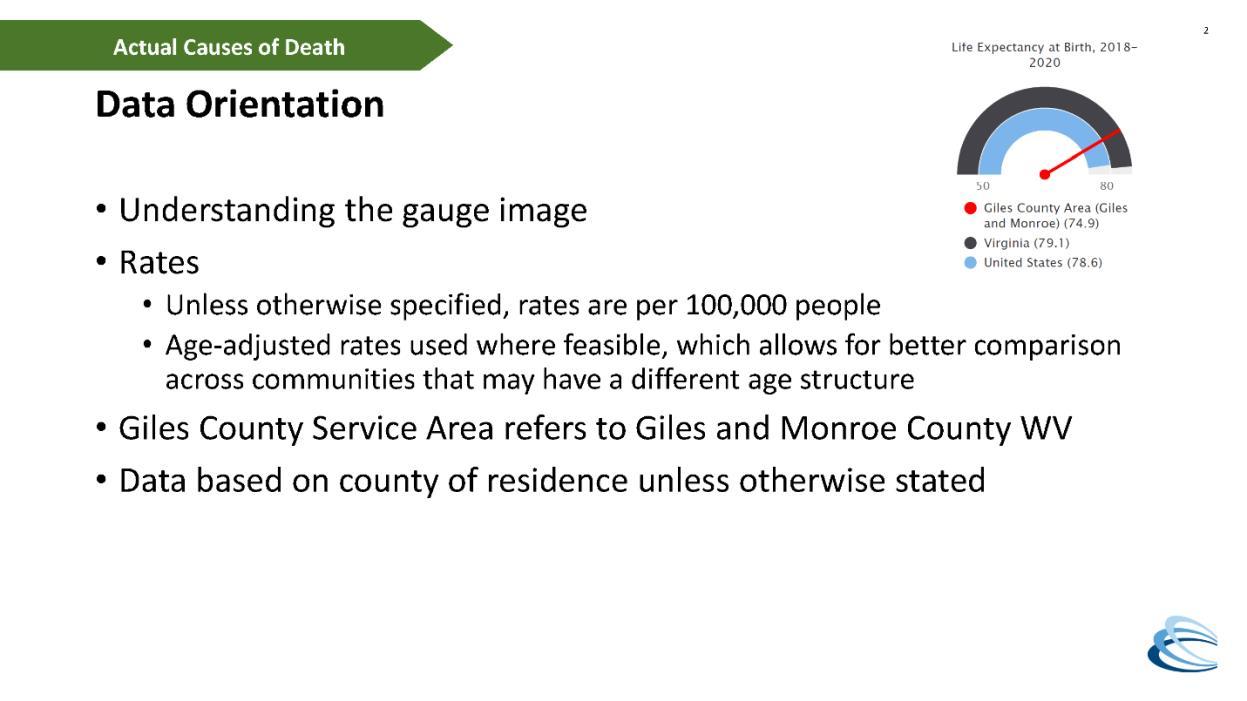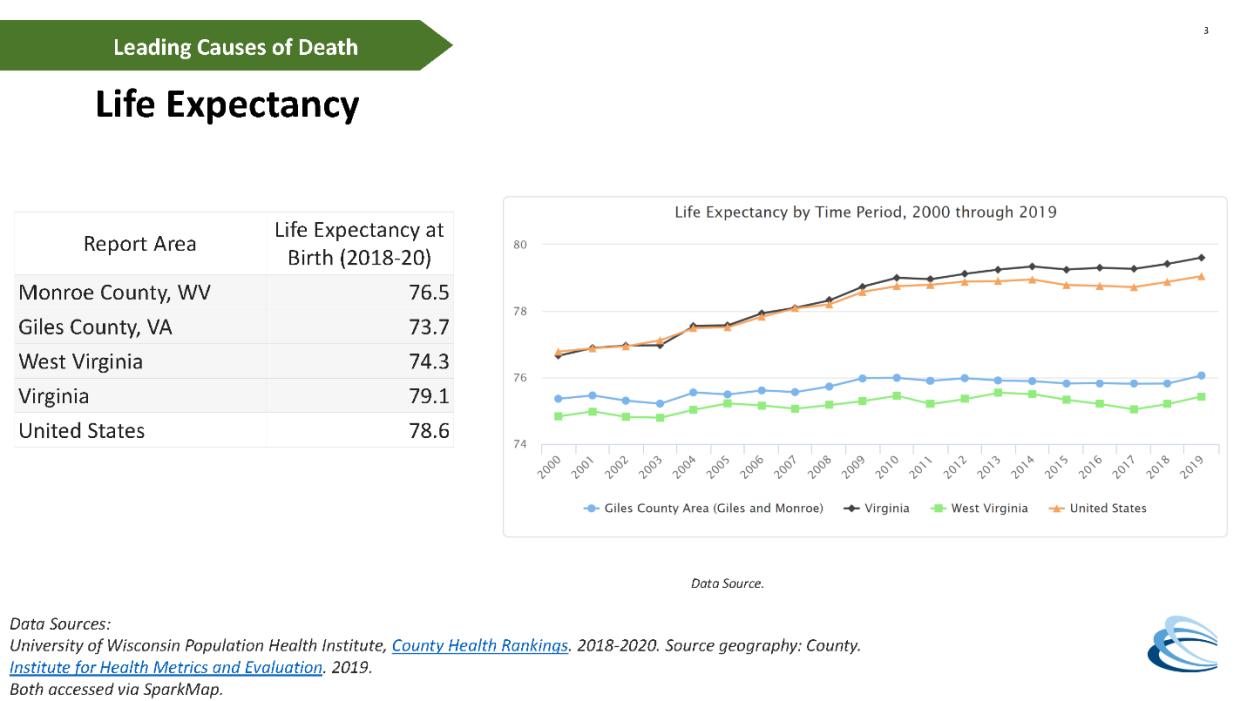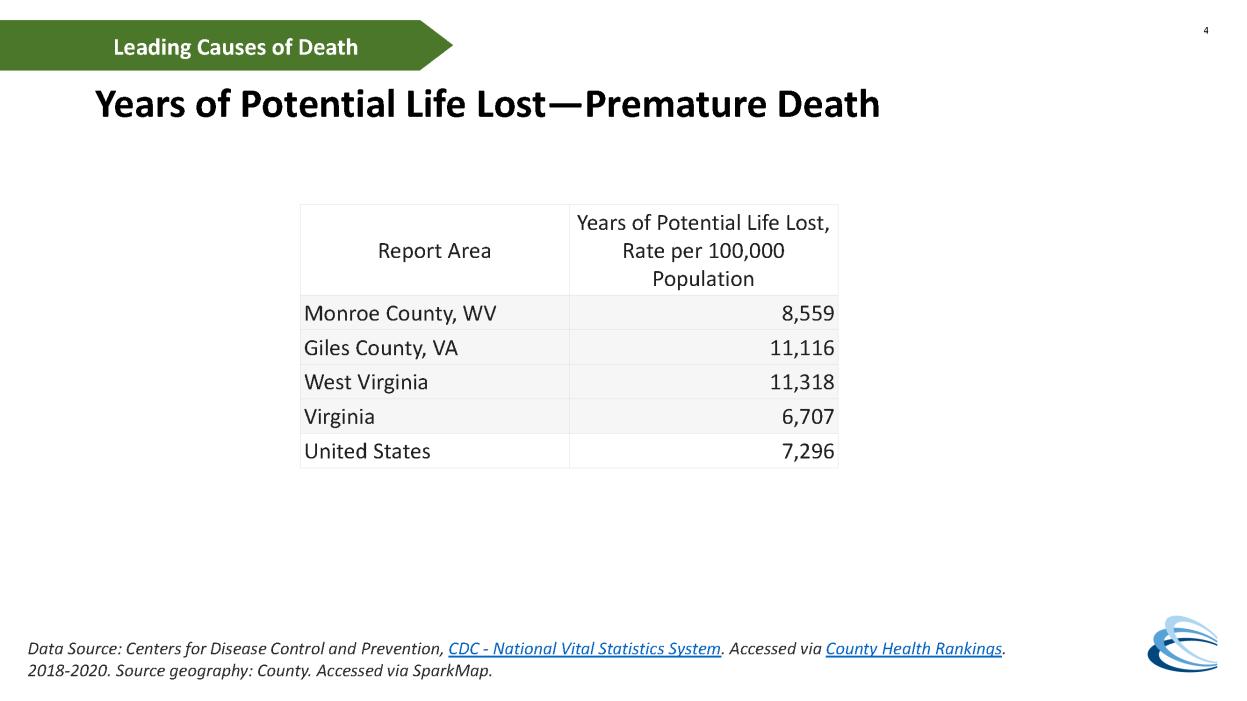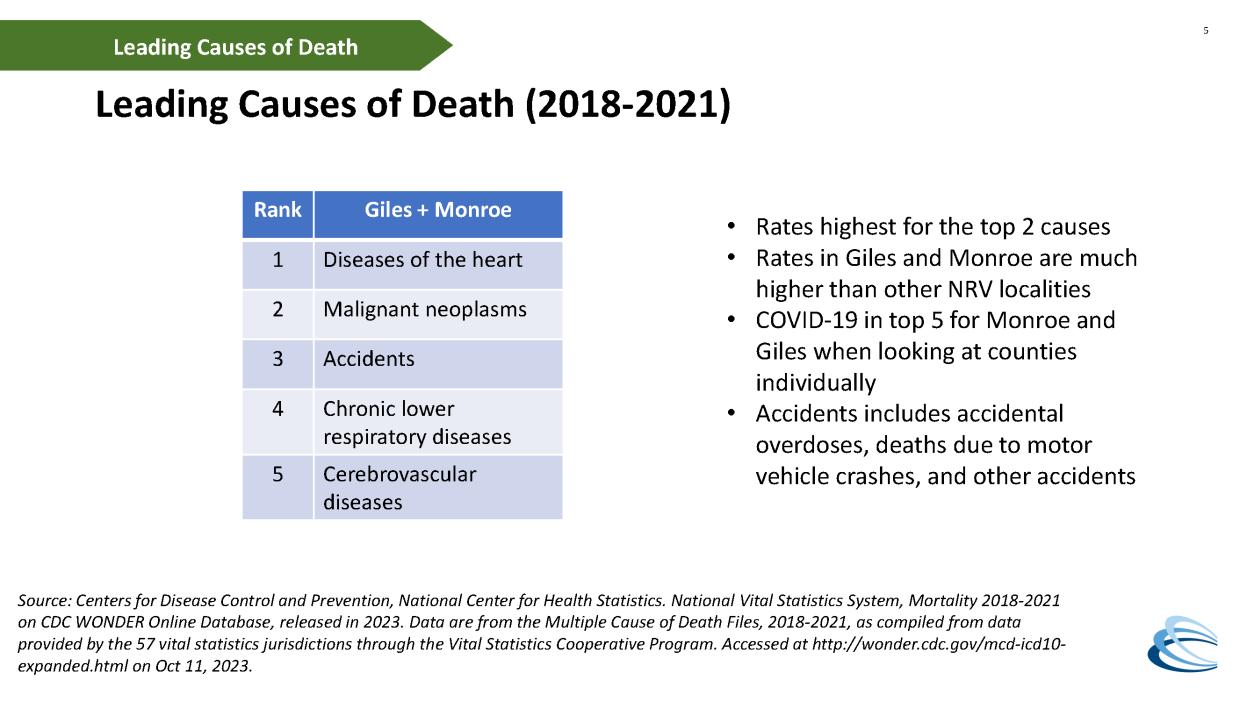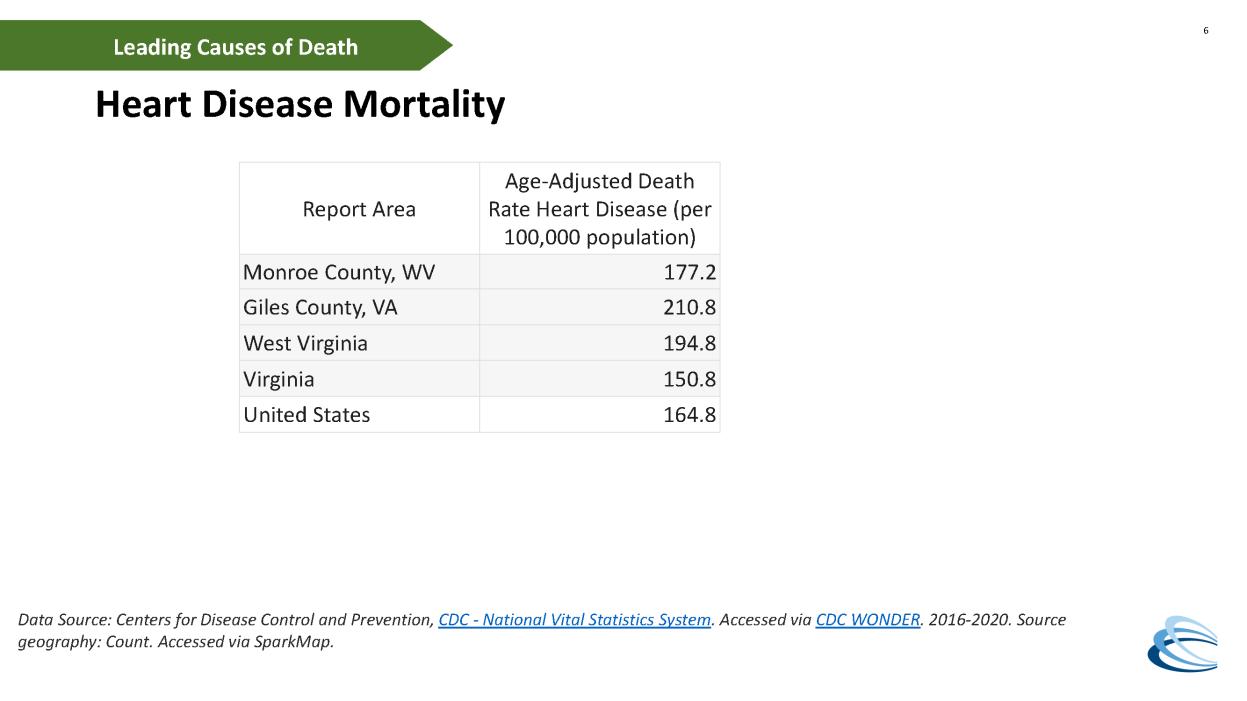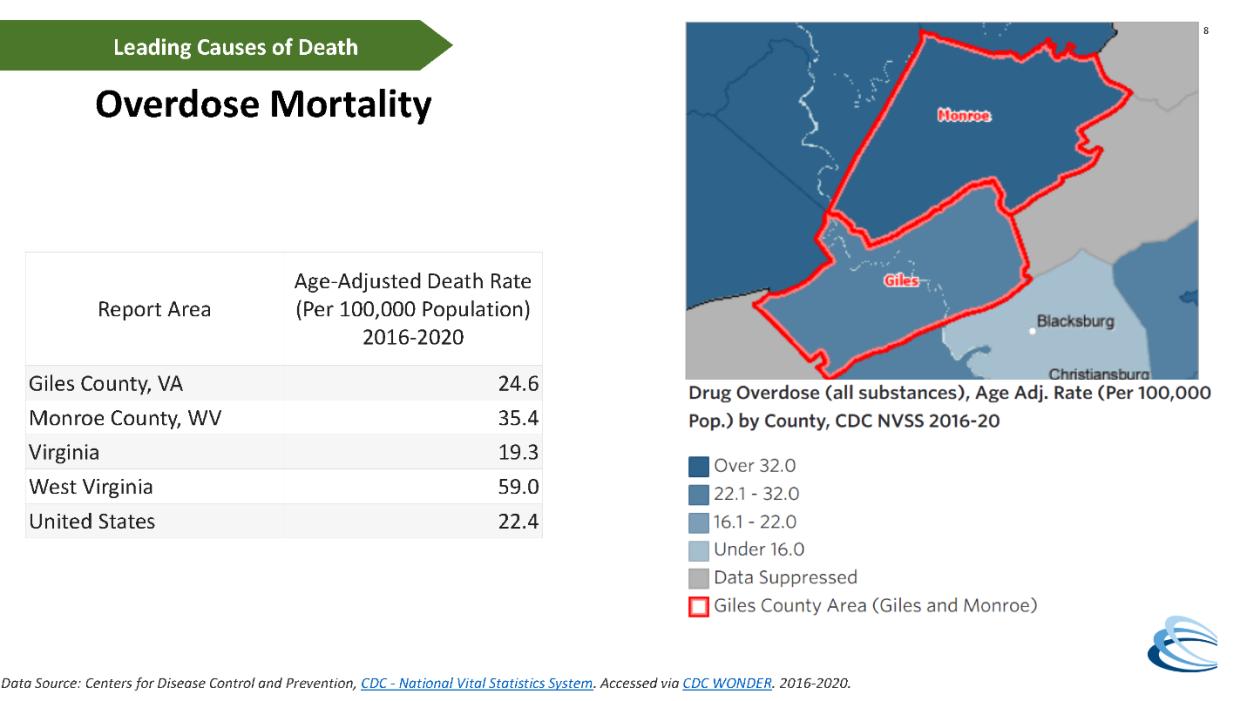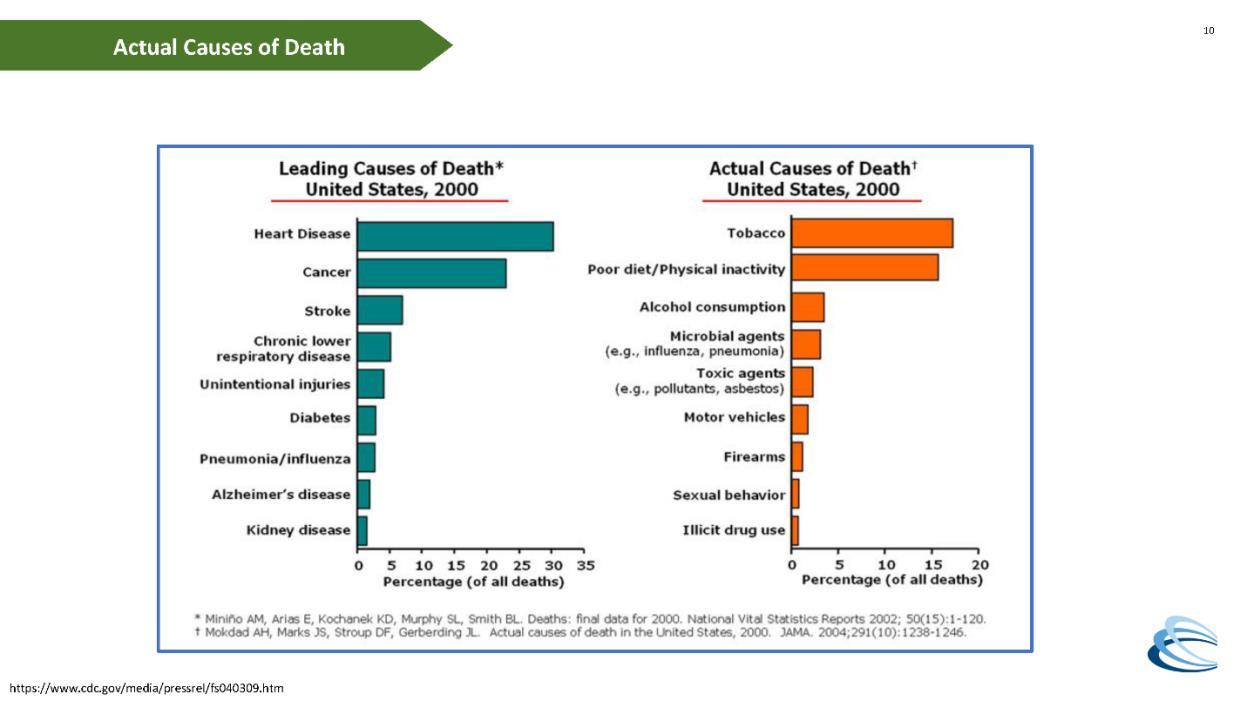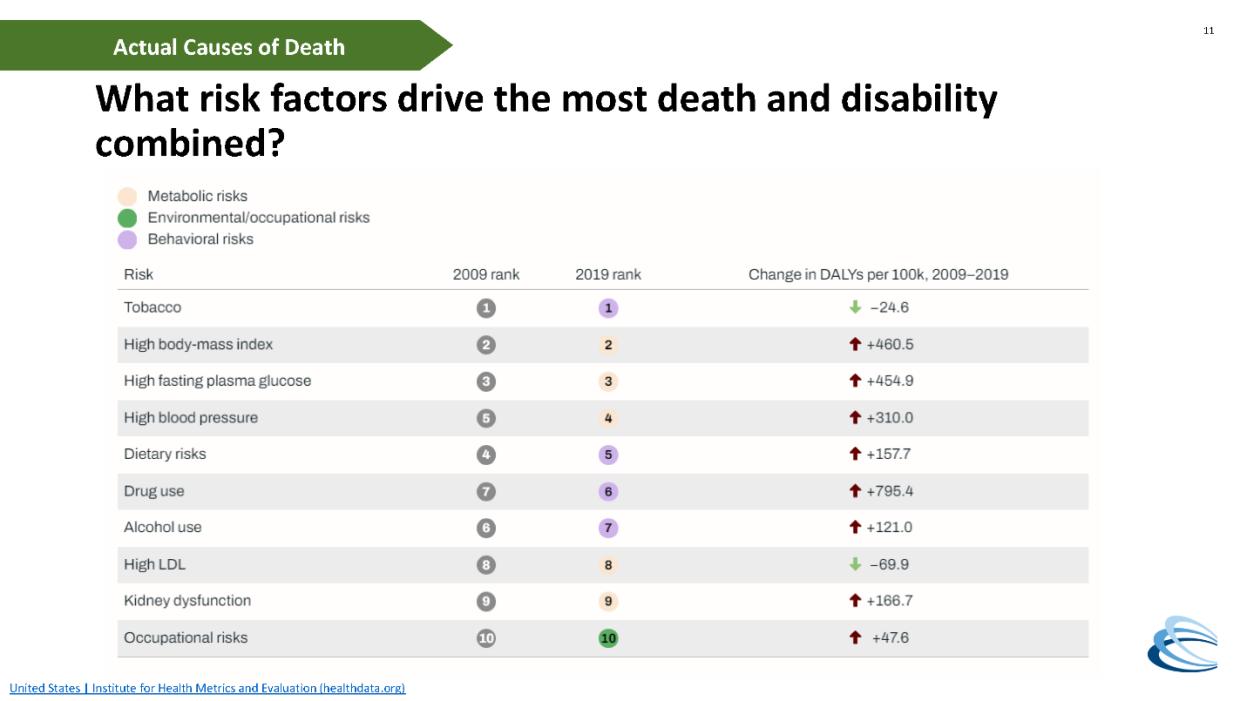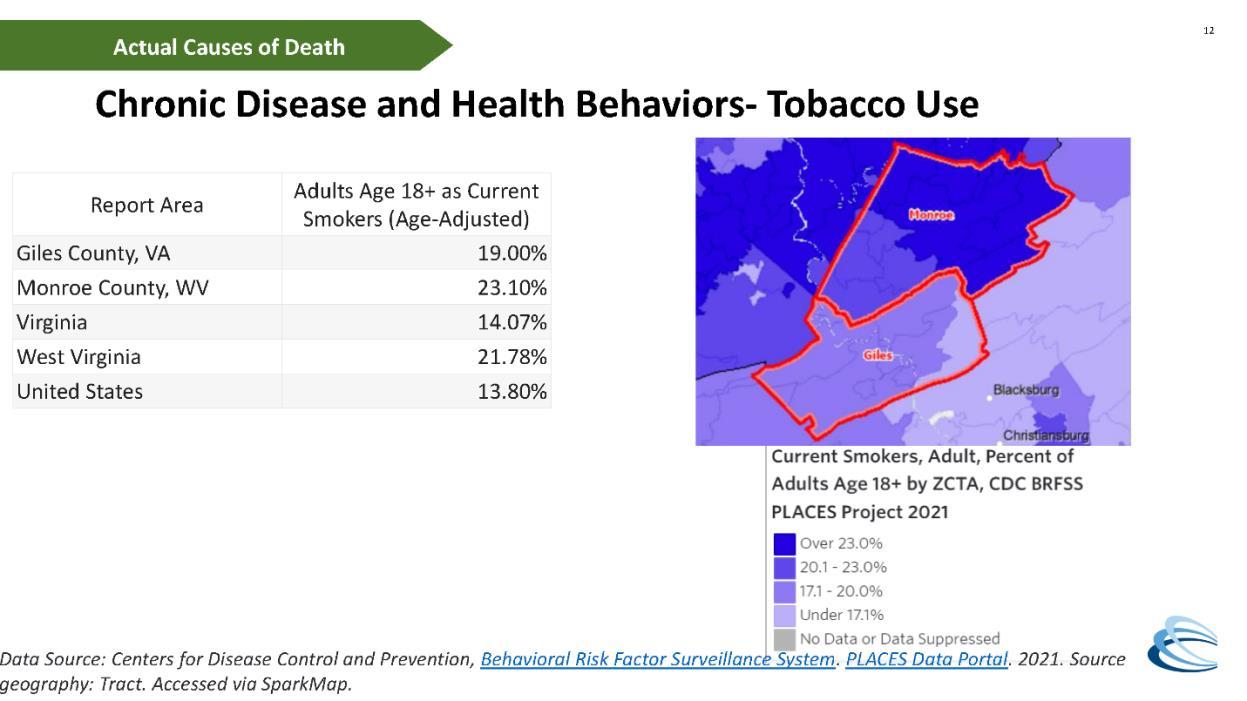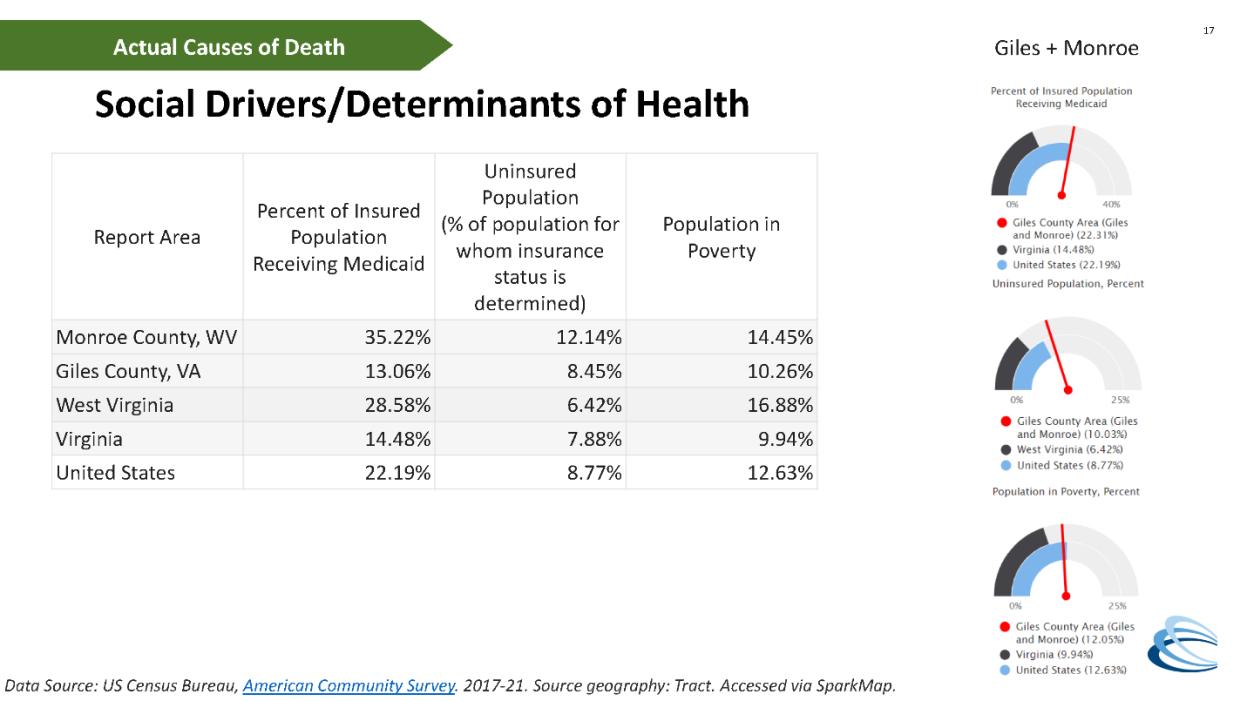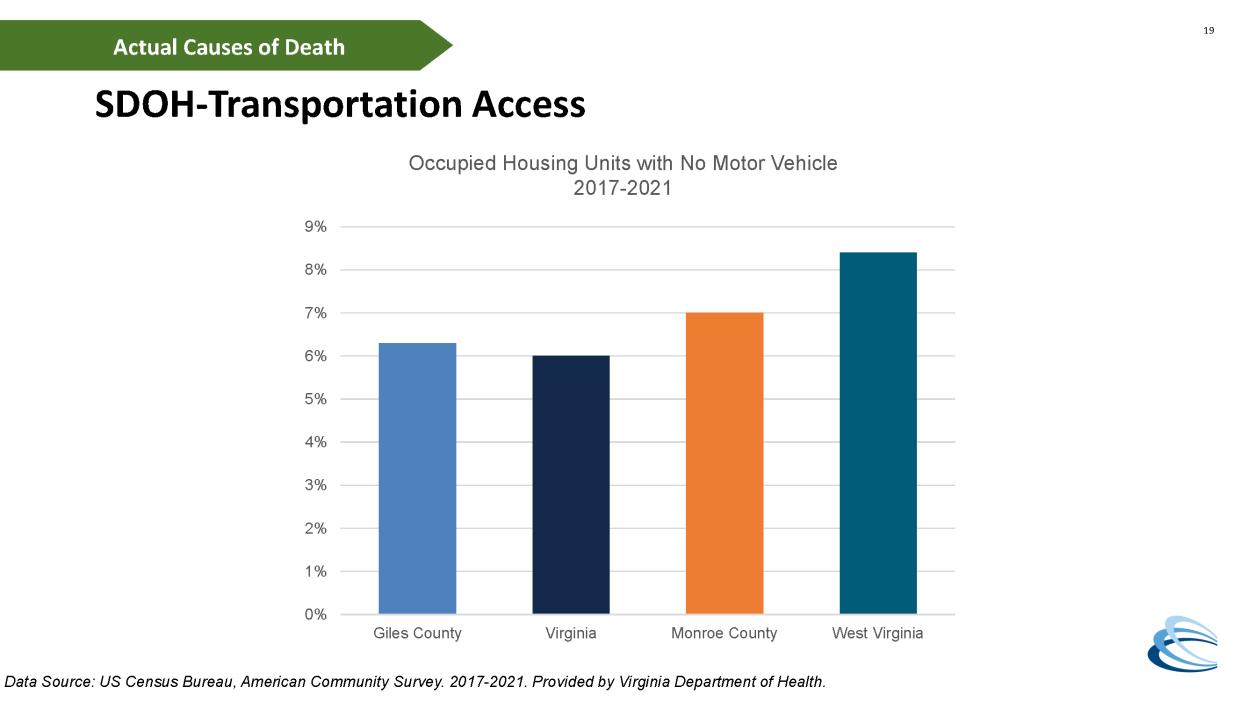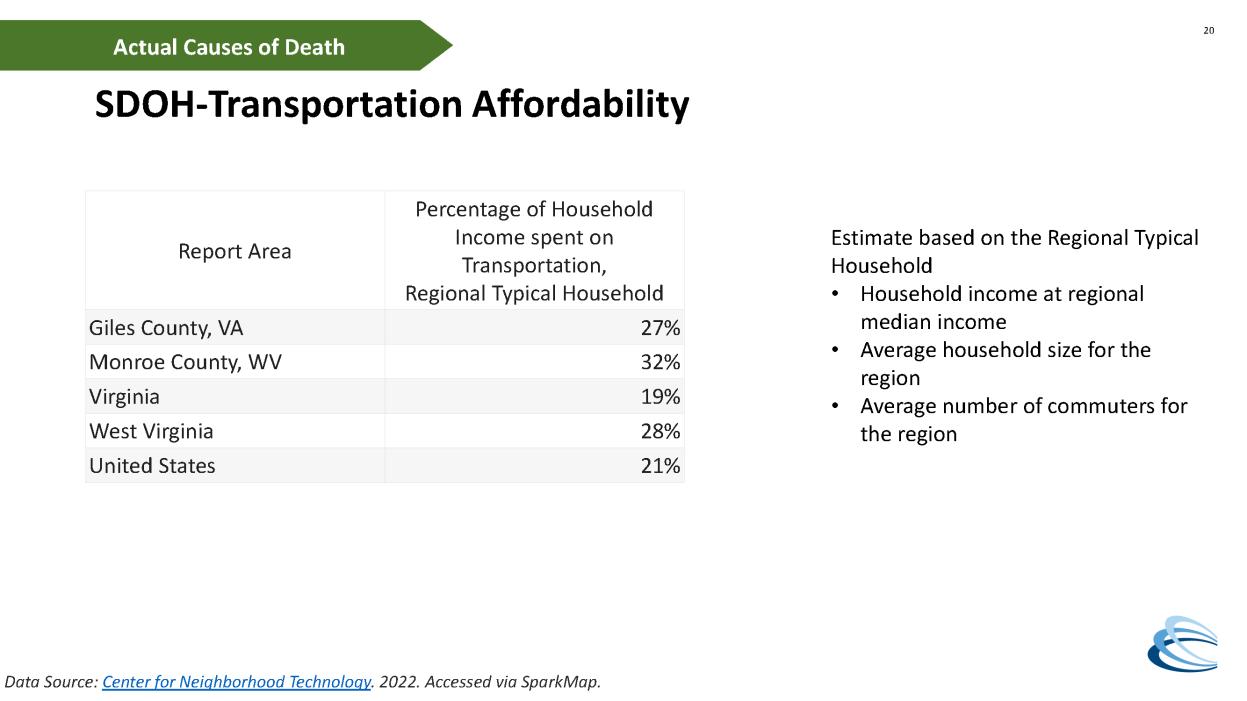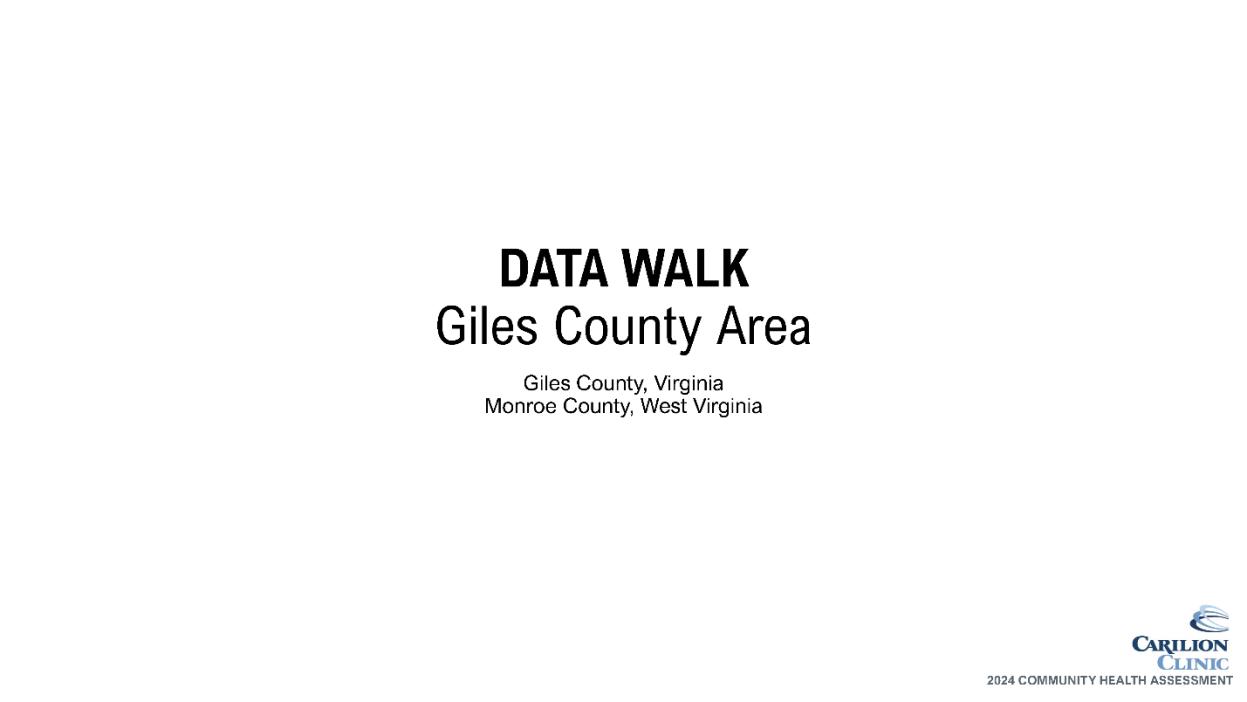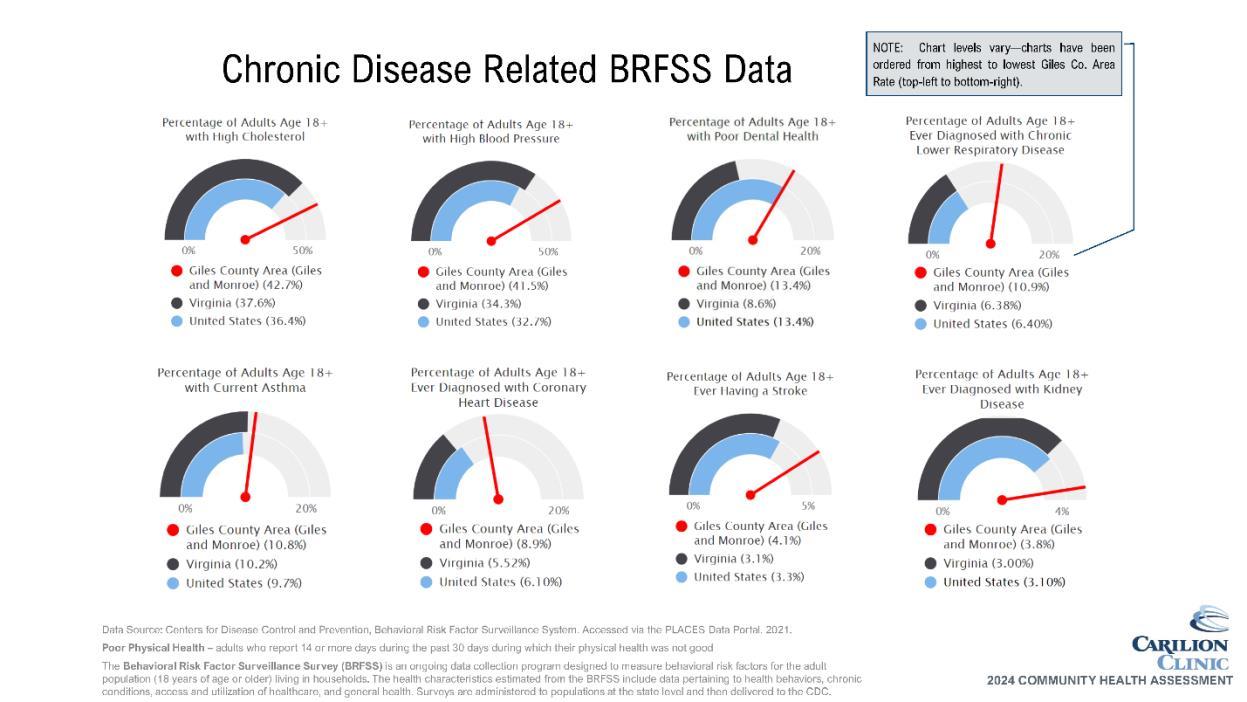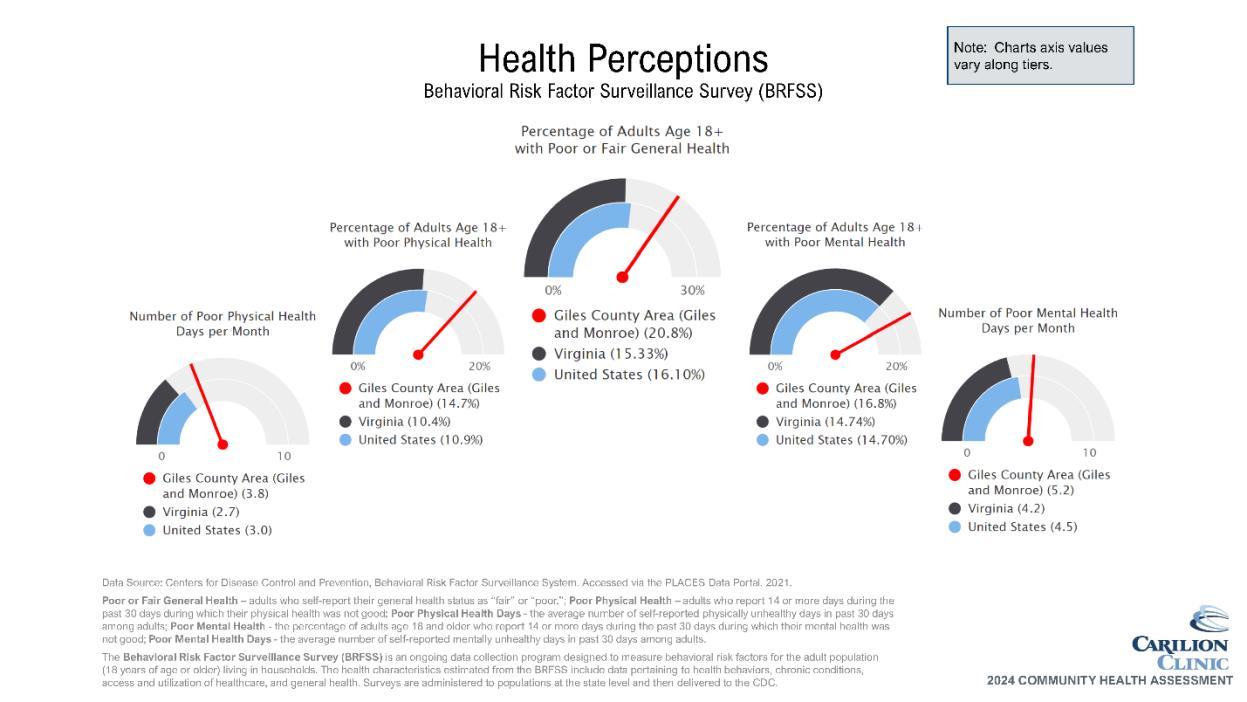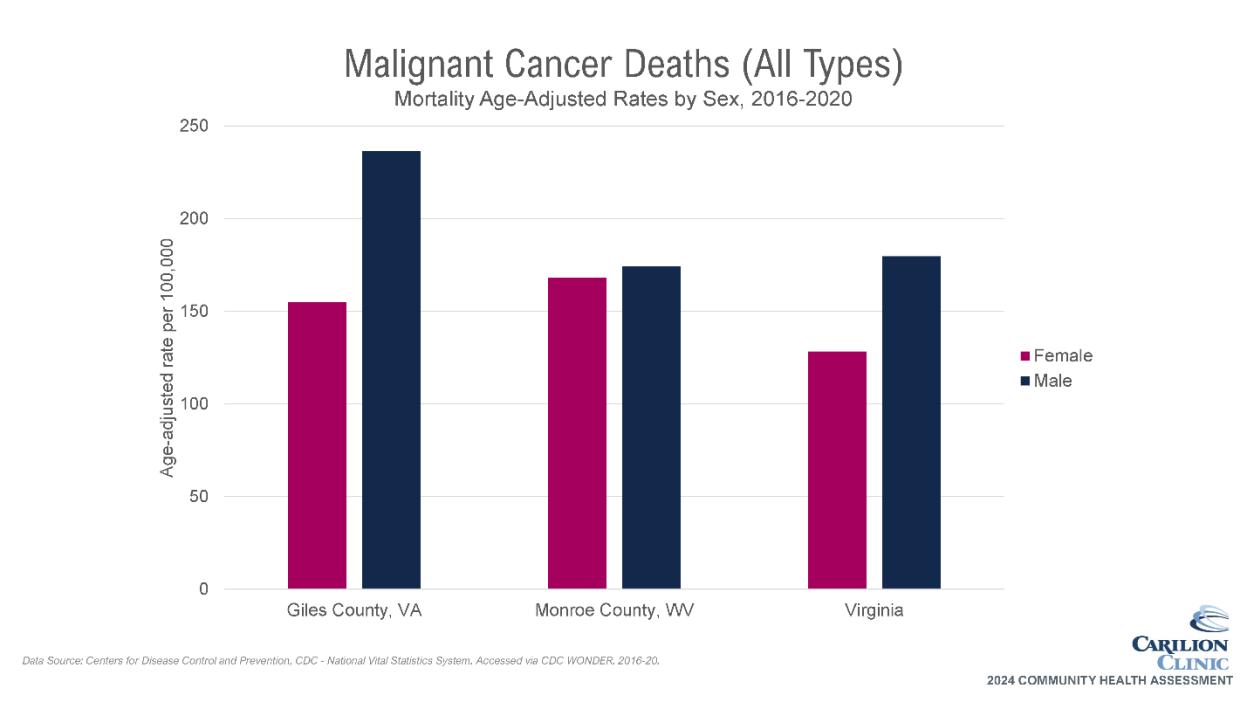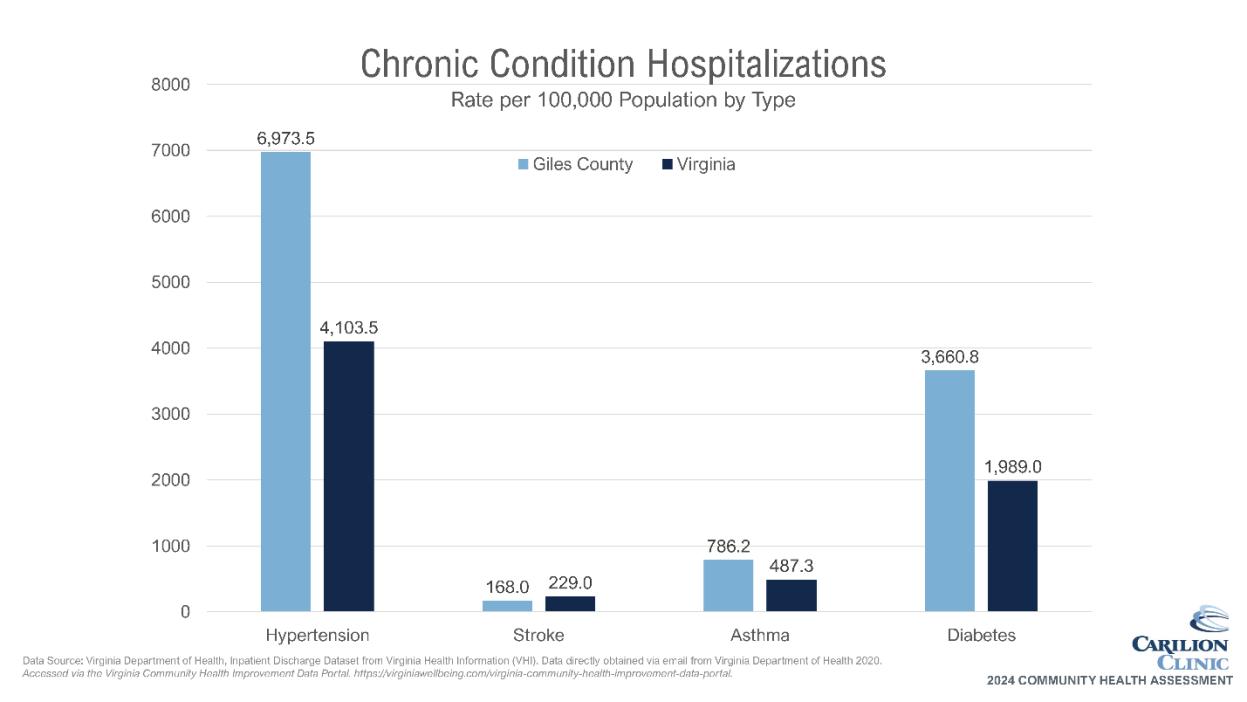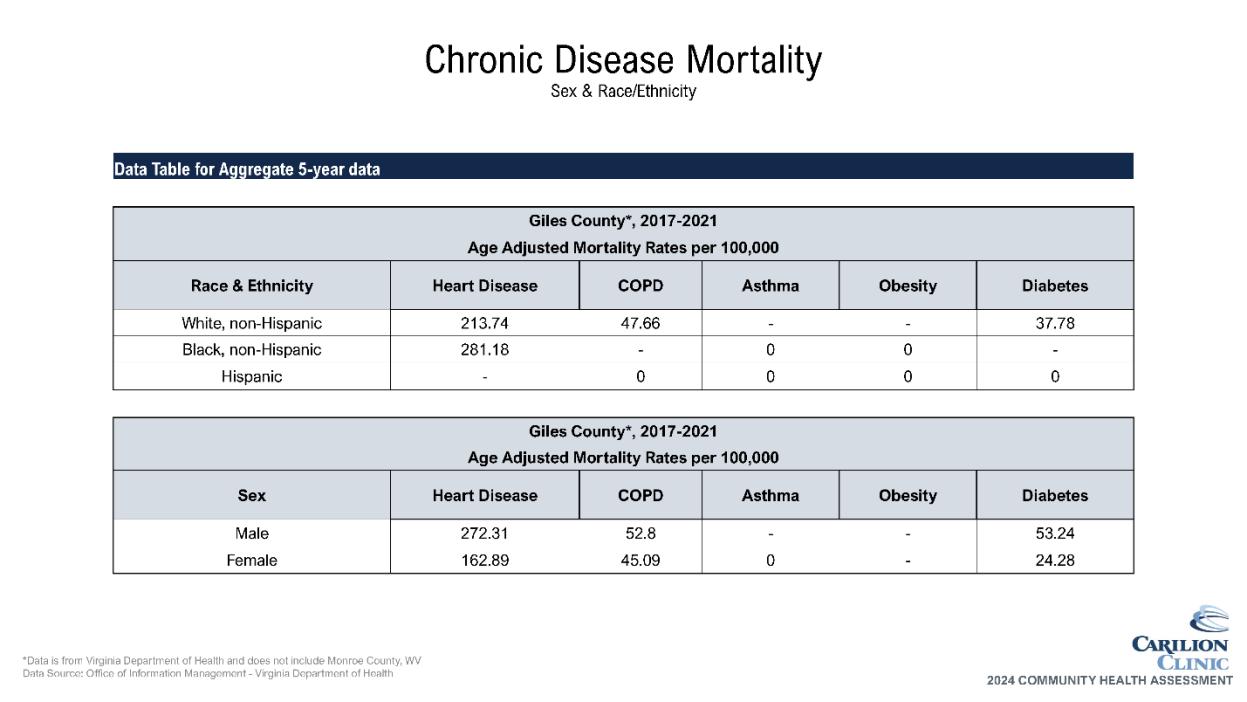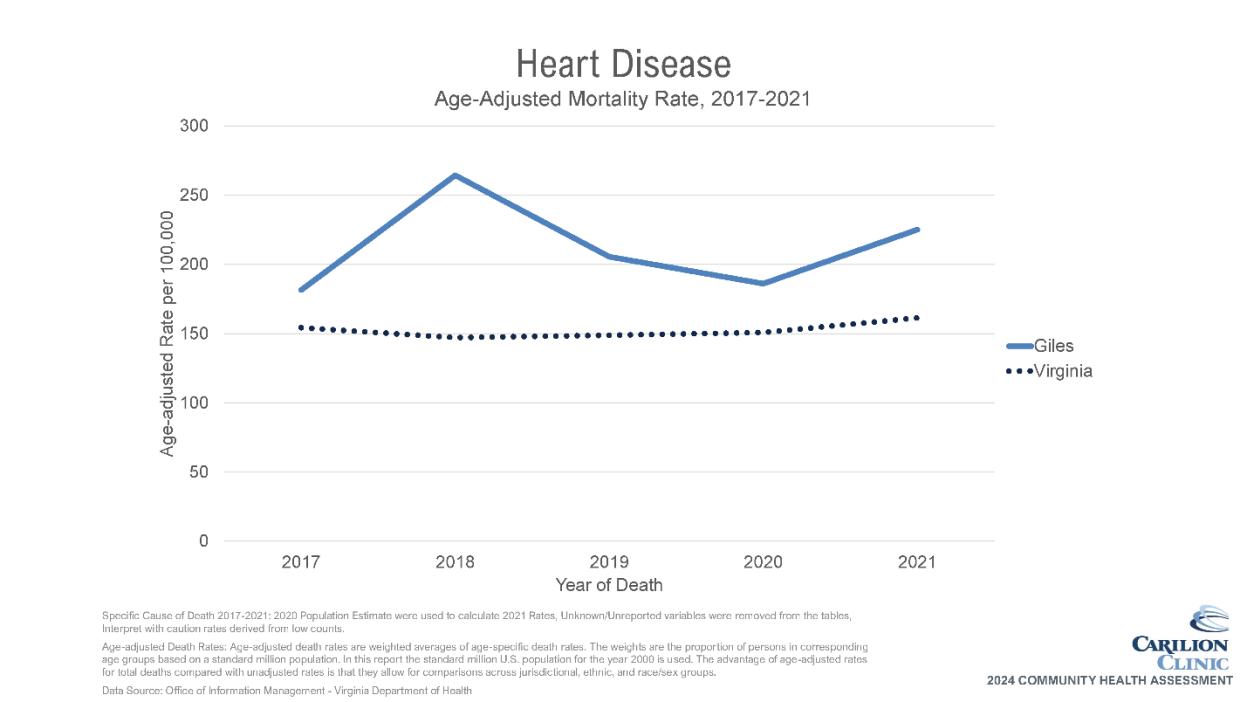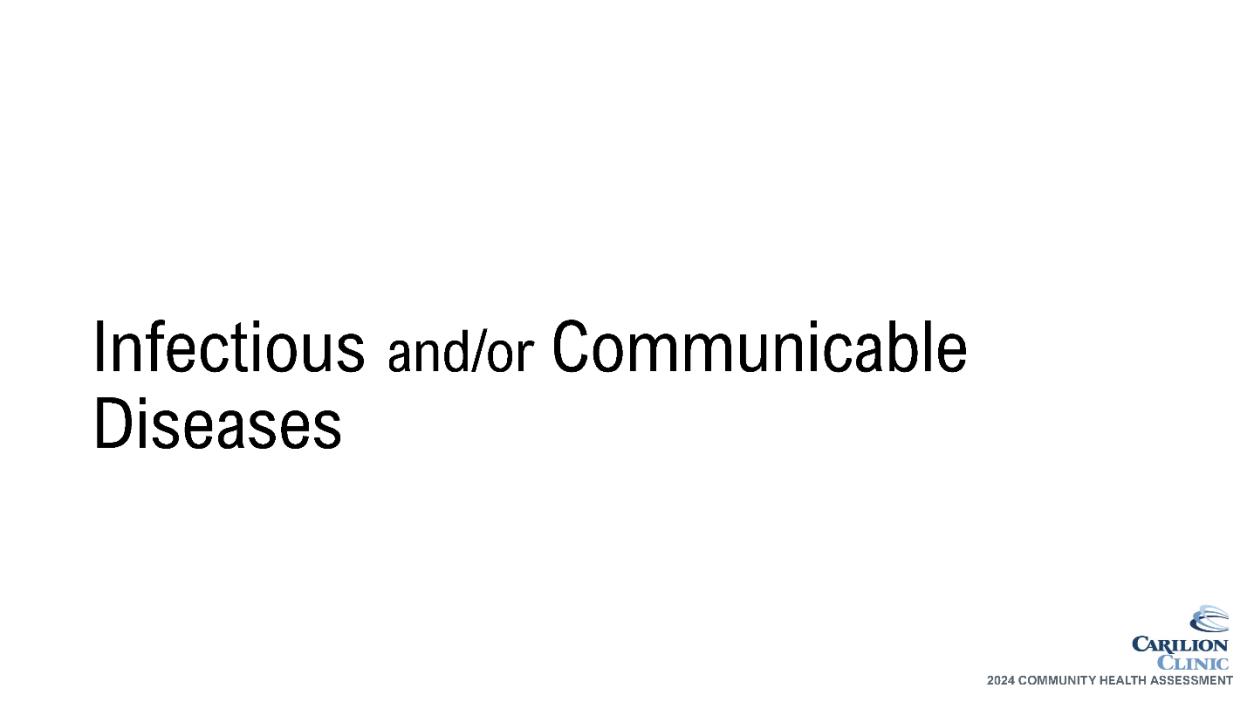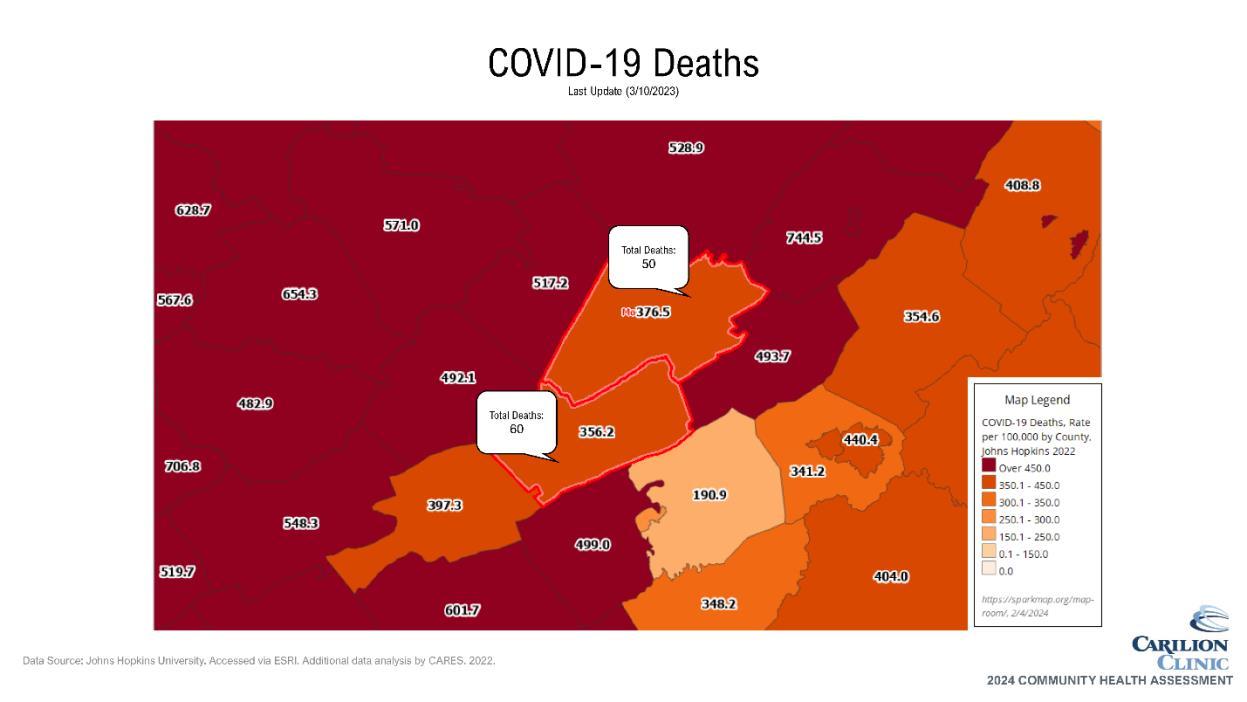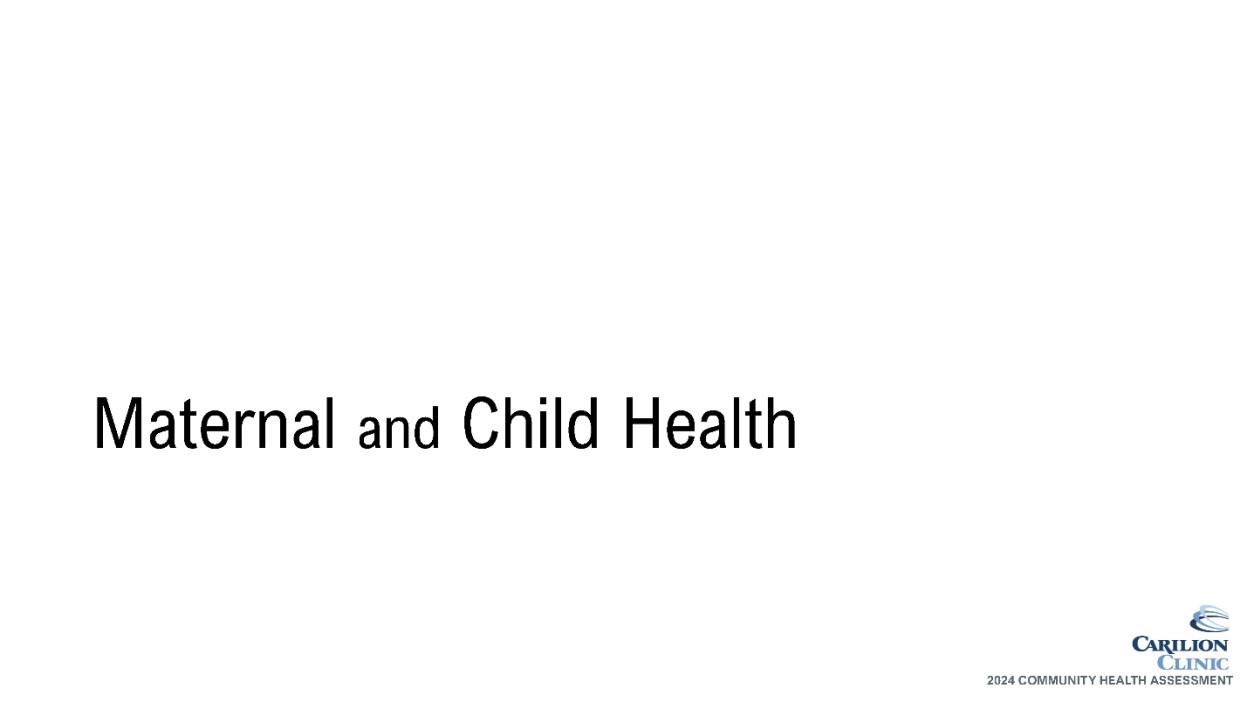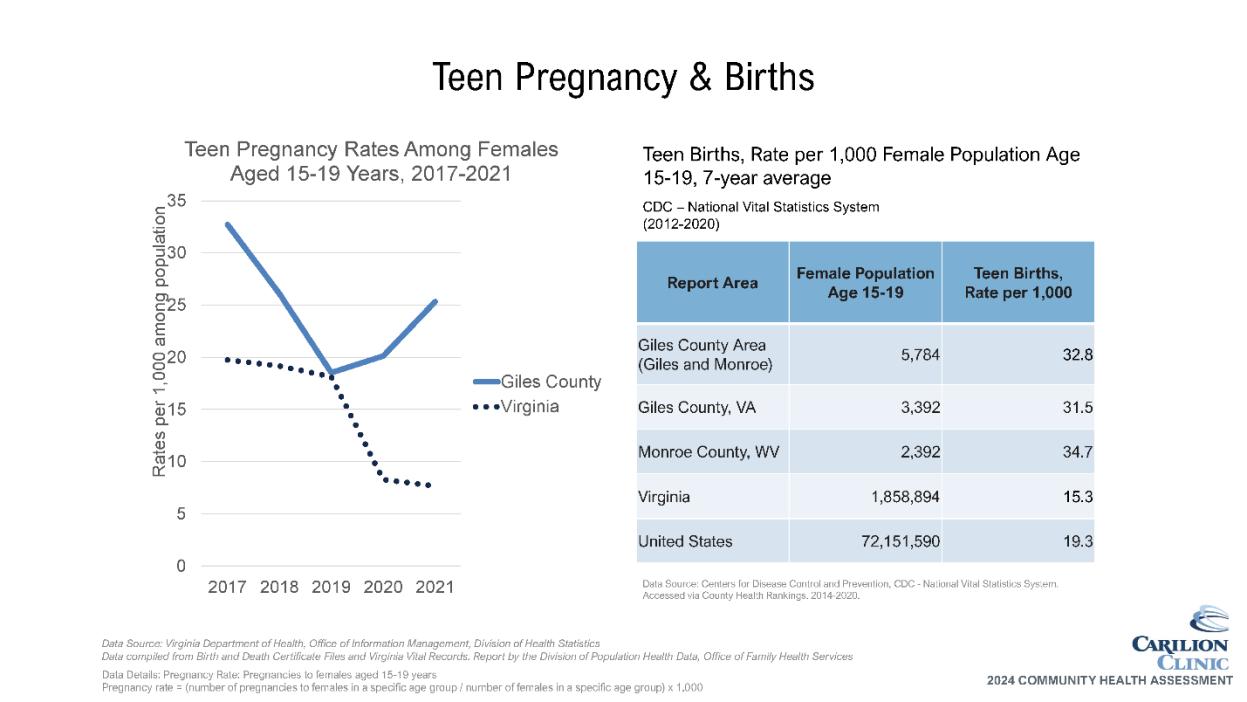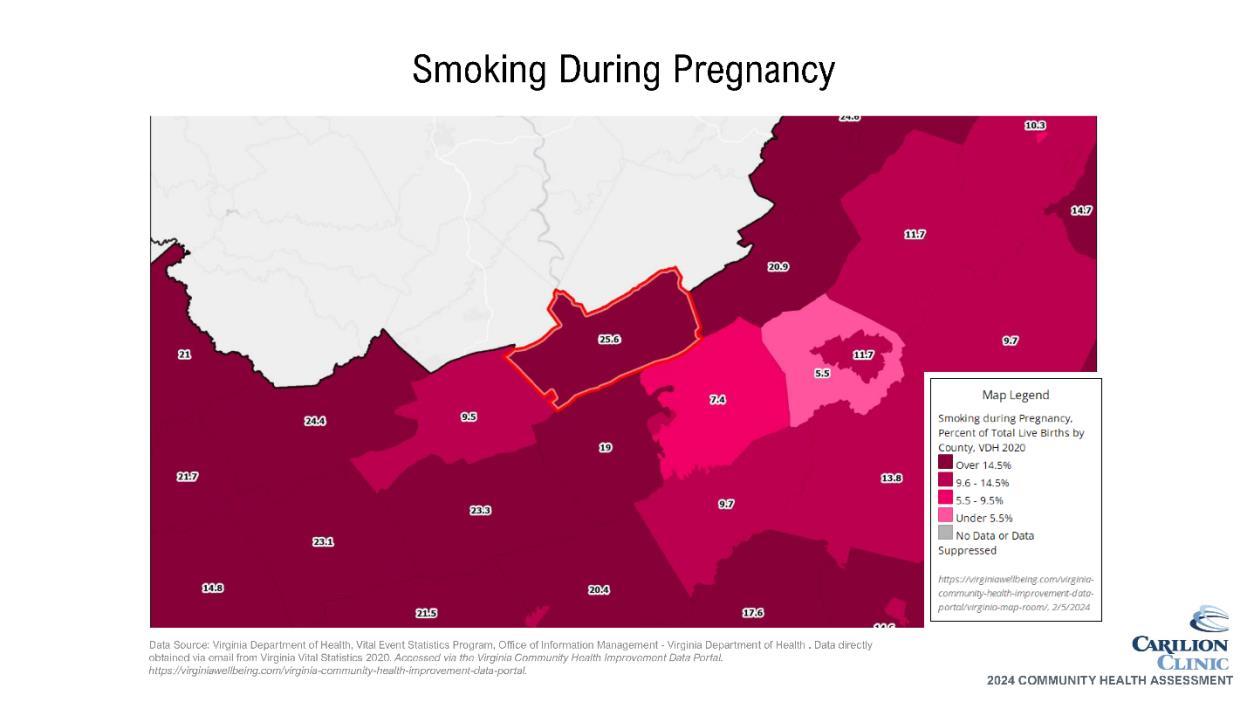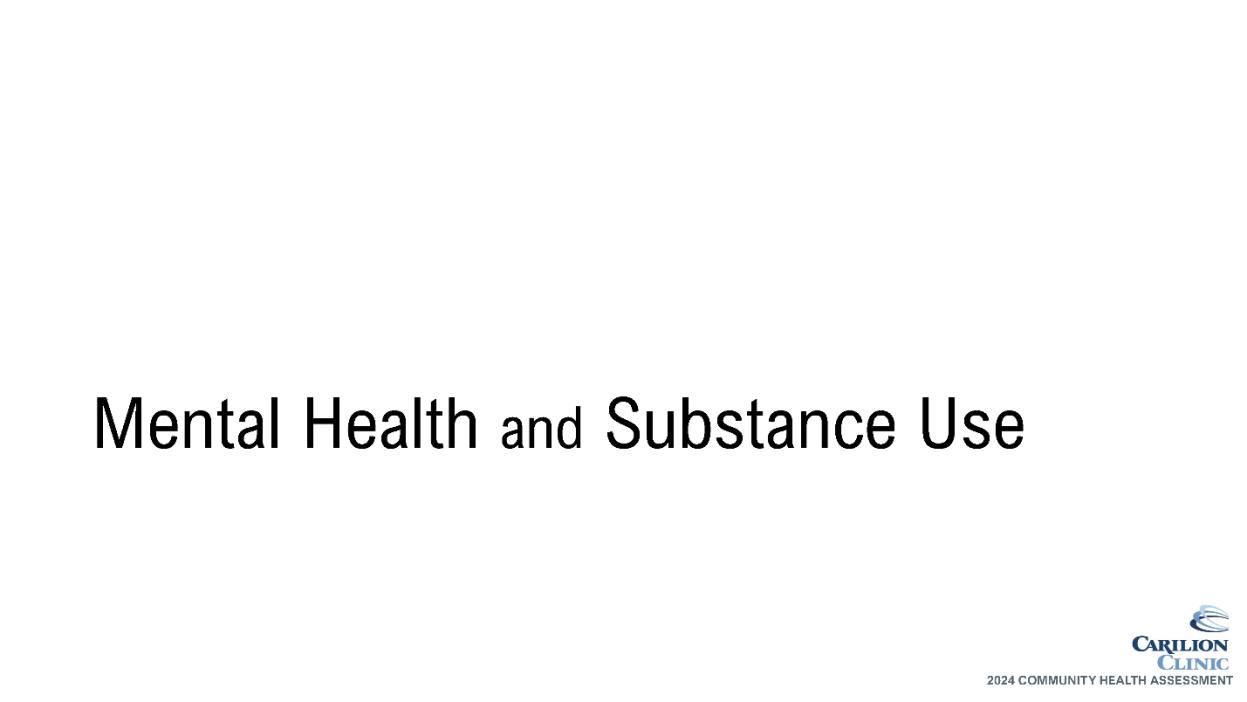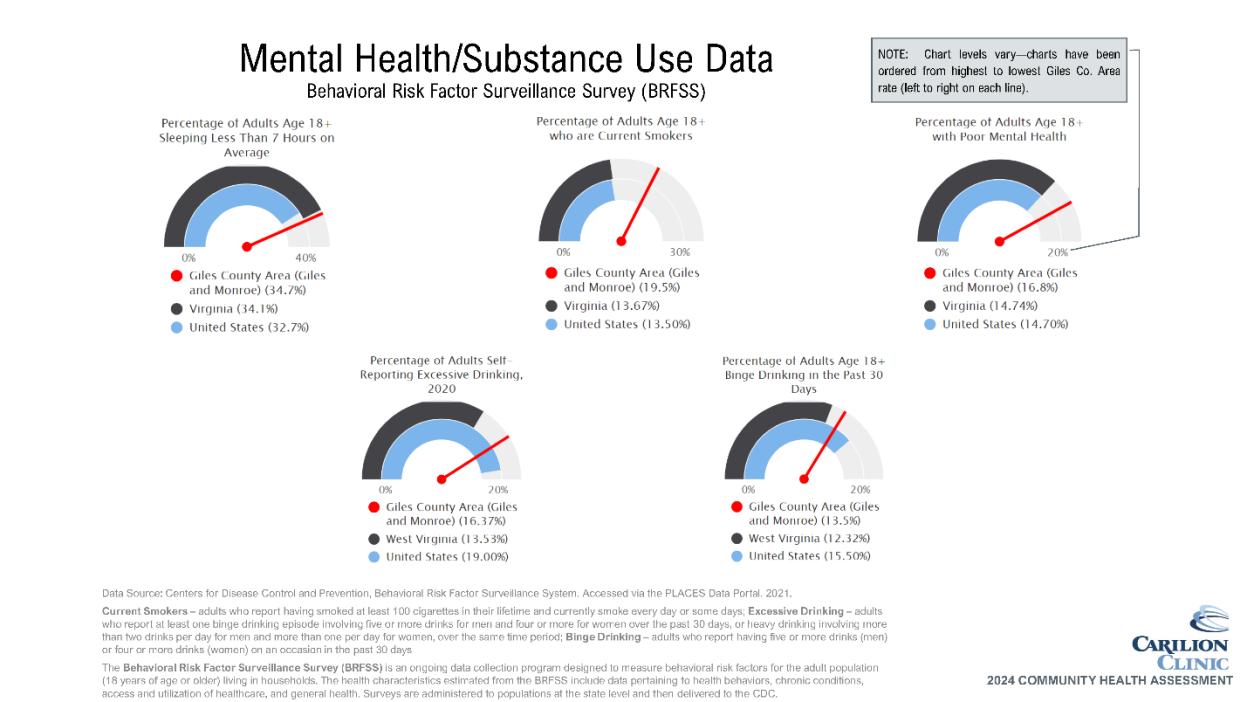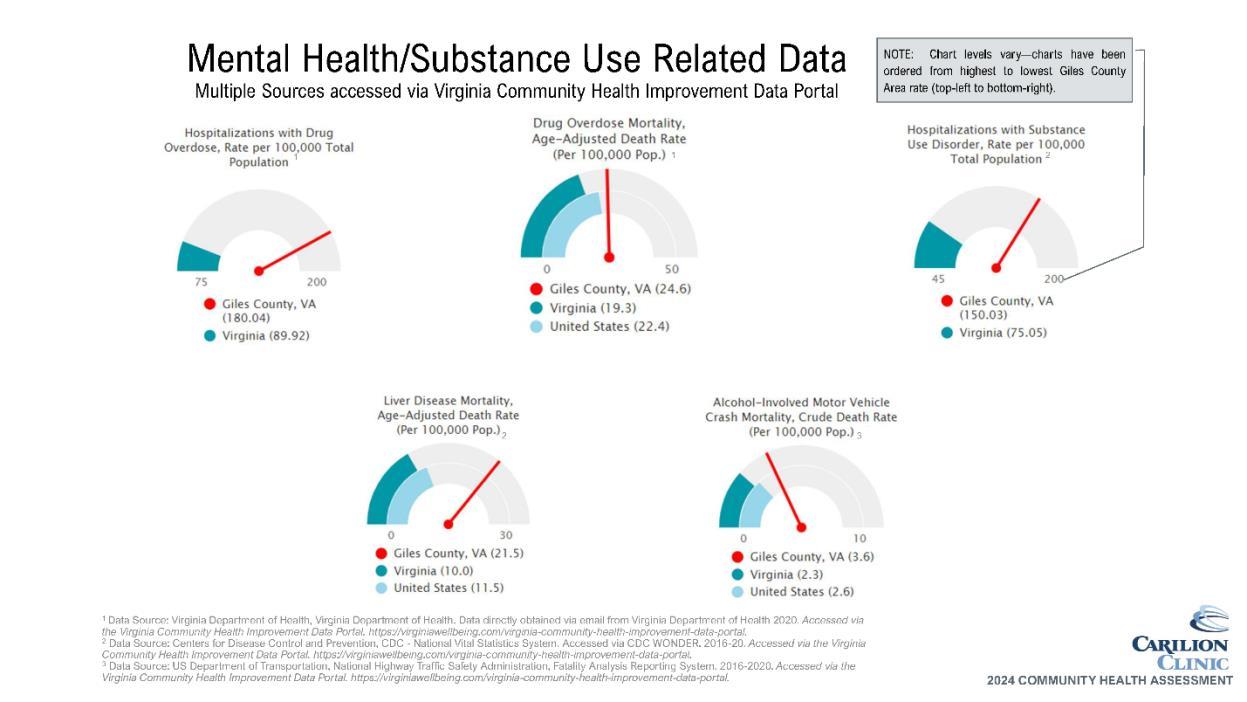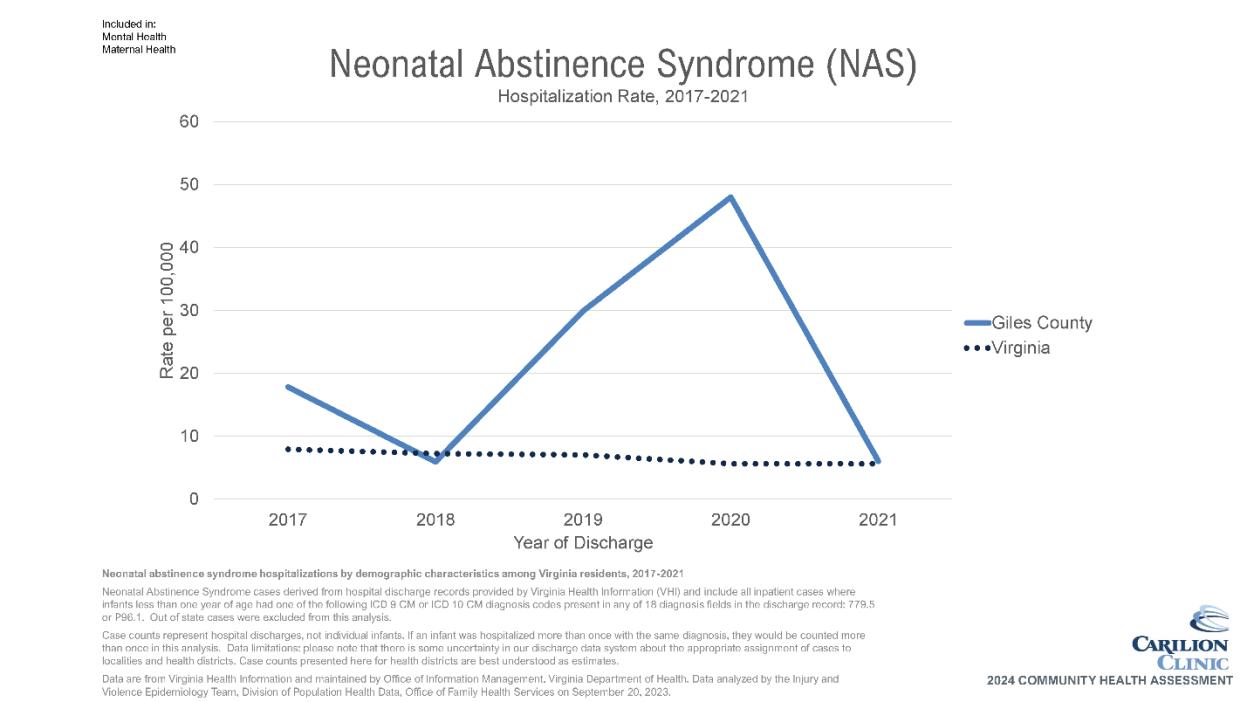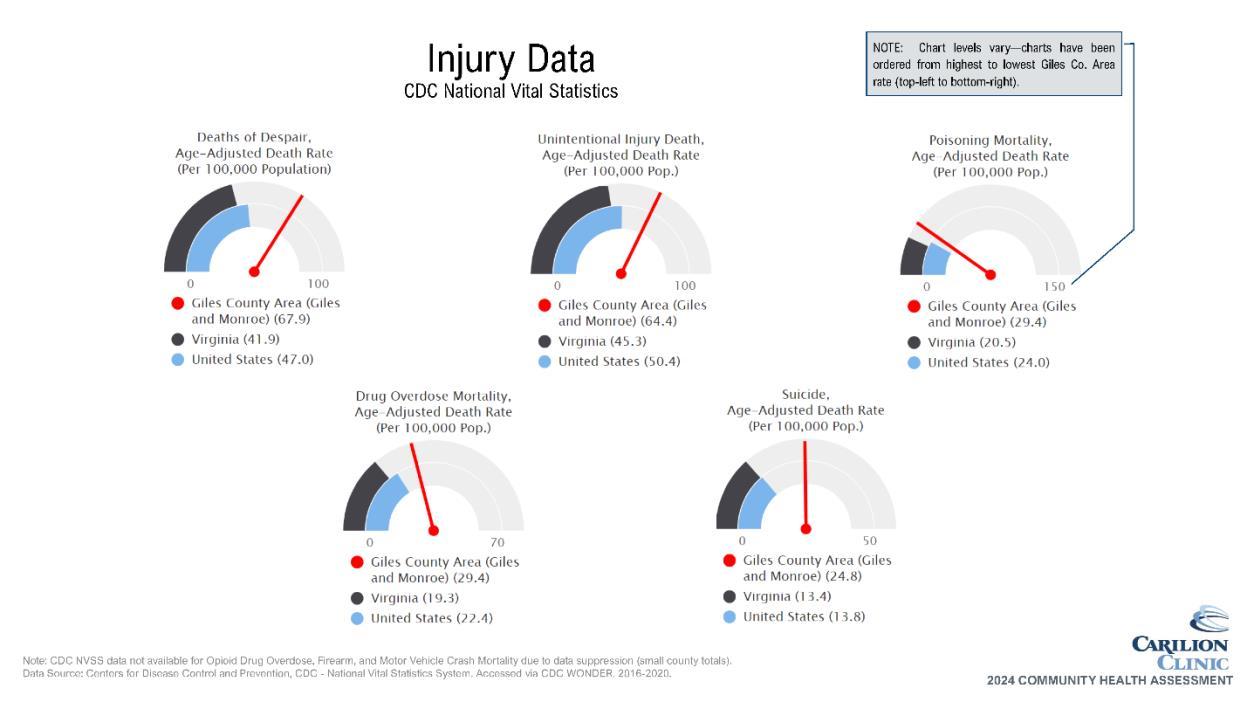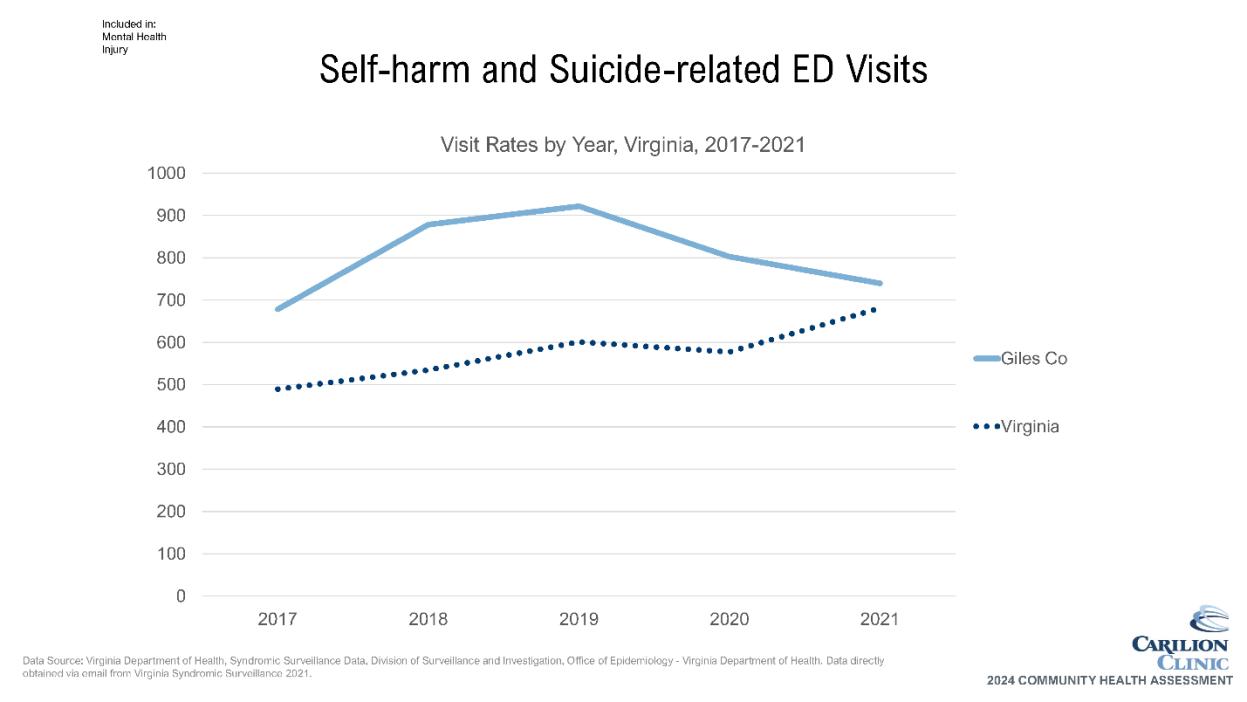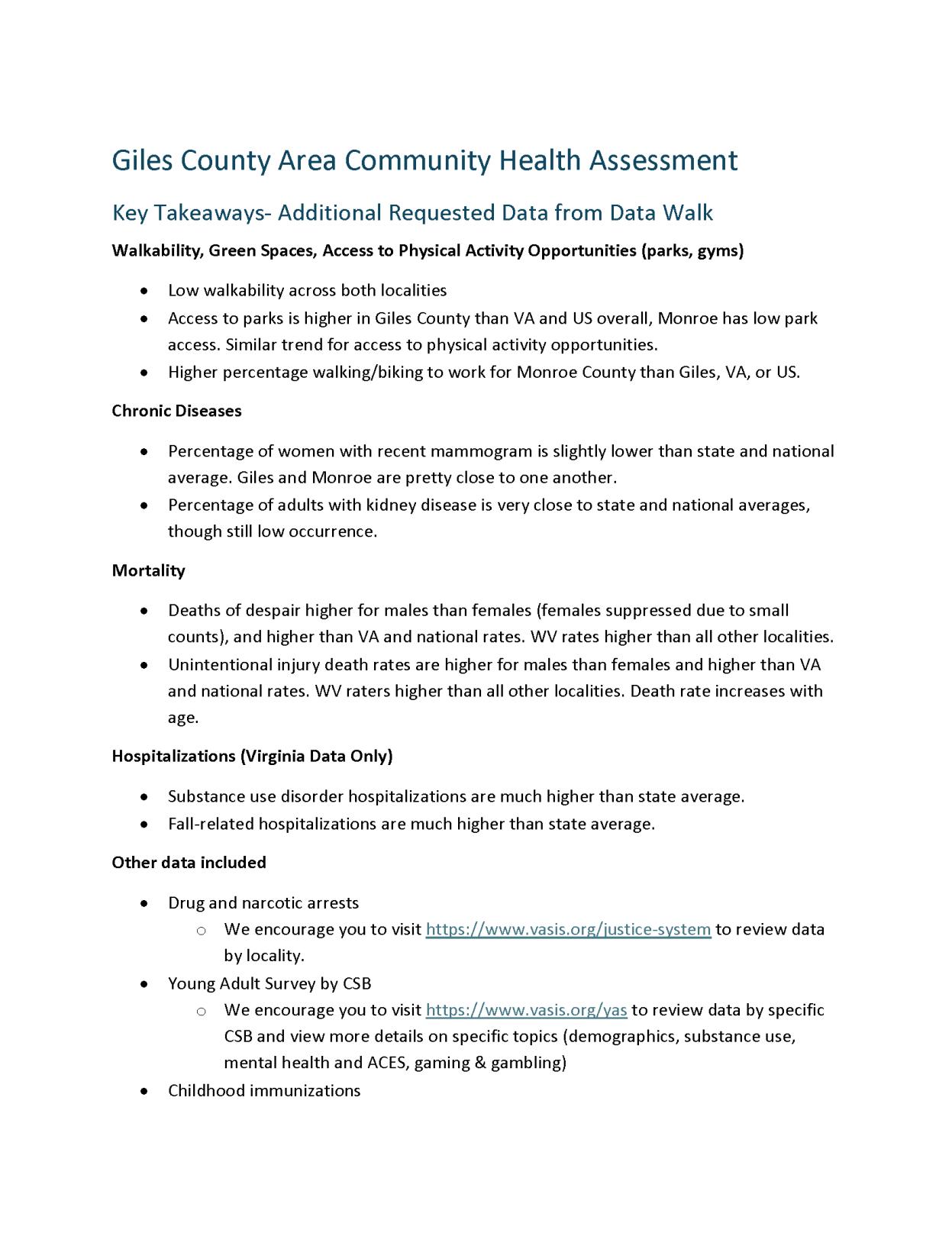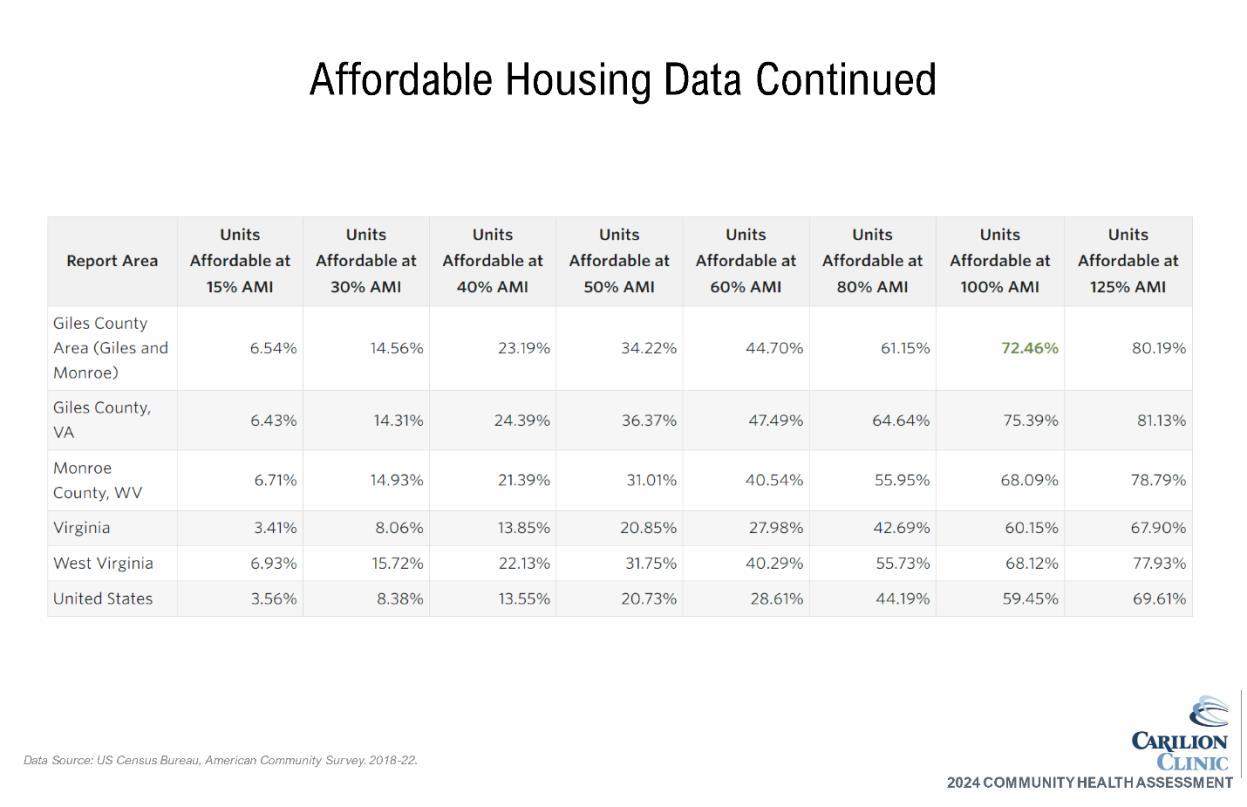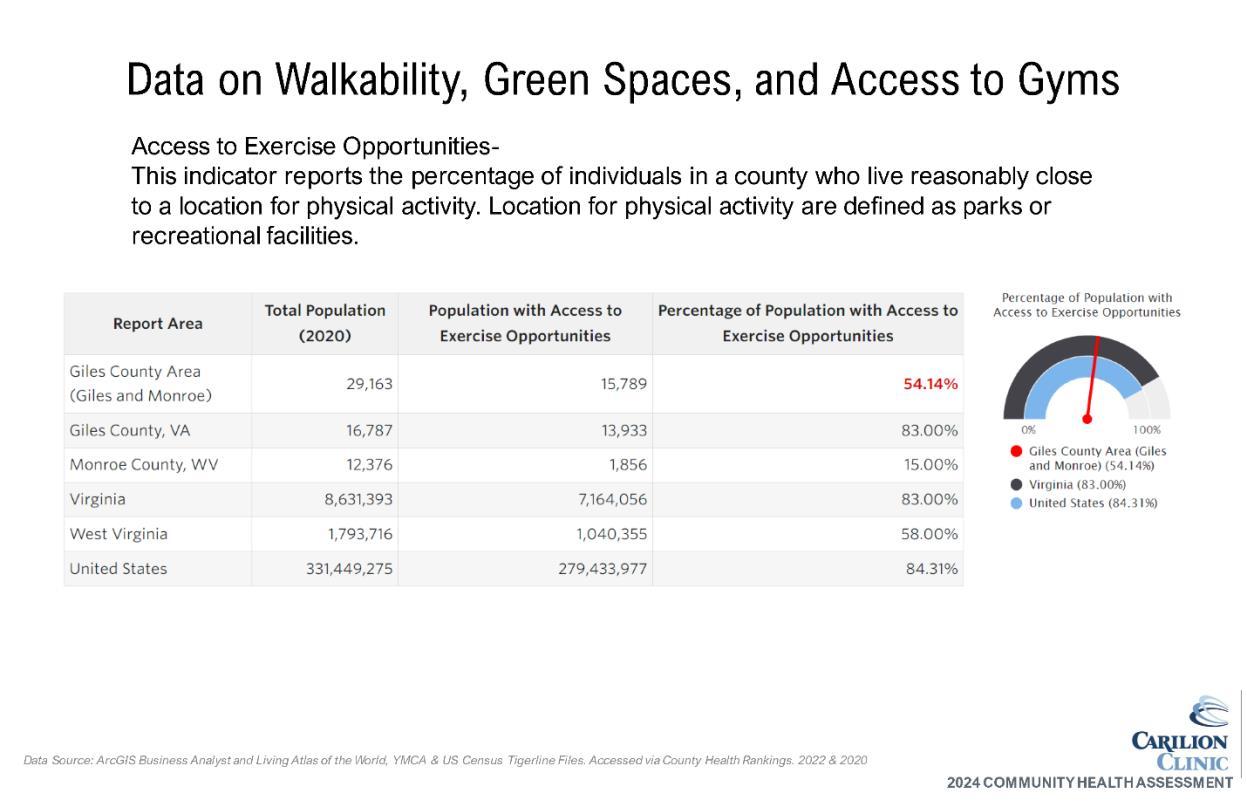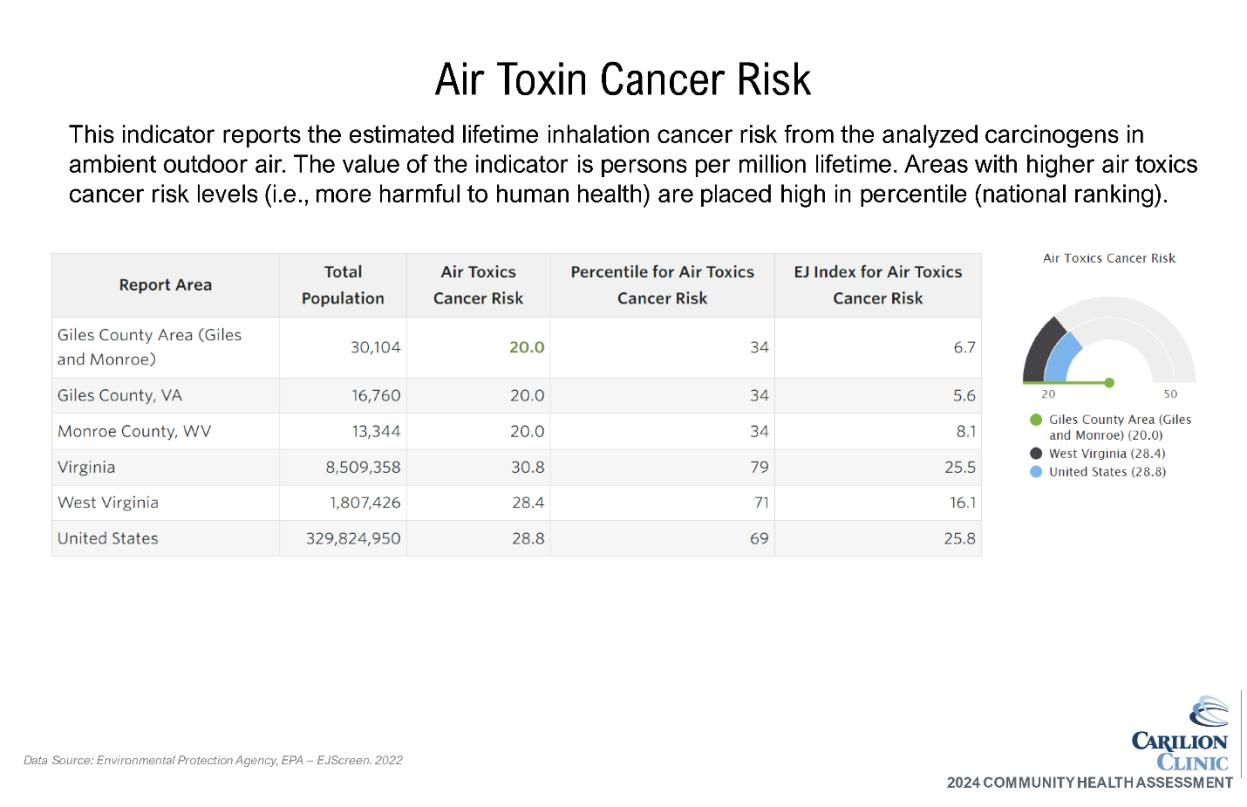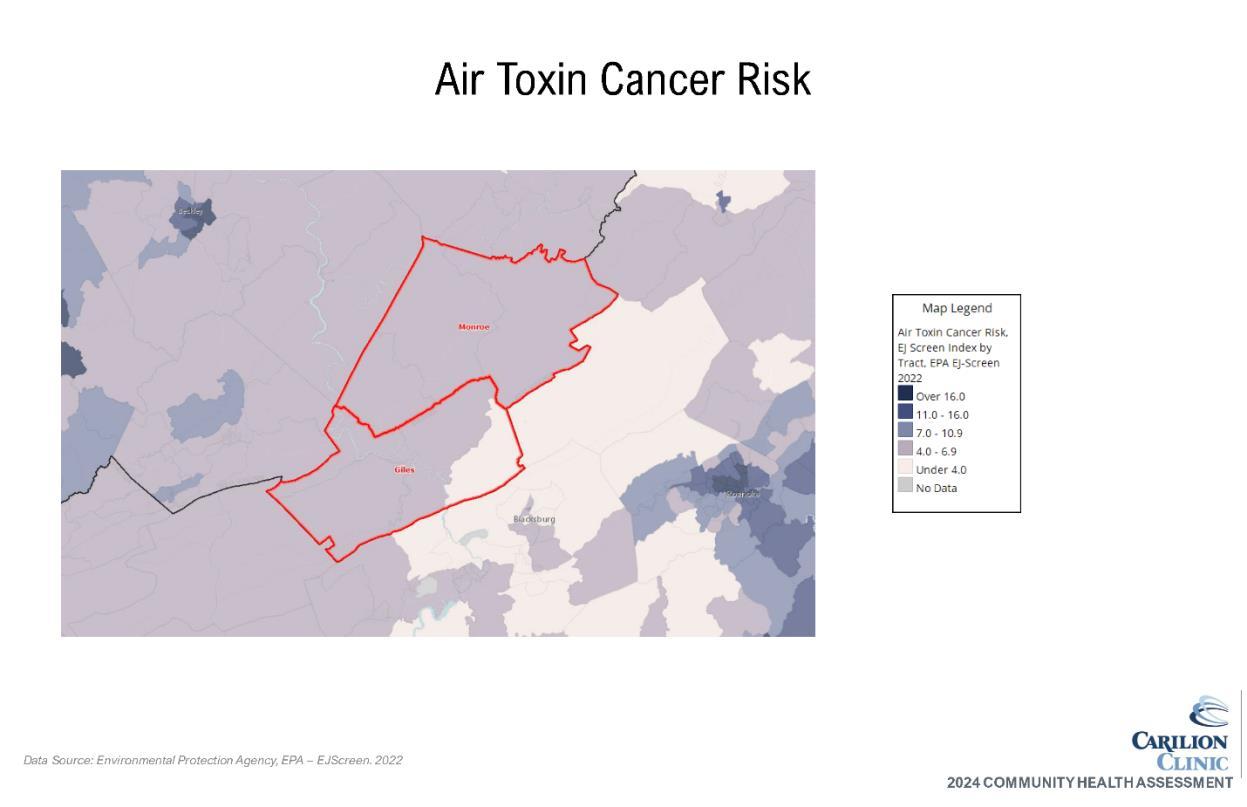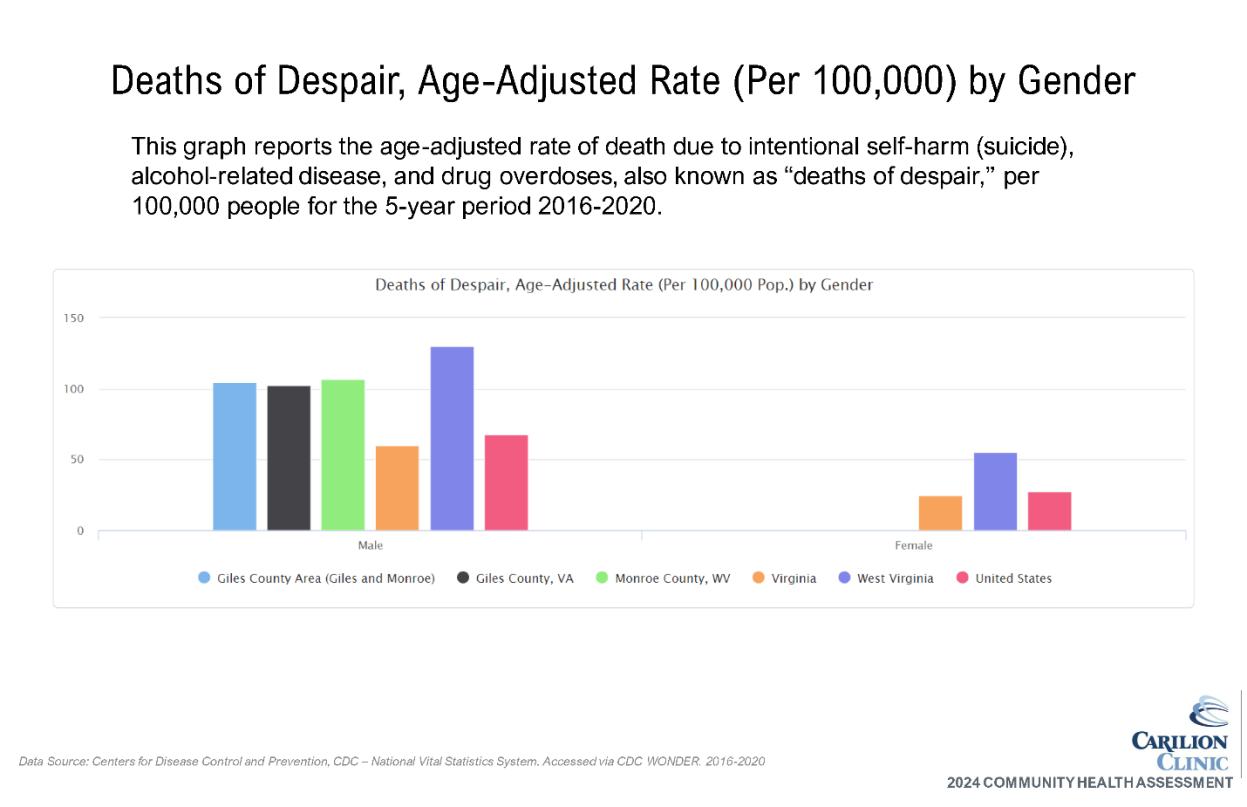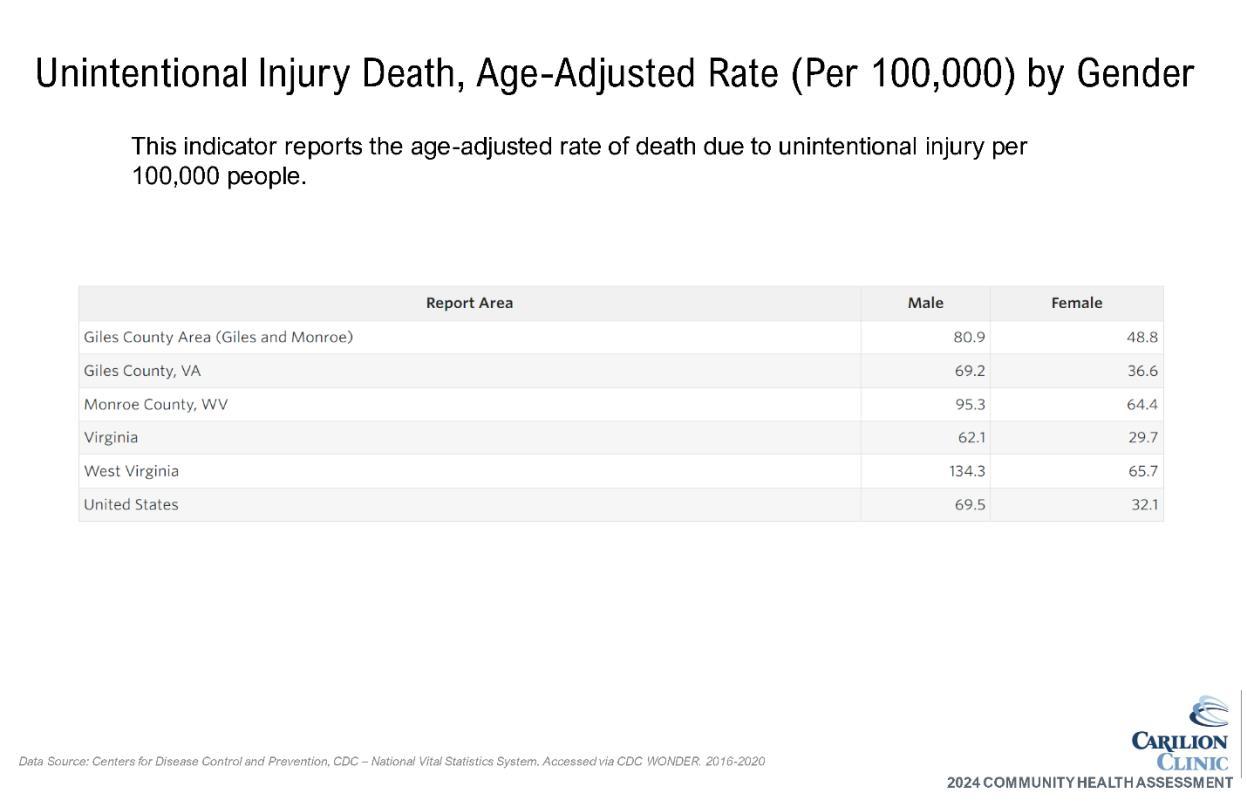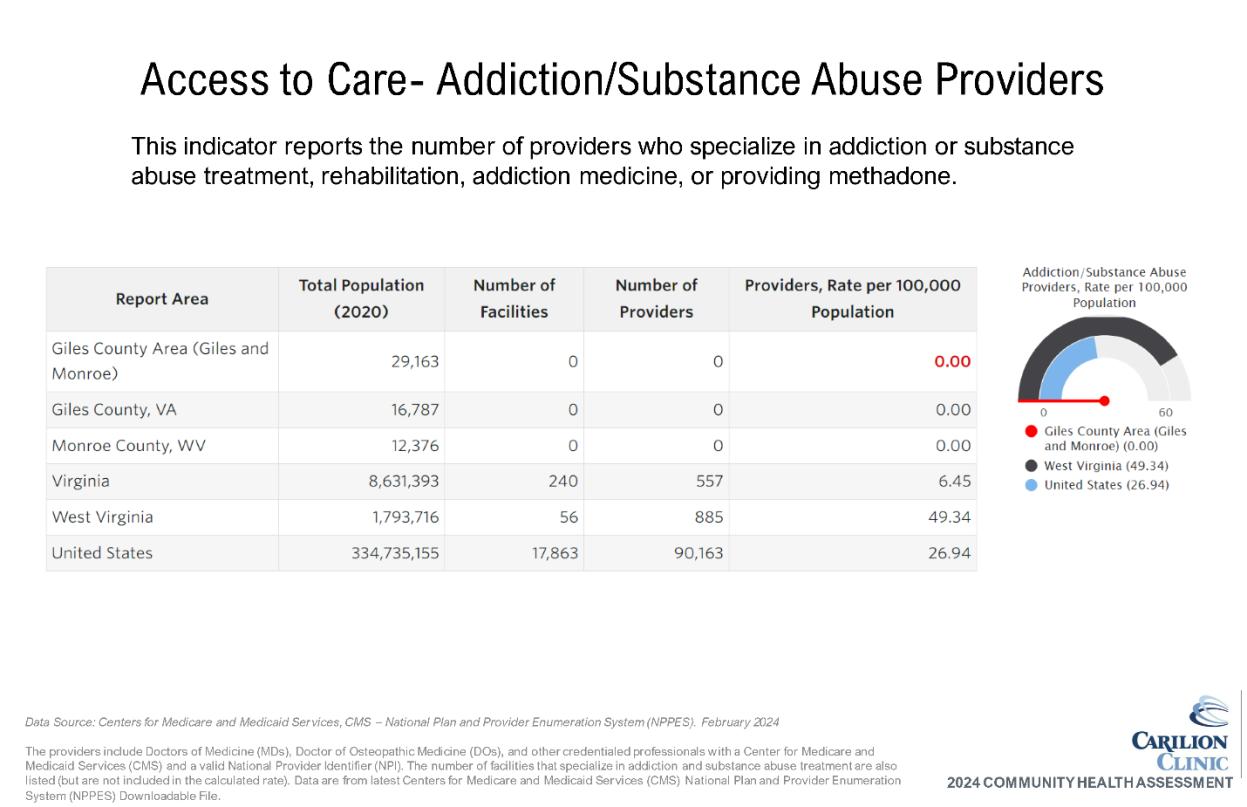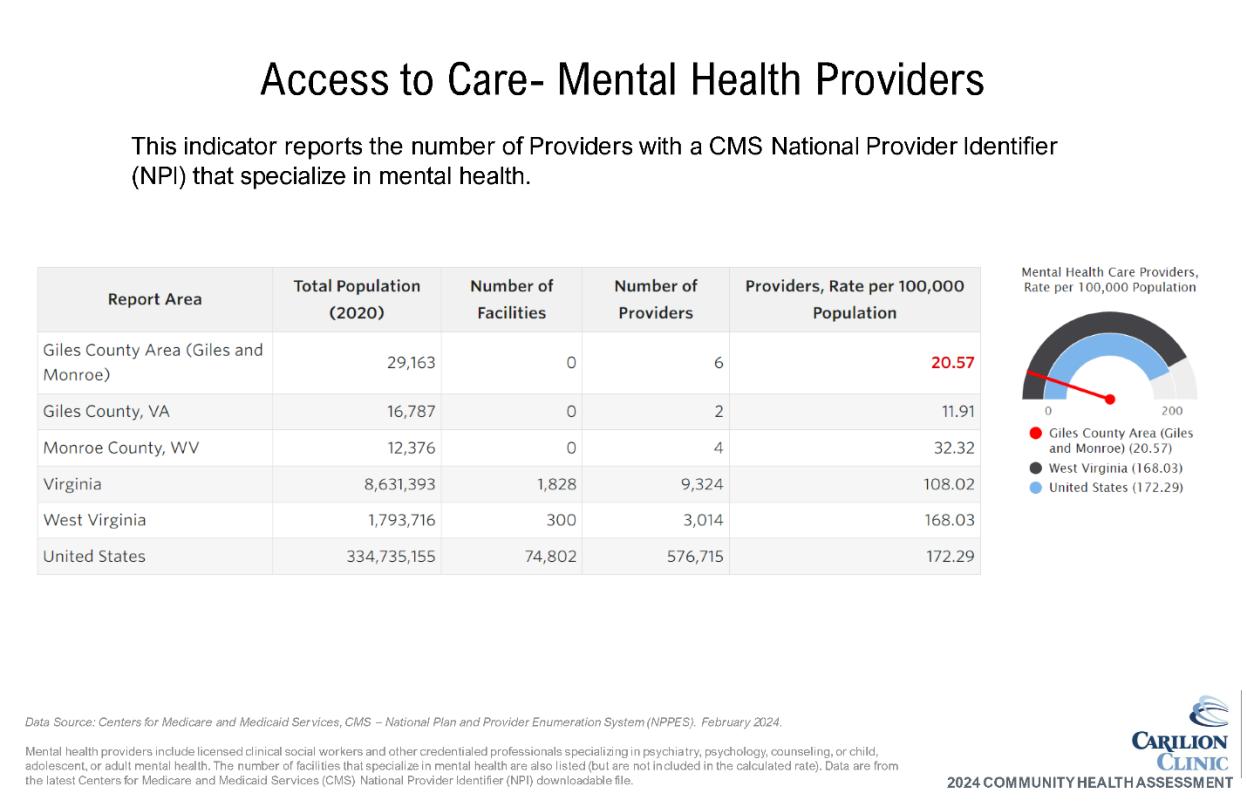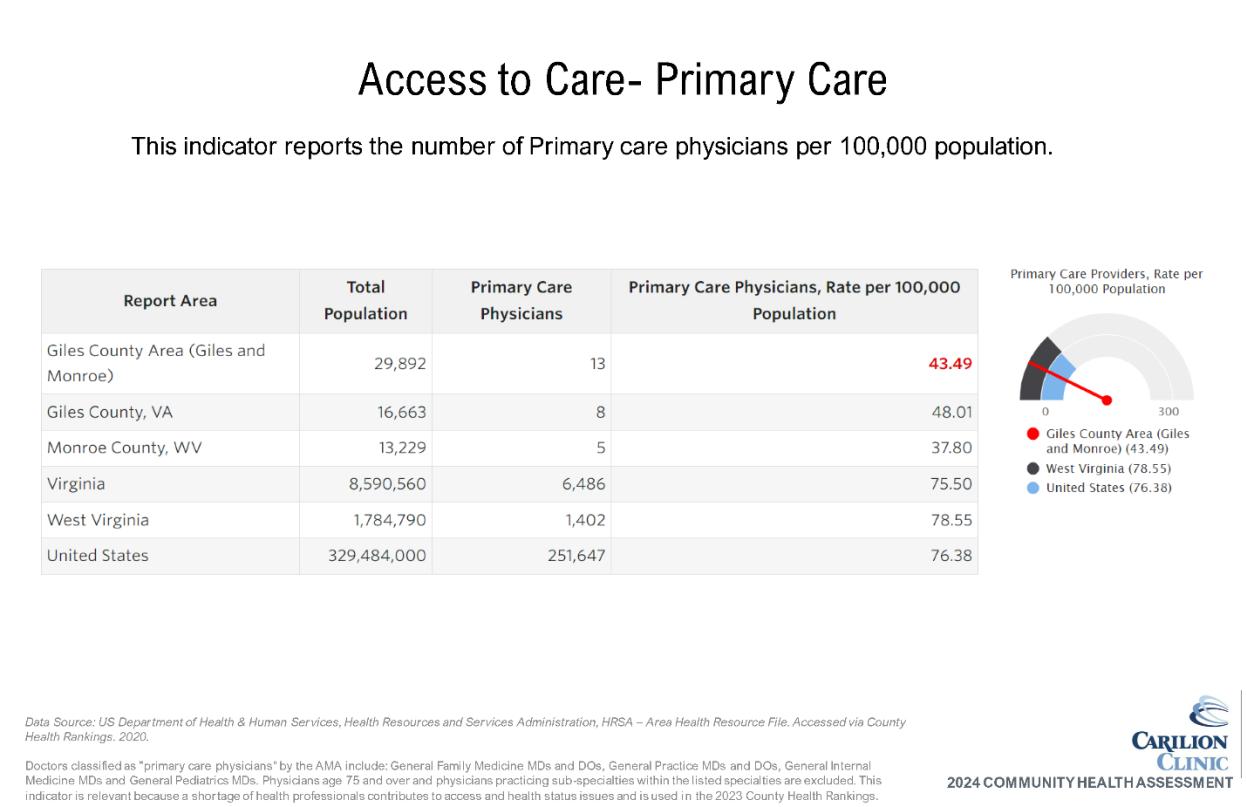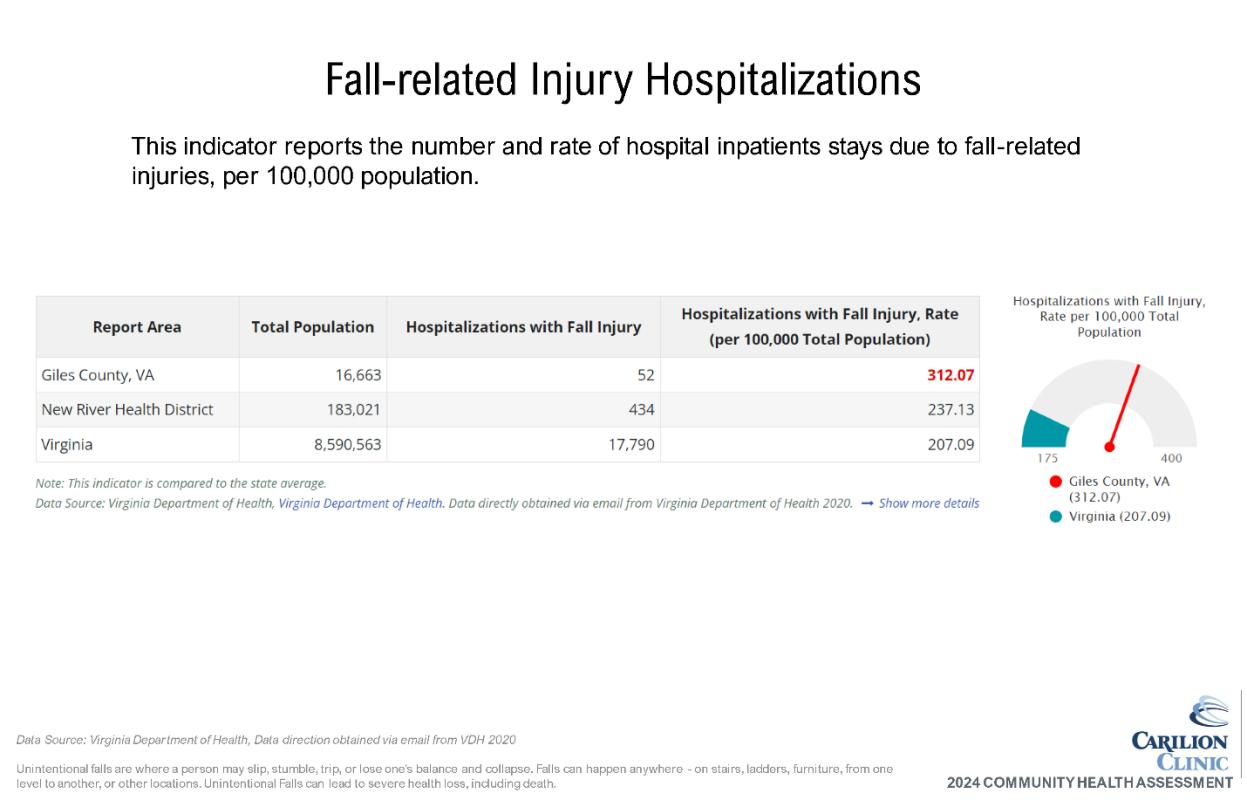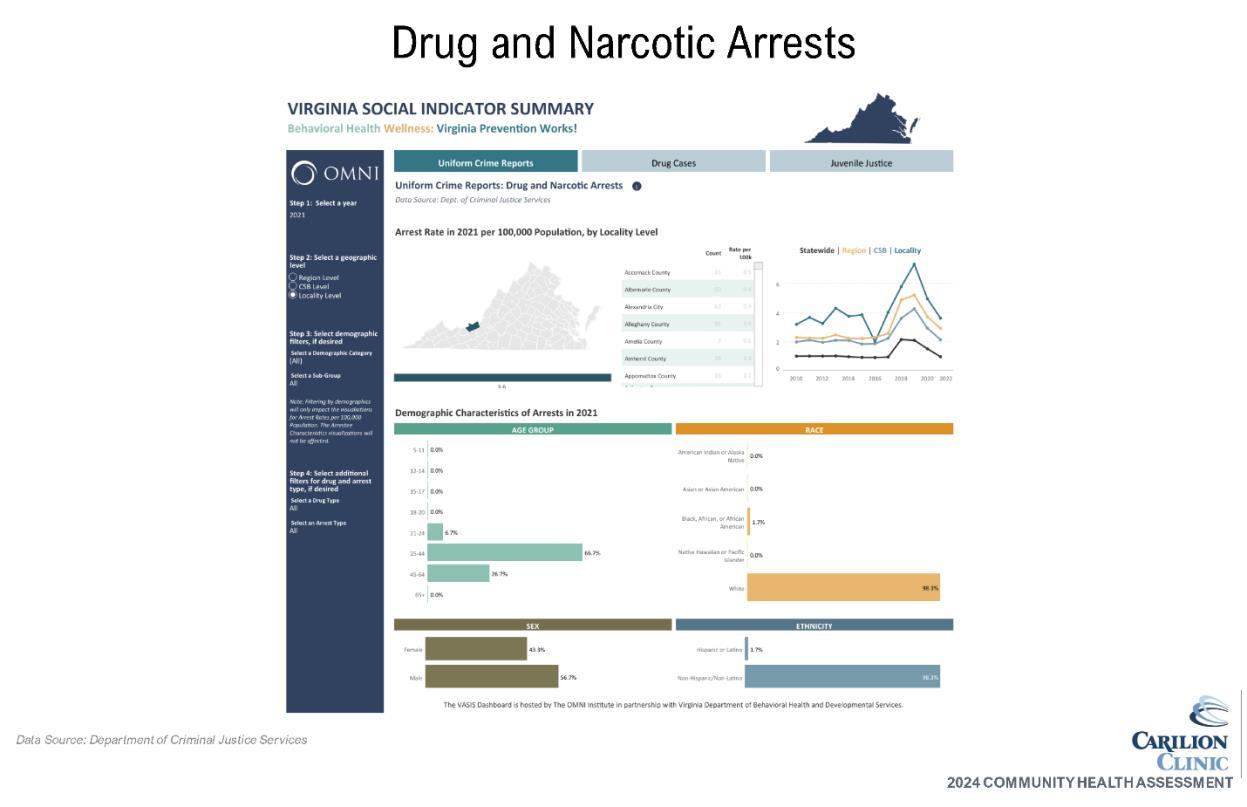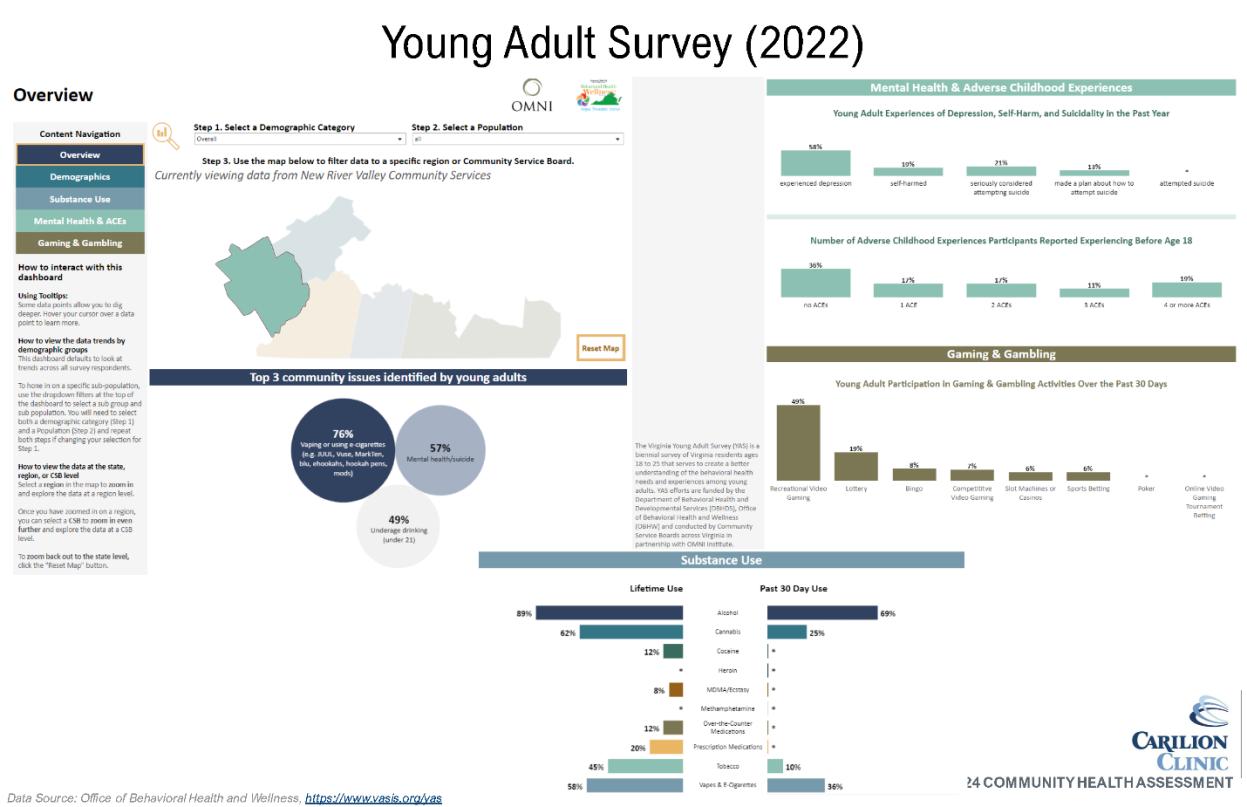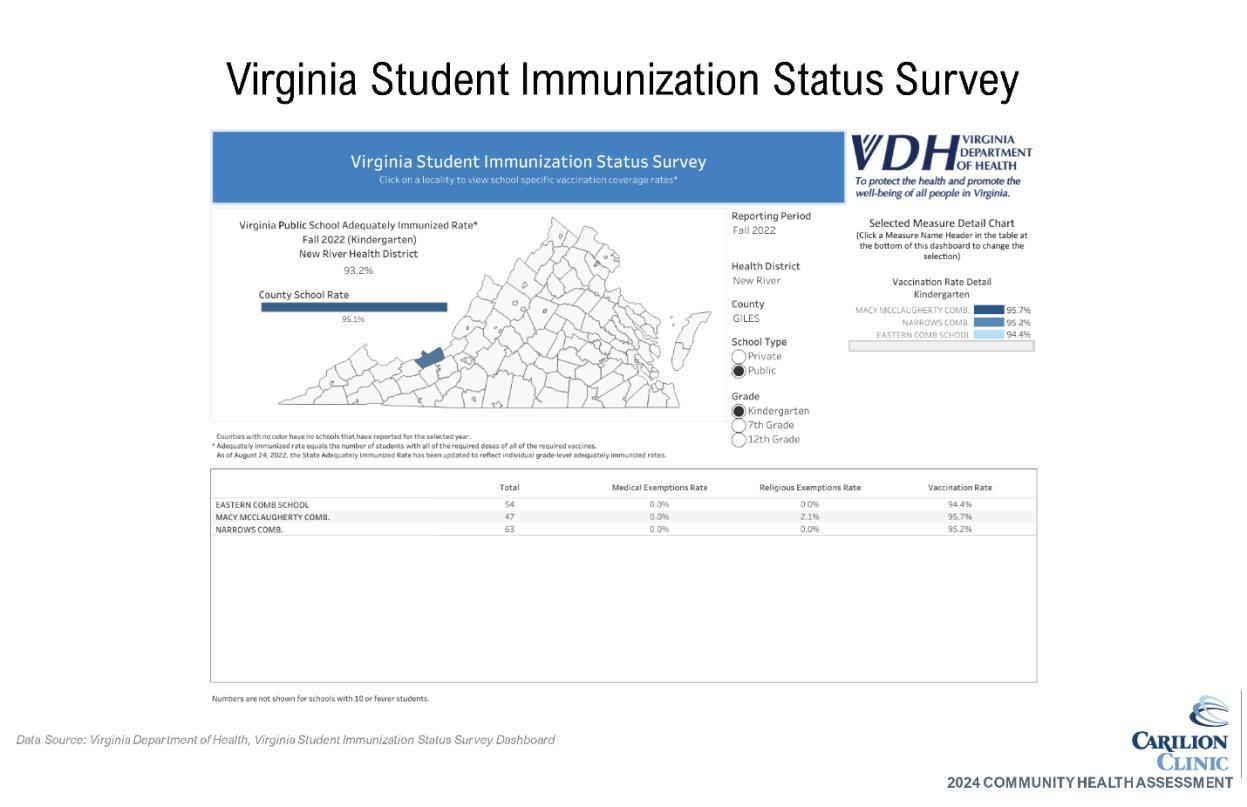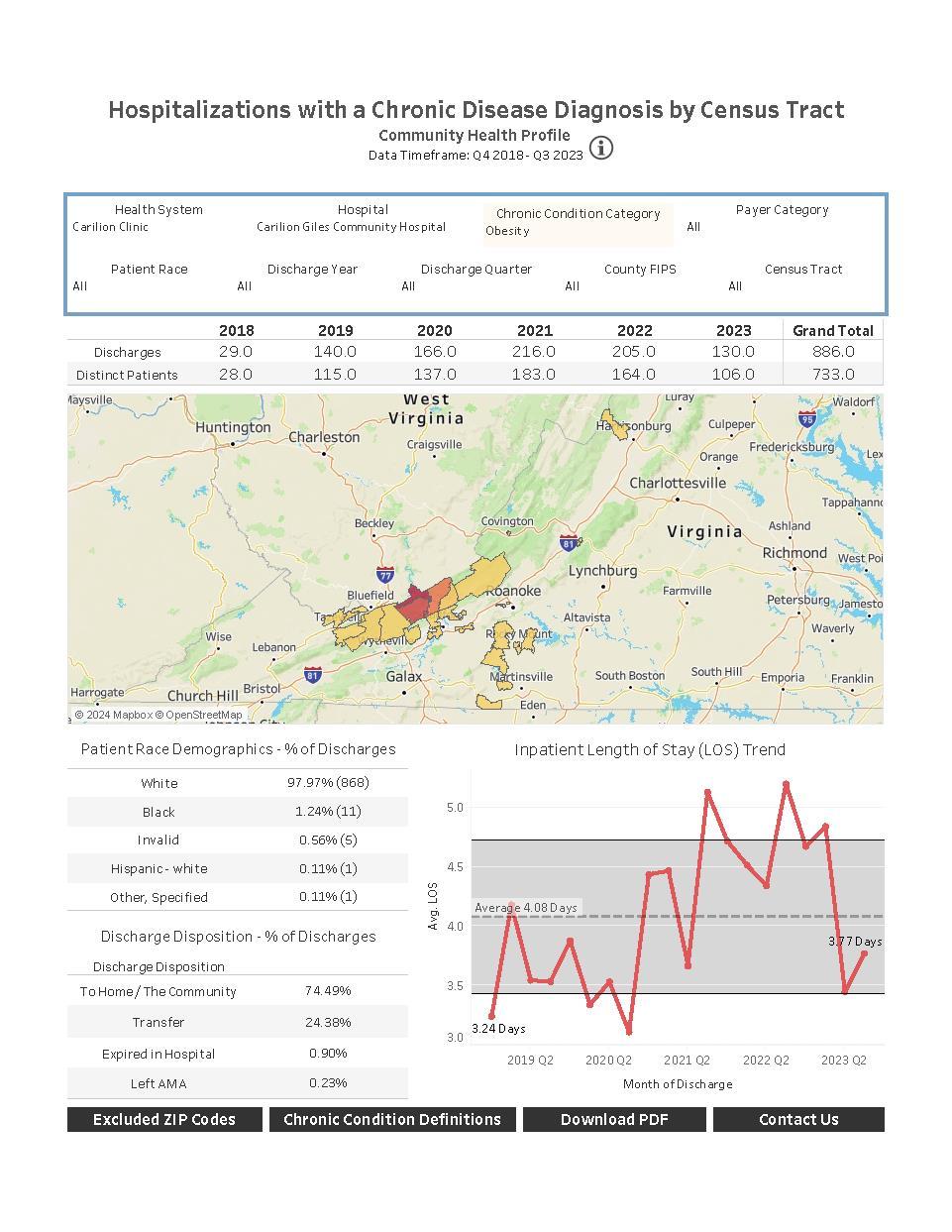Carilion Giles Community Hospital
CarilionClinic.org/community-health-assessments

Carilion Giles Community Hospital
CarilionClinic.org/community-health-assessments
Carilion Clinic is committed to joining with our partners to pursue the essential work of improving and maintaining the health of the Giles County Area in accordance with our mission of improving the health of the communities we serve Periodically assessing the health concerns of each community is a key component of addressing community needs Every three years, the Giles County Area Community Health Assessment (GCACHA) aims to uncover issues, indicate where improvement is needed and track and promote progress in key areas so that there is demonstrated, ongoing change. The CHA process and the public availability of its findings enable our community to effectively maintain and improve health.
Carilion, Giles County FOCUS (Focus on Communities Utilizing Services) and the New River Health District collaborated to conduct the 2024 GCACHA alongside additional community partners, the Community Health Assessment Team (CHAT) After review and discussion of the data collected, the 2024 GACHA led the CHAT to identify seven priority health issues in the community.
Carilion believes in continuous quality improvement. The triennial CHA serves as a formal way of identifying community needs and developing plans to address them It shapes the ways we support our mission in the community and encourages collaboration and alignment with clinical teams. Not only does this process identify current needs and disparities, but also helps to ensure we are regularly evaluating and shifting to meet emerging needs
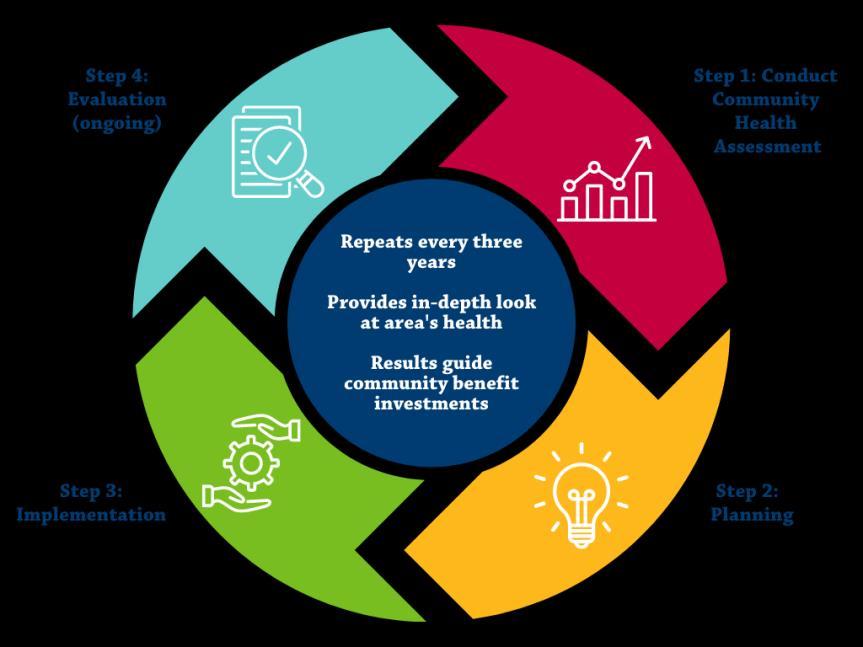
In collaboration with the CHAT, we prioritize health needs to align resources and efforts across the community for the following three years. The CHAT reviews extensive data, asks questions and then participates in a consensus-building prioritization process. The 2024 GCACHA resulted in the following health priorities:




The CHA process focused on prioritization of health conditions and outcomes, rather than a broader focus on their root causes We recognize that access to healthcare and other services and the social determinants of health (SDOH) are key facilitators of good health and well-being. As such, we focused on those and other health factors as a strategic component of action planning The key drivers of each priority health condition, as identified by the CHAT, are discussed in the corresponding sections of this report.
This document was approved by the CGCH Board of Directors on July 24, 2024, and formally adopted as the 2024 Giles Area Community Health Assessment.
This document has been produced to benefit the community. Carilion encourages the use of this report for planning purposes and is interested in learning of its utilization. Comments and questions are welcome and can be submitted to Carilion at communityoutreach@carilionclinic.org.
Members of the leadership team reviewed all documents prior to publication. Every effort has been made to ensure the accuracy of the information presented in this report; however, accuracy cannot be guaranteed. Members of the Giles Area CHAT cannot accept responsibility for any consequences that result from the use of any information presented in this report. Carilion began conducting CHAs prior to the IRS adoption of the 501(r)(3) standard which requires not-for-profit hospitals to conduct a Community Health Needs Assessment (CHNA) every three years. While meeting the CHNA requirement, Carilion maintains the longstanding formal name Community Health Assessment for our process and reports. A crosswalk of this document based on the 501(r)(3) standards can be found in Appendix A.
The CHA Leadership Team collaborates to guide major functions of the CHA, including CHAT recruitment, data collection/analysis and shaping meeting structure. In addition to Carilion staff, membership includes leadership from the local health district, the local Federally Qualified Health Center, population health experts and representation from local community networks. Carilion organizes and facilitates leadership team meetings.
• Carilion Clinic:
o Shirley Holland, VP, Community Health and Development
o Molly Roberts, Manager, Community Benefit
o Ashley Hash, Community Health Improvement Program Manager
o Holly Ostby, Community Health Improvement Program Manager
o Nicholas (Nick) Bilbro, Community Benefit Analyst
• New River Health District:
o Noelle Bissell, MD, Health Director
• Community Health Center of the NRV:
o Michelle Brauns, CEO
• Virginia Tech Department of Population Health Sciences:
o Sophie Wenzel, Assistant Professor of Practice
• Giles County FOCUS (Focus on Communities Utilizing Services):
o Jeff Dinger, Special Projects Manager, Giles County Administration
• Healthy Roots NRV:
o Jessica Wirgau, CEO, The Community Foundation of the NRV
• NRV Partnership for Access to Healthcare (PATH):
o Cayla Trueheart, Population Health Manager, New River Health District
To increase meeting efficiency, the GCACHA and New River Valley CHA (NRVCHA) leadership teams were combined, as many members/key stakeholders serve both service areas. To learn more about the NRVCHA and GCACHA service areas, see Step 1 under the Our Process section.
The CHAT is a dynamic group of health and human service agency leaders, individuals/organizations serving/representing the interests of priority populations and local representatives from various community sectors. The following community partner organizations participated in the 2024 GCACHA
Organization
Carilion Community Benefit
Carilion Community Health and Outreach
Carilion Giles Community Hospital
Community Health Center of the NRV
Organization Type
Community Health Improvement - Carilion
Health Education
Healthcare
Federally Qualified Health Center (FQHC)
Giles County Commonwealth's Attorney Office Commonwealth's Attorney
First Steps NRV/CFNRV
Community Development (Early Childhood Education)
Giles Community Garden Food Access
Giles County Administration
County Administration
Giles County Christian Service Mission Food Access
Giles County DSS
Giles County Public Schools
Giles Early Education Project
Giles Health and Family
Giles Ministerial Association
Giles Victim Witness
Monroe Health Center
New River Community Action
New River Health District (NRHD)
Department of Social Services
Public School (K-12)
Children's Education/Reading Access
Adult and Child Day Care/Transportation
Faith Community
Victim Advocacy Resources
Federally Qualified Health Center (FQHC)
Low-Income Community Resources
Public Health (Local Health District)
NRV Agency on Aging Agency on Aging
NRV CARES
NRV Regional Commission
Children's Violence Prevention Resources
Economic Development
The Community Foundation of the NRV Philanthropy/Community Development
VA Cooperative Extension Cooperative Extension (FNP)
Virginia Department of Veterans Services
Virginia Tech
Veteran's Services
Public Health (Student)
Women's Resource Center NRV Domestic Violence Resources
To see a list of specific 2024 CHAT participants, please see Appendix B
Data Team
Additional data support was provided by the Virginia Department of Health Division of Population Health Data
• Khristina Morgan, Community Health Epidemiology Regional Coordinator
• LeeAnn Gardner, Community Health Epidemiologist, Central Shenandoah Health District
• Taiwo Ilechie, Community Health Epidemiologist, Roanoke City and Alleghany Health Districts
The first step in the ongoing community health improvement process is to conduct a CHA. Every three years, Carilion follows the formal process described below to identify community needs and develop plans to address them. The 2024 GCACHA officially began on October 12, 2023, and concluded with the final CHAT meeting on June 13, 2024.
Carilion Giles Community Hospital (CGCH) is located in Pearisburg, Virginia. CGCH is a not-forprofit, 25-bed critical access hospital dedicated to quality care and patient comfort. Offering both inpatient and outpatient services, CGCH also impacts the health of the community through its Swing Bed program extended recovery for patients with skilled care needs before transitioning home.
In fiscal year 2023, CGCH served 11,119 unique patients. Patient origin data revealed that during this year, 91% of patients served by CGCH lived in the following localities:
• Giles County (69%)
• Monroe County, WV (22%)
These localities comprise the GCACHA service area. It is important to note that Giles County is considered part of a regional area called the New River Valley (NRV) and is partly served by Carilion New River Valley Medical Center (CNRV) located in Christiansburg, Virginia. Giles is located at the northern edge of the New River Valley region, sitting along the West Virginia state border. A mountain ridge runs along the border, somewhat dividing Giles County from the rest of the New River Valley home to universities, shopping and business centers.
In addition to Carilion, key safety net providers in the region include the Community Health Center of the NRV (an FQHC), New River Valley Community Services, local offices of the Virginia Department of Health (VDH) and other service organizations. Despite their local presence and the richness of the area’s natural and cultural resources, many residents feel unable to achieve their desired health outcomes. Define Community Convene Stakeholders
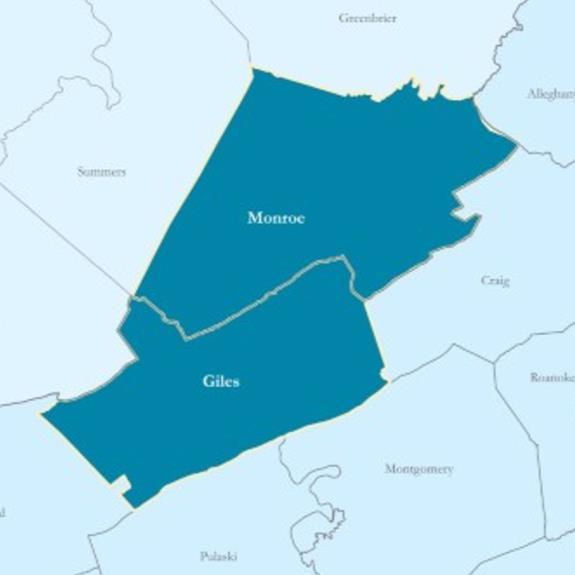
Both counties have similar demographics, although Monroe County is less densely populated. Both localities vary from state and national demographics showing less racial diversity, lower median income and higher median age. The Weldon Cooper Center for Public Service predicts a -1.1% population change by 2040 for Giles County 1 Although county-level data is not available for Monroe, the center predicts a statewide population decrease for West Virginia of 7.8%.2
Table 1. Select Demographics of the GCACHA Service Area
Source: US Census Bureau, ACS, 2018-2022
Table 2. Income Data for the GCACHA Service Area
States
Source: US Census Bureau, ACS, 2018-2022
Specific to CGCH inpatients and outpatients in fiscal year 2023, 21.78% received Medicaid while 3 75% were self-pay, a proxy for uninsured 3
1 University of Virginia Weldon Cooper Center for Public Service. (2022). Virginia Population Projections. Retrieved from https://coopercenter.org/virginia-population-projections
2 University of Virginia, Weldon Cooper Center for Public Service. (2024). National and 50-State Population Projections. Retrieved from https://coopercenter.org/national-population-projections
3 Strata internal data
Source: US Census Bureau, ACS, 2018-2022
Table 4. Racial Demographics, GCACHA Service Area
Source: US Census Bureau, ACS, 2018-2022
A Primary care Health Professional Shortage Area (HPSA) covers Giles County and the lowincome population of Monroe County. Dental health HPSAs exist for both localities’ low-income populations However, only Giles’ low-income population has been identified as a mental health HPSA. 4 Both Giles and Monroe have been identified as Medically Underserved Areas (MUAs).5
The target population for Carilion’s CHA projects consists of underserved/vulnerable populations disproportionately impacted by SDOH, including poverty, race/ethnicity, age, education, access and/or lack of insurance. Data are reviewed where available by different life stages, including parents of children and adolescents, women of child-bearing age, adults and the elderly. Other considerations include race, ethnicity and income levels. All patients are included in this assessment regardless of insurance payments or financial assistance eligibility. Distinct efforts are taken to ensure the CHA reflects those residing in MUAs and HPSAs.
A 54-member CHAT participated in the assessment activities Hearing voices from across our service area is crucial to a CHA’s success. Broad-interest community reach is a main qualification when inviting individuals to join the CHAT, which was achieved through engaging the collaborative networks working to improve various aspects of well-being in the Giles Area
4 https://data.hrsa.gov/tools/shortage-area/hpsa-find
5 https://data.hrsa.gov/tools/shortage-area/mua-find
Giles County FOCUS and the Giles Youth-Adult Partnership (the local substance use prevention coalition)
In addition to inviting participation through the community networks, we also extended direct invitations to representatives from the NRHD, local governments, the local school system, social service organizations, other community organizers and nonprofit leaders.
The CHAT met four times throughout the process, with each meeting serving a distinct purpose.
• Meeting 1: Introduction and Overview of the Process; Launch of Community Health and Well-Being Survey
• Meeting 2: Data Presentation and Data Walk
• Meeting 3: Prioritization of Needs and Discussion
• Meeting 4: Action Planning: Key Drivers and Impact/Feasibility Activity
Each meeting built on the one prior and fostered dialogue amongst CHAT members. Meetings were held in person and virtually with interactive opportunities to participate and engage with data and facilitated discussions with other CHAT members.
The CHA Leadership team was engaged from the beginning of the planning process (spring of 2023) throughout the assessment period and CHAT meetings. Their involvement helped shape all aspects of this assessment. The team identified community partners to serve on the CHAT, provided discussion points and suggestions on structure of CHAT meetings and offered feedback on the prioritized needs. Additionally, leadership team representatives were active on the CHAT and participated in all CHAT activities including the Stakeholder Listening Session and the prioritization activity.
The CHAT included other individuals or organizations serving or representing the community’s medically underserved, low-income and minority populations. Examples include:
• Local health district (e.g., VDH - New River Health District)
• Federally Qualified Health Centers (e.g., Community Health Center of the NRV)
• Social service agencies (e.g., New River Valley Community Action, Virginia Cooperative Extension)
• Community services (e.g., Giles Health and Family, Giles Christian Mission, New River Valley Community Services, Women’s Resource Center of the NRV)
• Philanthropy (e.g., Community Foundation of the NRV)
• Economic development organizations (e.g., NRV Regional Commission)
These organizations and individuals helped gather community input by distributing the Community Health Survey. CHAT member input was solicited through the Stakeholder Survey and Listening Session. Combined, these efforts led to the identification and prioritization of community health needs.
Various data were collected and shared regularly with the CHAT, including primary and secondary data on health outcomes, health status, socioeconomic factors and quality of life. Secondary data served as a key driver of the process, with primary data adding community context and perspectives to understand the needs of subpopulations within the community.
A Community Health and Well-Being Survey was conducted as part of the GCACHA. This survey was used to evaluate the community’s health and identify potential geographic areas to target improvements. Input and oversight of survey development was provided by the CHAT and the CHA Leadership Team
A 27-question survey instrument was utilized. It asked questions about access to care and other services, health status, community strengths, quality of life, subjective well-being and demographics (Appendix C: Community Health and Well-Being Survey). The survey instrument included commonly used questions and metrics from the following established community surveys:
• Cantril’s Ladder
• Community Themes and Strengths Assessments, National Association of County and City Health Officials, Mobilizing for Action through Planning and Partnerships
• Community Healthy Living Index, YMCA
• Behavioral Risk Factor Surveillance System, Centers for Disease Control and Prevention (CDC)
• National Health Interview Survey, CDC
• Youth Risk Behavior Surveillance System, CDC
• Martin County Community Health Assessment, Martin County, North Carolina
• Previous Giles County Area Community Health Surveys
The population of interest for the survey was Giles Area residents 18 years of age and older. Surveys were distributed from October 2023 through December 2023. A drawing for a $50 grocery store gift card was offered as an incentive for those completing the survey.
The following subpopulations were especially targeted for sampling:
• Underserved/vulnerable populations disproportionately impacted by SDOH, including:
o Poverty
o Race/ethnicity
o Education
o Lack of insurance
A non-probability sample method was used, where respondents were not randomly selected. Although the survey was available to all residents living in the Giles Area, oversampling of the targeted subpopulations occurred through specific outreach efforts through community partners. Oversampling ensured that needs and assets specific to this subpopulation of interest were captured.
The survey instrument was available in both English and Spanish via the following methods:
• Qualtrics link and QR code
• Phone line (888-964-6620)
• Paper surveys (collected by volunteers and/or staff of partner agencies)
Outreach strategies for survey distribution included:
• Social media
• Flyers and posters distributed throughout the community with survey QR code, URL and phone line information
• Survey URL posted on partner agency websites
• Recruitment of participants on site at CHAT member organizations
In total, 108 surveys were collected and validated. Full survey results and validation methodology can be found in Appendix C
All responses were entered into Qualtrics by survey respondents or, in the case of surveys completed on paper, by Carilion staff. Surveys were analyzed and reported using Qualtrics and Microsoft Excel.
Stakeholder Listening Sessions and Survey
CHAT members were invited to provide an additional perspective on the needs and barriers to health facing our community. Carilion staff from across the organization facilitated small group discussions. To quantify focus group data, CHAT members were asked to complete the Stakeholder Survey. A summary of the data can be found in Appendix E.
Community stakeholders, leaders and providers were encouraged to complete the Stakeholder Survey after participating in a listening session. The survey was also shared with leaders who may not have attended a listening session. The online survey was shared at the CHAT meetings and via email. Surveys were analyzed and reported using Qualtrics and Microsoft Excel.
Community Listening Sessions
Community members were invited to participate in Community Listening Sessions to collect qualitative data to further understand health-related needs. A facilitated listening session was held with participants of the county’s recovery court program. A summary of the data can be found in Appendix E.
Secondary Data
Secondary data came from two primary sources: SparkMap and the VDH Division of Population Health Data. SparkMap is a product from the University of Missouri that quickly and accurately aggregates data across geographies for 80+ indicators from publicly available sources such as the American Community Survey, County Health Rankings and the CDC. Secondary data analysis was provided through SparkMap’s tables, maps and visual diagrams depicting indicators that are better or worse than the state average, trends over time and comparisons across different population segments such as race and life cycle.
A team of VDH epidemiology staff provided and analyzed data from specific VDH departments a critical component of the data walk. Data provided included mortality due to specific chronic diseases, incidence rates of sexually transmitted infections, sociodemographic data, cancer rates and others. VDH was also able to provide data broken down by gender and race/ethnicity for many health topics.
Community Demographic Data
Health Factors Data
- CHAT 1 Presentation
- CHAT 1 Presentation - CHAT 2 Overview in Presentation - Data Packet Email prior to CHAT 3
Health Outcomes Data Secondary - CHAT 1 Overview in Presentation - CHAT 2 Data Walk - Data Packet Email prior to CHAT 3
Community Health & Well-Being Survey
Community Listening Sessions (CLS)
Stakeholder CLS
- Data Packet Email prior to CHAT 3
- Data Packet Email prior to CHAT 3
- Data Packet Email prior to CHAT 3
Using their community knowledge, data collectively reviewed and additional data requested and shared, CHAT members were asked to complete an electronic survey to prioritize community health needs. Prioritization topics included specific health conditions or outcomes reflecting those conditions which contribute to morbidity and mortality in the service area. The prioritization survey matched the structure utilized during the data walk at CHAT Meeting 3. This resulted in the identification of 13 community health needs.
During CHAT Meeting 4, members completed a dot voting activity to further refine the priority list. A discussion ensued to determine the final prioritized needs based on scope of issue, burden on community and feasibility to address at the community level based on CHAT member perspectives and perceptions Appendix F summarizes the prioritization activity, including the results of each exercise component.
The 2021 GCACHA and the subsequent Implementation Strategy were posted publicly though multiple electronic channels and shared widely by community partners. An email address was provided for submission of written comments, but none were received for consideration in the identification and prioritization of health needs.
The final CHAT meeting served as a springboard into both hospital and community action planning. The prioritized needs were again reviewed and a two-part activity ensued. CHAT members identified key drivers of the prioritized health outcomes/conditions using the Robert Wood Johnson County Health Rankings framework as reference. Following the identification of drivers, an impact and feasibility analysis was completed in small groups to help identify leading strategies for community change.
The top prioritized needs established in the 2021 GCACHA were grouped into three overarching categories: mental health, culture and family and socioeconomic factors. Key strategies included health education, grant funding to address SDOH and support for the efforts of community partners in addressing the needs, both directly and indirectly. Below is a snapshot of outcomes from these efforts through June 30, 2024.


Carilion is part of a growing movement of health system stewards committed to unlocking our community’s potential to thrive. We, along with key partners, strive to identify and address health and socioeconomic factors that impact our communities’ health and well-being. We know that where you live is an important contributing factor of health status and outcomes. We are committed to advancing a culture of health where policies, systems, education, research and resources align for optimal health status.
Our mission calls for us to meaningfully address health inequities and disparities. Equity is a key lens for the CHA process, guiding our actions as we seek to understand community health needs. As we move forward into developing community heath improvement strategies, we will remain focused on identifying and serving those who need it most, seeking to broaden the potential for everyone across our communities to thrive.
The Area Deprivation Index (ADI), a tool developed by the University of Wisconsin-Madison, sheds light on what are considered disadvantaged areas of the community based on census block groups (neighborhoods).6 This granular data helps emphasize the importance of conditions that shape our daily lives. The image below shows some variation seen across the service area in ADI scores and illustrates the extreme variation from the rest of the NRV, particularly the Blacksburg area of Montgomery County, which is mostly shades of blue in the first image. Data used in creating the index includes factors for income, education, employment and housing quality some of the key social determinant factors that influence health outcomes.
Map 1. Area Deprivation Index Map



Source: University of Wisconsin School of Medicine and Public Health.Area Deprivation Index (ADI). 2022.
6 https://www.neighborhoodatlas.medicine.wisc.edu/
As we work to improve health equity across our region, our guiding principles include improving access to care and addressing SDOH This assessment focuses on those principles in the context of specific prioritized health outcomes To expect a shift in health outcomes, we must focus on improving the underlying factors that lead to them seen in the figure below in a coordinated manner. We will be addressing specific SDOH needs as aligned with the CHA focus areas
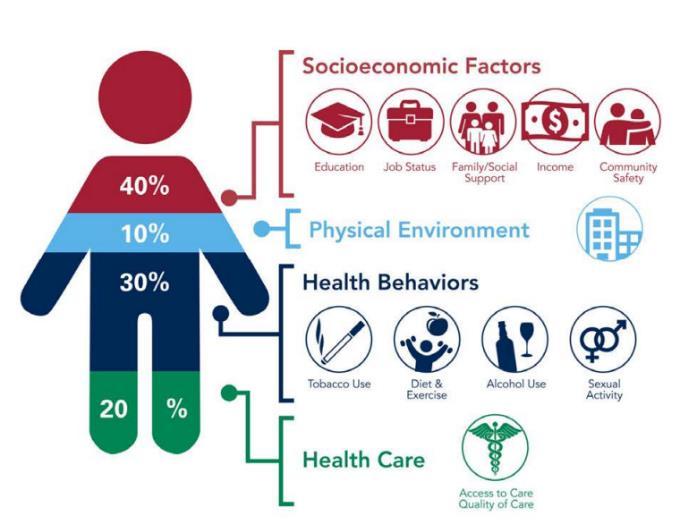
Source: Institute for Clinical Systems Improvement; Going Beyond Clinical Walls: Solving complex Problems, 2014. Analysis and adaptation from the University of Wisconsin Population Health Institute’s County Health Rankings model, 2010. Graphic designed by ProMedica and shared by the American Hospital Association.

Our prioritization process resulted in the elevation of three specific chronic diseases for focus: overweight/obesity, heart disease and hypertension. The following data indicates potential areas for opportunities
Data shows need
• Residents of the service area have a higher-than-average occurrence of:
o Physically unhealthy days
o Obesity
o Heart disease
Community indicates need
• Community survey respondents indicated:
o Overweight/obesity and stress were identified as top health conditions affecting their/their family’s health and well-being
o Lack of exercise and poor eating habits were two of the top health factors affecting their/their family’s health and well-being
o Access to parks and recreation was a top identified area of strength in our community
According to the Institute for Health Metrics and Evaluation (IHME), high body-mass index (BMI), high blood pressure and dietary risks are within the top 10 risks driving death and disability. In other words, these are some of the key impacts on overall health, well-being and life expectancy.7 Additionally, chronic diseases are a leading driver of healthcare costs 8
Chart 1 below shows the average number of self-reported physically unhealthy days from the CDC’s Behavioral Risk Factor Surveillance System (BRFSS), which is higher for both counties than Virginia’s state average. This metric helps illustrate the impact chronic disease may have on residents’ perceptions of their physical health and quality of life.
The data below shows that both counties exceed Virginia state averages in self-reported adult obesity rates and coronary heart disease rates. Monroe County also exceeds Virginia’s average high blood pressure rates, while Giles is very slightly below In all metrics, Monroe County leads the service area with the highest reported rates of chronic disease
When reviewing adult high blood pressure rates by zip code tabulation area (ZCTA), key differences are apparent. A large portion of Monroe County, which is much less densely populated, has higher rates of hypertension compared to the less rural areas of Giles County with more resources. Because blood pressure is known to increase with age for most people,9 it’s important to note that the data available at this zip code level is not age-adjusted
7 United States | Institute for Health Metrics and Evaluation (healthdata.org)
8 https://www.cdc.gov/chronic-disease/about/index.html
9 Franklin, Stanley S., et al. "Hemodynamic patterns of age-related changes in blood pressure: the Framingham Heart Study." Circulation 96.1 (1997): 308-315.
Chart 1. Physically Unhealthy Days



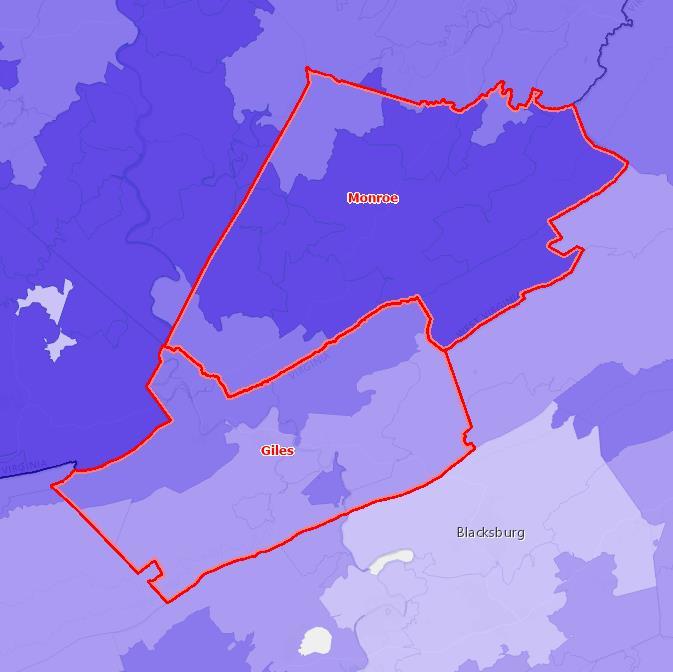

Source: Centers for Disease Control and Prevention, Behavioral Risk Factor Surveillance System: 2021. Accessed via SparkMap.
Key Drivers
Community partners identified many key drivers of these chronic diseases, including access to healthy foods, physical activity, culture/readiness to change and the impact of stress and trauma According to the CDC, many preventable chronic diseases are caused by the same behaviors, which include smoking, poor nutrition, lack of physical activity and excessive alcohol use. By adopting strategies to influence these behaviors, we can ultimately impact multiple diseases with coordinated strategies.
Resources Available
A detailed list of community partners is available in Appendix G Key resources to address chronic diseases in the Giles Area include:
• Carilion health education programming
• Diagnostic, management and treatment services through healthcare systems
• Prevention and self-management education services
• Healthy behavior support services

Our prioritization process resulted in the elevation of mental health challenges and substance use as focus areas. The following data indicates potential areas for opportunities.
Data shows need
• Compared to Virginia’s average, residents of the Giles Area have a higher occurrence of:
o Mentally unhealthy days
o Cigarette smoking
o Overdose mortality
• Higher occurrence of mentally unhealthy days than physically unhealthy days
Community indicates need
• Community survey respondents indicated:
o Stress and mental health problems as two of the top health conditions impacting their/their family’s health
o Alcohol and illegal drug use one of the top health factors impacting their/their family’s health and wellbeing
o Mental health/substance use services would improve quality of life in our community
o Concern for lack of access to mental health counseling and inpatient/outpatient substance use treatment
According to IHME research, drug use disorders are the number two cause of death and disability in the United States. Depressive disorders and anxiety disorders, both mental health challenges, are ranked at fifth and eighth, respectively.10 All of these health conditions have been worsening in recent years, especially in relation to the impacts of the COVID-19 pandemic
Prevalence of adult depression, mentally unhealthy days and cigarette smoking is reported through BRFSS and overdose mortality is reported through the CDC’s National Vital Statistics System. Monroe depression data was unavailable through our data source, which focused on Virginia state data. Both counties exceeded the state average for all available metrics.
Chart 4. Depression Prevalence
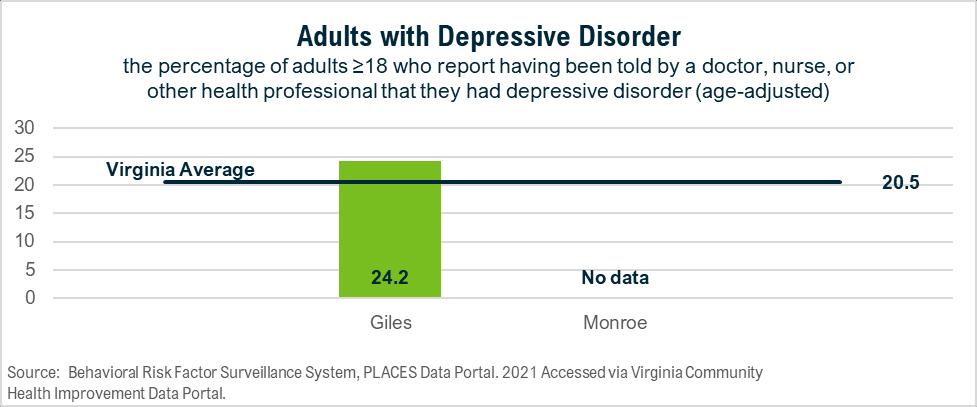
Chart 5. Mentally Unhealthy Days
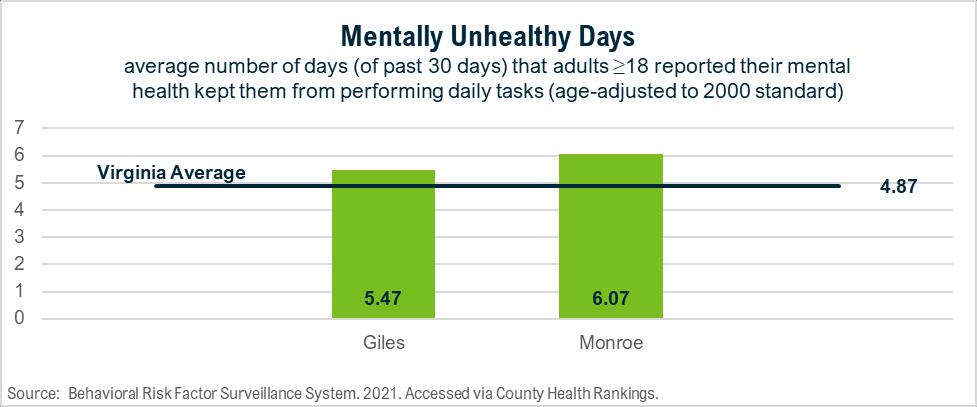
6. Cigarette Smoking Prevalence
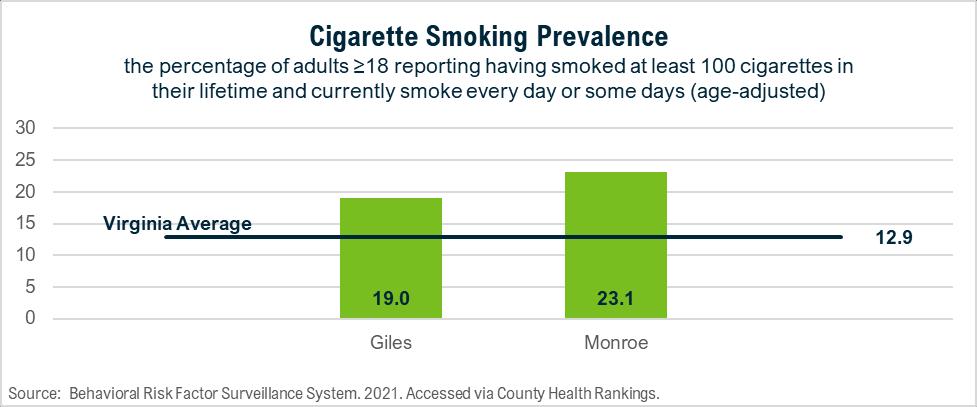
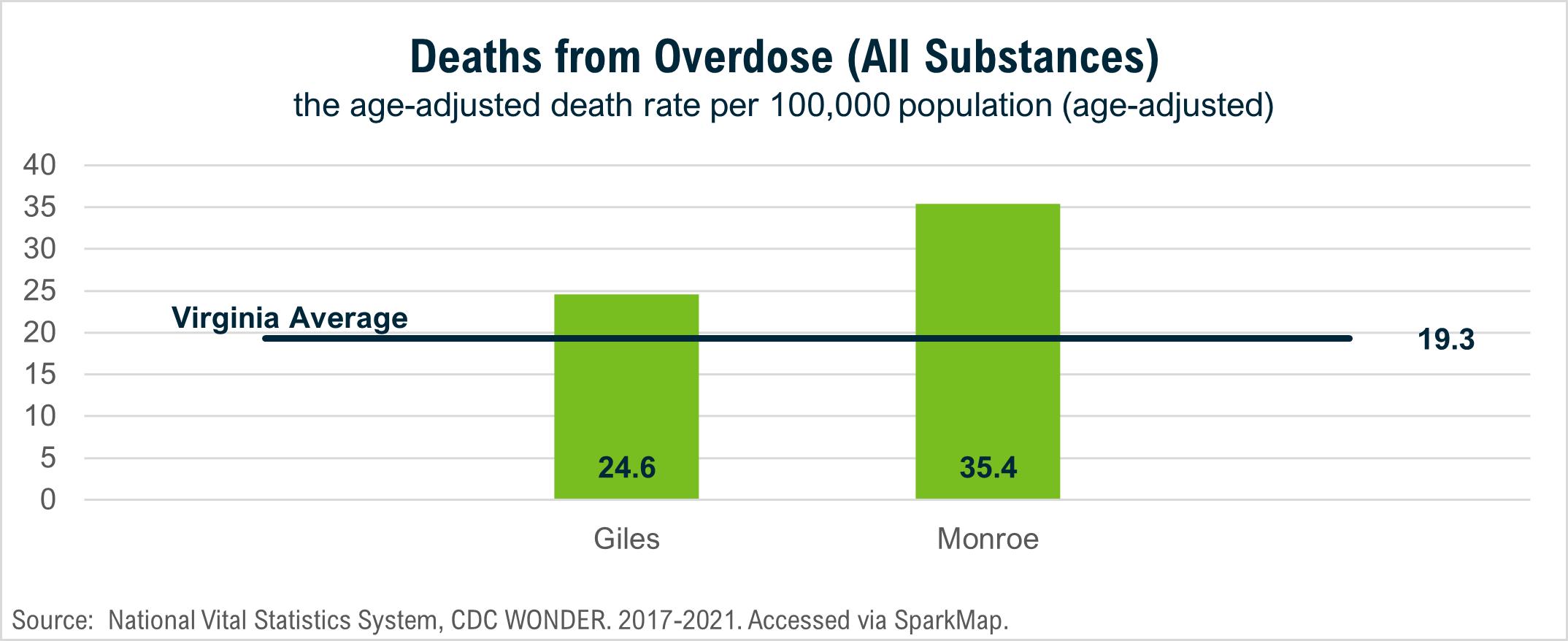
Community partners identified many key drivers of substance use, including poverty, trauma, mental health challenges, stigma, lack of social support and lack of knowledge/low perceived risk. Identified drivers of mental health challenges included many of the same trauma, stigma, financial circumstances, lack of self-awareness and housing instability. Mental health and substance use are intertwined. Both areas can benefit from some of the same strategies, especially related to prevention. However, there are key differences in effective strategies with individuals who are actively experiencing challenges in those topic areas, which allows for all community partners to have a role in the work to address them.
A detailed list of community partners is available in Appendix G. Key resources to address mental health and substance use in the Giles Area include:
• Counseling, treatment and prevention services
• Harm reduction and other recovery services
• Opioid abatement funds
• Area prevention coalition (Giles Youth Adult Partnership)

Our prioritization process resulted in the elevation of interpersonal violence as a focus area. The following data indicates potential areas for opportunities.
Data shows need
• GCACHA area is lacking data on assault deaths (homicides) due to low reported numbers
• Deaths from firearms are higher than average in Giles County
• Deaths from accidents are higher in Giles County and Monroe County, WV
Community indicates need
• CHAT participants indicated concern for intimate partner violence/child abuse and the resulting generational impact
• CHAT participants noted difficulties in measuring the need:
o Underreporting
o Data suppression
o Stigma/safety concerns
• Survey respondents indicated the following top strengths of our community:
o Good place to raise children
o Public safety and health (law enforcement, fire/EMS, public health)
The American Public Health Association issued a policy brief in 2018 recommending that violence be deemed a public health crisis.11 Since that time, data shows that violence in our communities has increased. Violence as defined by the policy brief refers to “the intentional use of physical force or power, threatened or actual, against oneself, another person, or against a group or a community, which either results in or has a high likelihood of resulting in injury, death, psychological harm, maldevelopment, or deprivation.” This encompasses a wide range of challenges including child maltreatment, elder maltreatment, intimate partner violence, bullying and broader community violence.
The impact of violence is far-reaching and includes not only the directly affected individual, but also those who are exposed indirectly and the community at-large. Gun violence, for example, continues to be an issue of national concern and negatively impacts entire groups of people in addition to direct victims. While Monroe County does not have a sufficient number of deaths from firearms for reporting purposes, Giles County does see this occurring at a rate higher than the Virginia average.
Adolescents are especially at risk for experiencing violence and research has shown that children who experience violence are at risk for long-term physical, behavioral and mental health problems.12 Violence prevention strategies that protect children, therefore, can create lasting, even generational, improvements to their health and well-being.
11 https://apha.org/policies-and-advocacy/public-health-policy-statements/policy-database/2019/01/28/violence-is-a-public-healthissue
12 https://health.gov/healthypeople/objectives-and-data/browse-objectives/violence-prevention

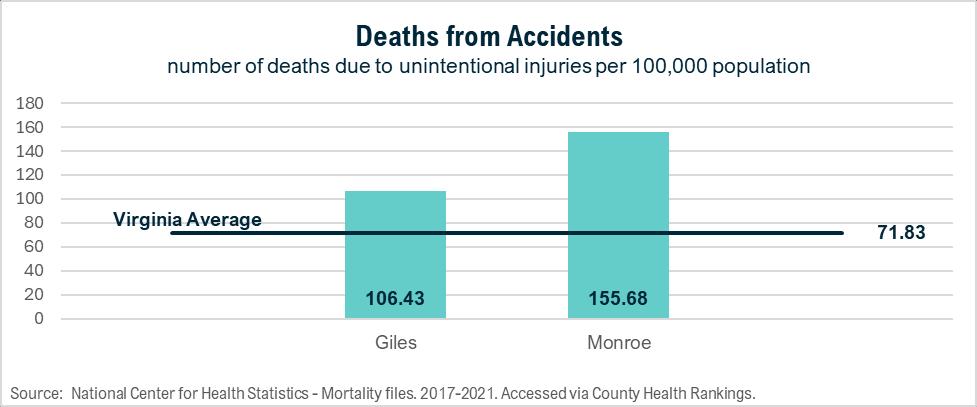
Community partners identified many key drivers of interpersonal violence, including mental health and substance use challenges, family/generational trauma, social isolation, lack of emotional literacy and institutionalized inequity Interpersonal violence can be very closely related to both SDOH and mental health and substance use challenges, further emphasizing the importance of cross-cutting strategies to address multiple health priorities.
Resources Available
A detailed list of community partners is available in Appendix G Key resources to address interpersonal violence in the Giles Area include:
• Crisis hotlines
• Emergency shelter/transitional housing
• Law enforcement

Our prioritization process resulted in the elevation of dental health as a focus area. The following data indicates potential areas for opportunities.
Data shows need
• When compared to the state average, the Giles Area has substandard measures of dental health:
o Higher rates of adults with poor dental health
o Lower rates of adults with a recent dental appointment
o High ratios of residents to dentists
Community indicates need
• Concern for access to routine dental care services was indicated through community survey
• CHAT participants indicated various challenges that need to be addressed to increase area resources and utilization of existing resources
Many people do not receive the dental care they need, even though dental health problems are easier to treat when they are caught early through regular preventative dental care. Untreated oral health problems can cause pain and disability and are linked to other diseases.13
BRFSS (Behavioral Risk Factor Surveillance System) survey data reflects that both localities have a higher percentage than that of the state average of the adult population reporting that they have lost all their natural teeth due to tooth decay or gum disease. Monroe County has the highest percentage of the population reporting poor dental health, at almost 18%.
Both localities have a lower percentage than the state average of recent dental visits, indicating many GCACHA residents could be missing routine dental healthcare.
Chart 10. Poor Dental Health
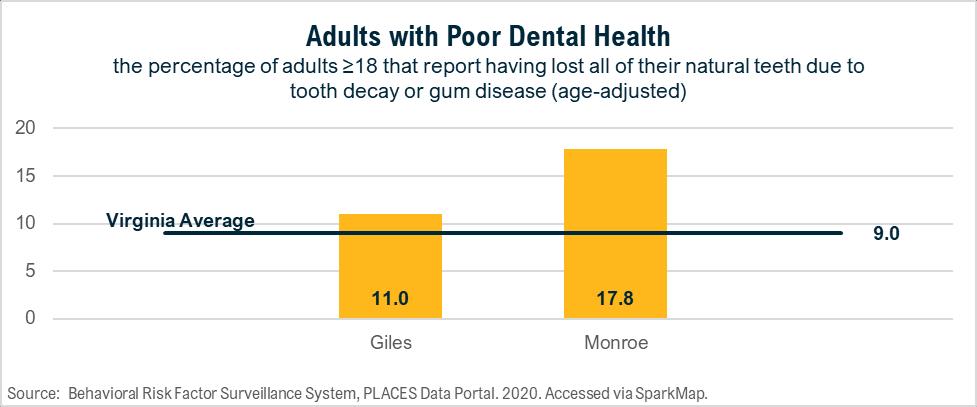
13 https://health.gov/healthypeople/objectives-and-data/browse-objectives/oral-conditions
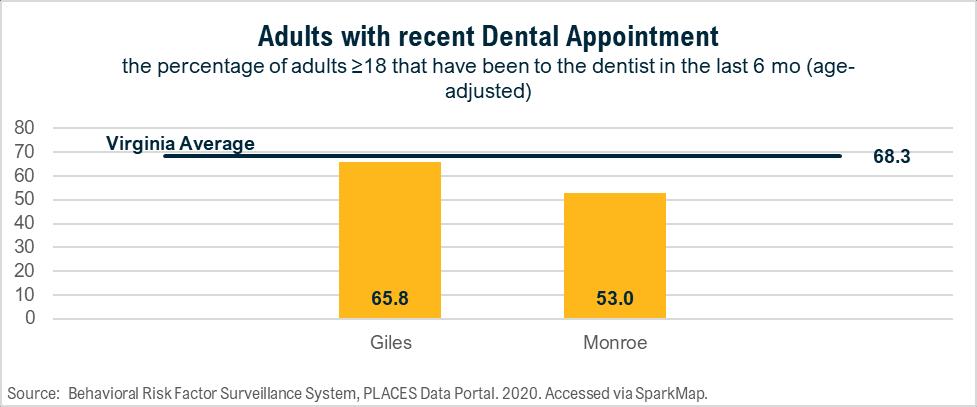
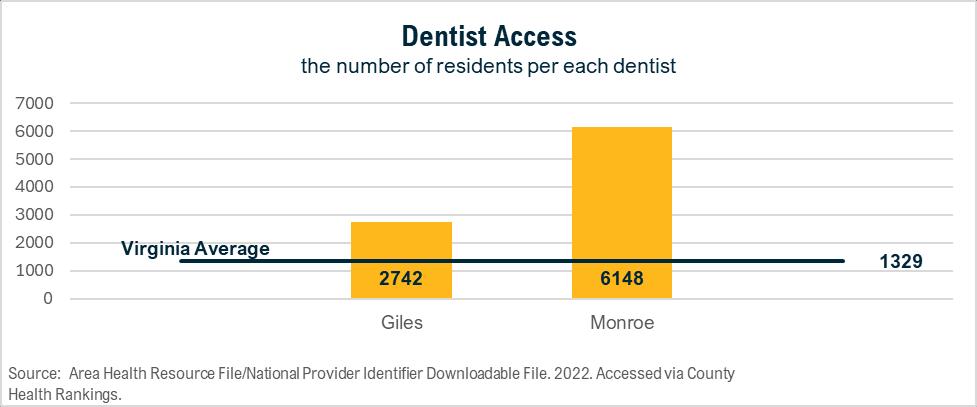
The Giles CHAT decided to combine efforts with the NRV CHAT for a regional response to dental health needs. During the NRV final CHAT meeting, community partners identified many key drivers of dental health problems, including lack of providers accepting Medicaid, provider office hours, lack of awareness/education, lack of providers, affordability, insurance availability and generational/cultural habits.
Resources Available
A detailed list of community partners is available in Appendix G. Key resources to address dental health in the Giles Area include:
• Preventative and reactive treatment services
• School dental screenings
• PATH (NRV Partnership for Access to Healthcare)
Carilion Giles Community Hospital Health Improvement Strategy
As we continue to work with community partners, we will develop a Community Health Improvement Plan for the Giles Area, with expected completion before the end of calendar year 2024. Key focus areas will include not only the priority health outcomes, but also cross-cutting ways to address those outcomes by improving access to care and addressing SDOH.
Carilion will also participate in planning processes with other community coalitions and networks as applicable to address health needs in conjunction with a hospital-specific plan.
Health Needs Include requisites for improvement of maintenance of health status in particular parts of the community.
F Identify resources potentially available to address them.
Solicit and take into account input from persons representing the broad interests of the community, including those with special knowledge of public health.
Include all of the following sources to Identify and prioritize significant health needs and identify potentially available
Description of process and methods used to conduct the CHNA. 6-12
Description of how broad-interested community input was solicited and taken into account. 8-12
Description of the process and criteria used to identify needs as significant. 12, Appendix F
Prioritize the significant needs. Appendix F
Description of resources potentially available to address identified significant health needs. 18, 21, 23, 25 Appendix G
Evaluation of impact of actions taken to address previous CHNA-identified significant health needs. 14
Describe the data and other information used in the assessment. 16-26, Appendix H
Describe the method of collecting and analyzing this data and information. 6-12
Identify any CHNA- related collaborative or contracted parties n/a
Describe how Carilion takes into account input received from persons representing broad interests of the community: Input provided. 8-12 How and over what time period input provided. 8-12
Name, nature, and extent of organizations providing input. 5, Appendix B
Describe medically underserved, low-income, or minority populations being represented by those providing input. 9, Appendix B
Adopted by Board 2
Participant Organization Type
Allison Patrick Veteran's Services
Andi Golusky
Children's Violence Prevention Resources
Andy Wilburn Transportation
Ann Goette
Children's Education/Reading Access
Anne Spangler Agency on Aging
Ashley Hash
Beverly Hill
Bobby Lilly
Organization Name
Virginia Department of Veterans Services
NRV Cares
Giles Health and Family
Giles Early Education Project
NRV Agency on Aging
Community Health Improvement - Carilion Carilion Community Benefit
Public Health - Local Health District
Commonwealth's Attorney
Brittany Long Agency on Aging
Caroline Jones Public Health (Student)
Caryl Allen County Administration
Cayla Trueheart Public Health - Local Health District
Charlie Herbert Food Access
Chris McClarney County Administration
Christien Poe
Public Health - Local Health District
Dana Carhart Public Health (Student)
Deanna Williams
Emil Morris
Domestic Violence Resources
Emily Moye Cooperative Extension (FNP)
Erica Short
Helen Wallace
Holly Lesko
Holly Otsby
Public Health - Local Health District
Adult & Child Day Care/Transportation
Economic Development
New River Health District (NRHD)
Commonwealth's Attorney Office
NRV Agency on Aging
Virginia Tech
Giles County Administration
New River Health District (NRHD)
Giles Community Garden
Giles County Administration
New River Health District (NRHD)
Virginia Tech
Women's Resource Center NRV
VA Cooperative Extension
New River Health District (NRHD)
Giles Health and Family
NRV Regional Commission
Community Health Improvement - Carilion Carilion Community Benefit
Jeff Dinger County Administration
Jennifer Darnell Public Health - Local Health District
Jesse Glover Public School - K-12
Jessica Wirgau Philanthropy/Community Development
Jim Nelson
Healthcare - Monroe Health Center
John Hale County Administration
Jon Butler County Administration
Joshua McDonald
Katie Stinnett
Veteran's Services
Public Health - Local Health District
Kim Snider Agency on Aging
Kinsey Weaver Economic Development
Kristie Williams
Healthcare - CGCH
Lesia Palmer Food Access
Margaret Hurst Early Childhood Network Development
Mike Evans County Administration
Molly Buckwalter-Fairfield Low-Income Community Resources
Molly Roberts
Giles County Administration
New River Health District (NRHD)
Giles County Public Schools
The Community Foundation of the NRV
Monroe Health Center
Giles County Administration
Giles County Administration
Virginia Department of Veterans Services
New River Health District (NRHD)
NRV Agency on Aging
NRV Regional Commission
Carilion Giles Community Hospital
Giles County Christian Service Mission
First Steps NRV/CFNRV
Giles County Administration
New River Community Action
Community Health Improvement - Carilion Carilion Community Benefit
Participant Organization Type
Morris Fleischer Faith Community
Organization Name
Giles Ministerial Association
Nick Bilbro Community Health Improvement - Carilion Carilion Community Benefit
Noelle Bissell Public Health - Local Health District
Pam Ray Public Health - Local Health District
Patty Hall Domestic Violence Resources
Samuel "Lakin" Barnes Health Education - Carilion
Sheri Nipper-Williams Department of Social Services
Stephanie Spencer Health Education - Carilion
Susan Dalrymple Cooperative Extension (FNP)
Suzanne Woodward Public School - K-12
Tamy Mann Victim Advocacy Resources
Tanya Patteson Public School - K-12
Walter Midkiff Economic Development
Zaria Solk Public Health - Local Health District
New River Health District (NRHD)
New River Health District (NRHD)
Women's Resource Center NRV
Carilion Community Health and Outreach
Giles County DSS
Carilion Community Health and Outreach
VA Cooperative Extension
Narrows High School
Giles Victim Witness
Narrows High School
NRV Regional Commission
New River Health District (NRHD)
Appendix C: Community Health and Well-Being Survey
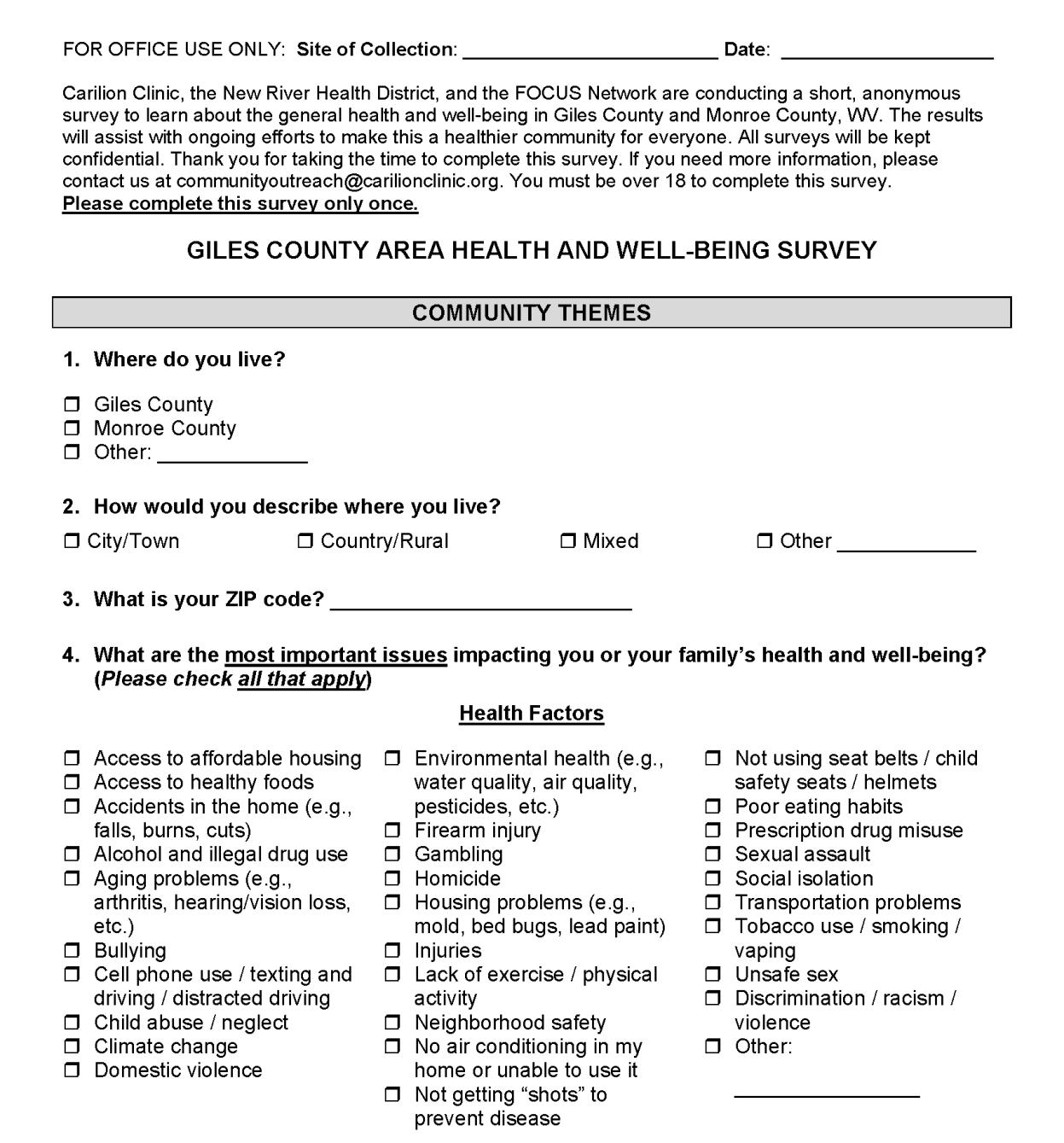
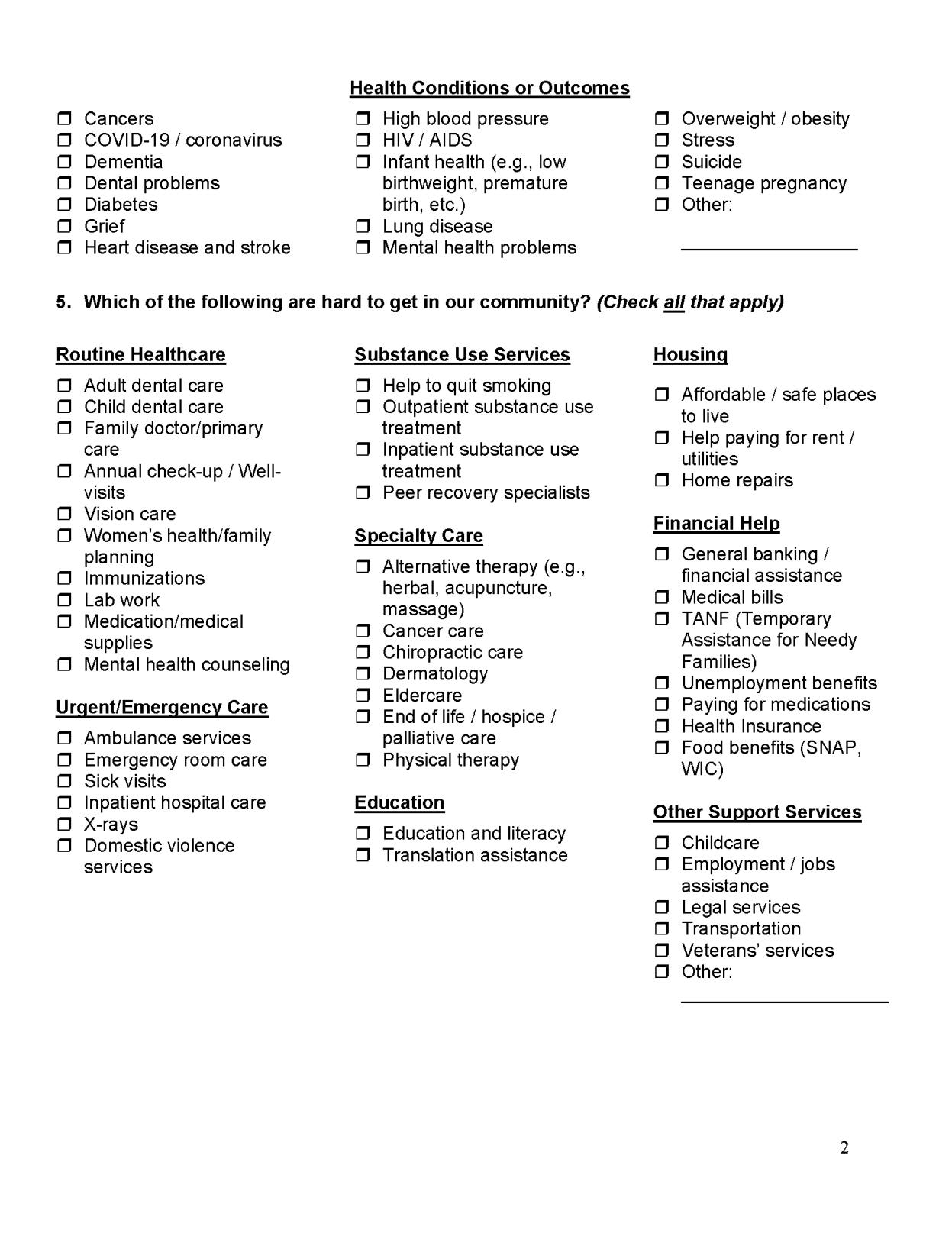

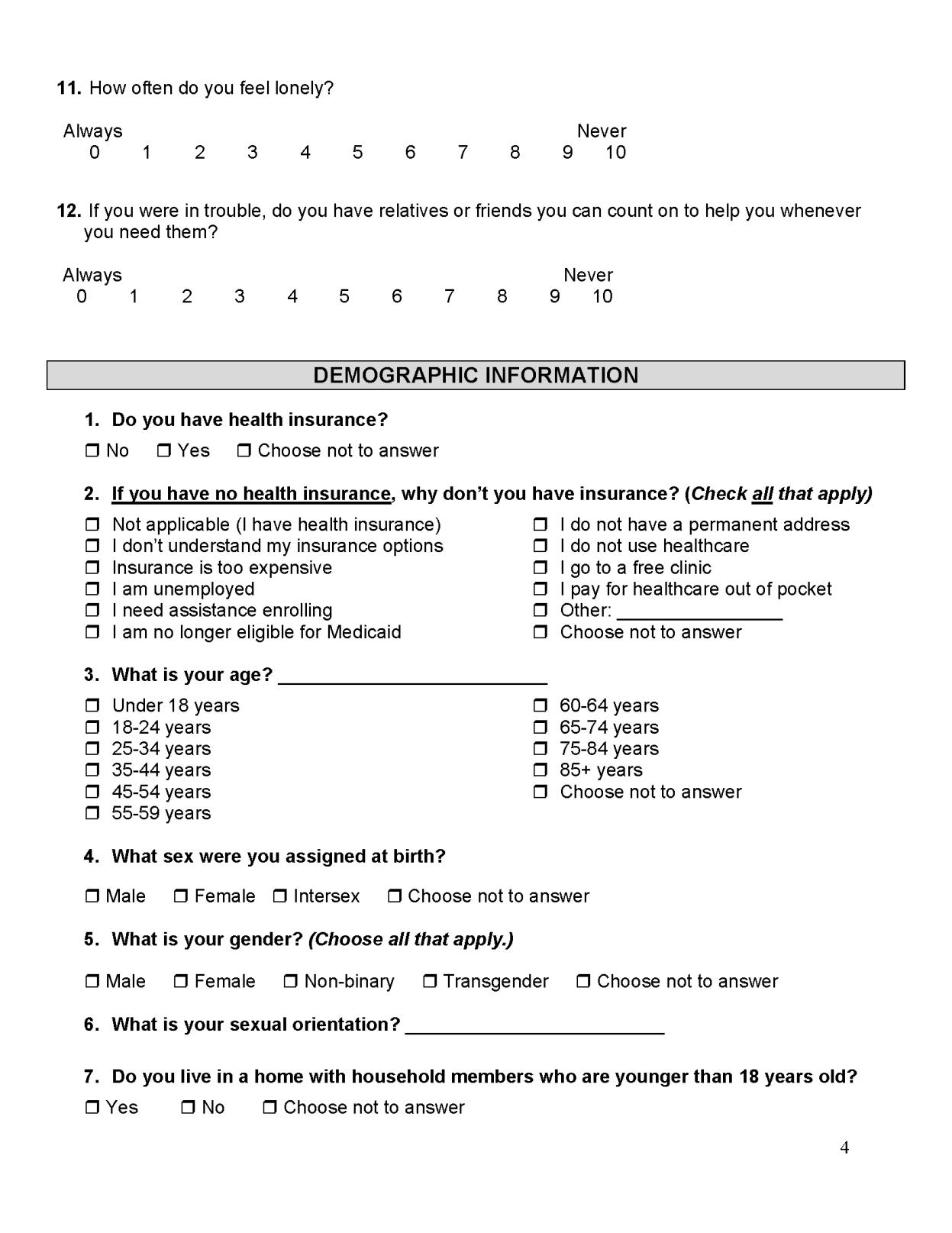

Due to the nature of the Community Health and Well-Being Survey and its public availability through online methods, data validation was necessary. To validate survey responses, data was filtered by zip codes within Carilion’s entire service area. These responses were used for further data analysis.

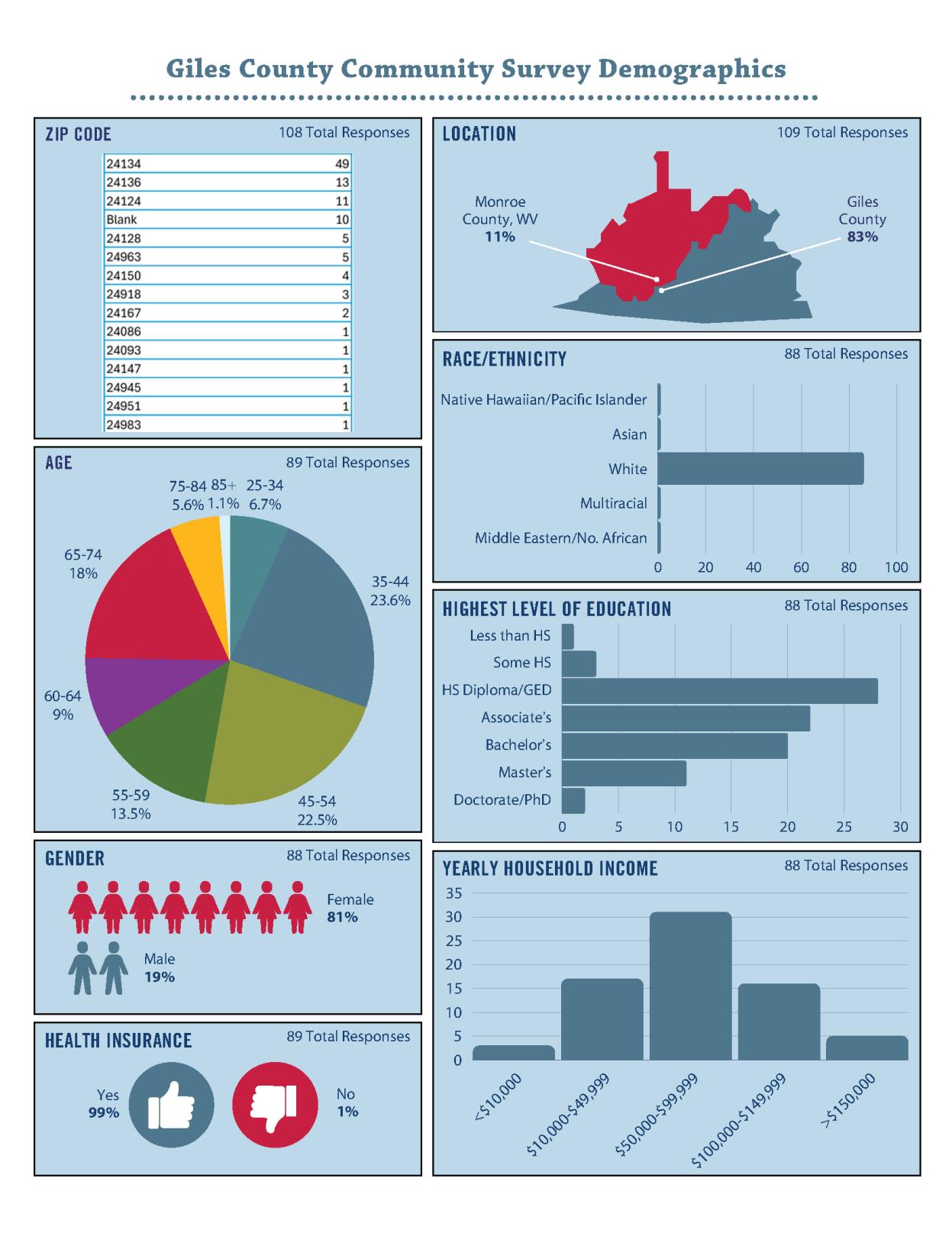



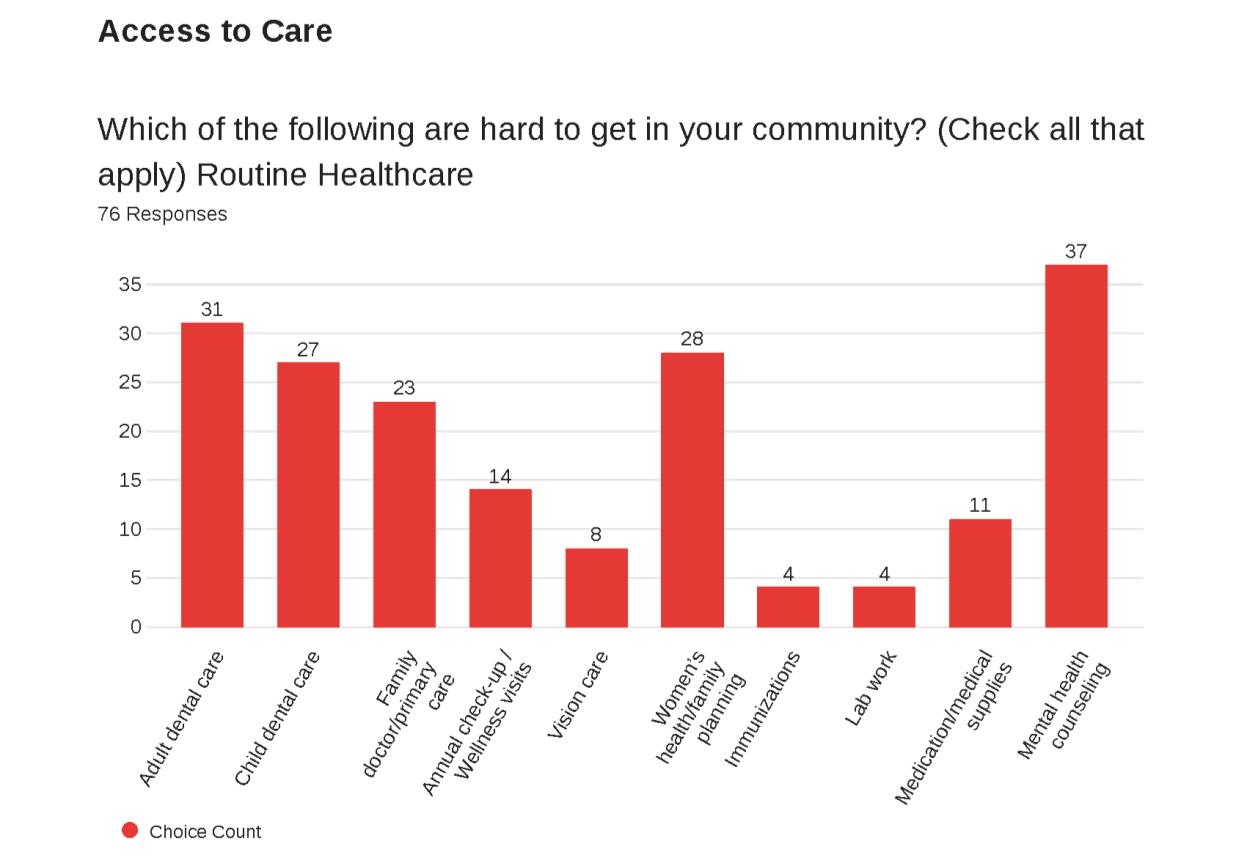

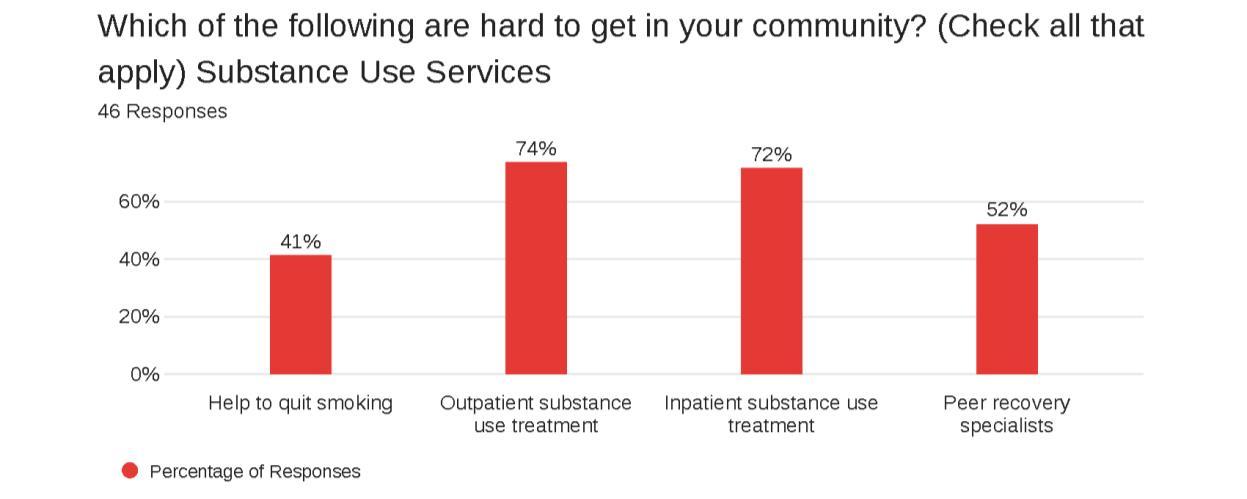




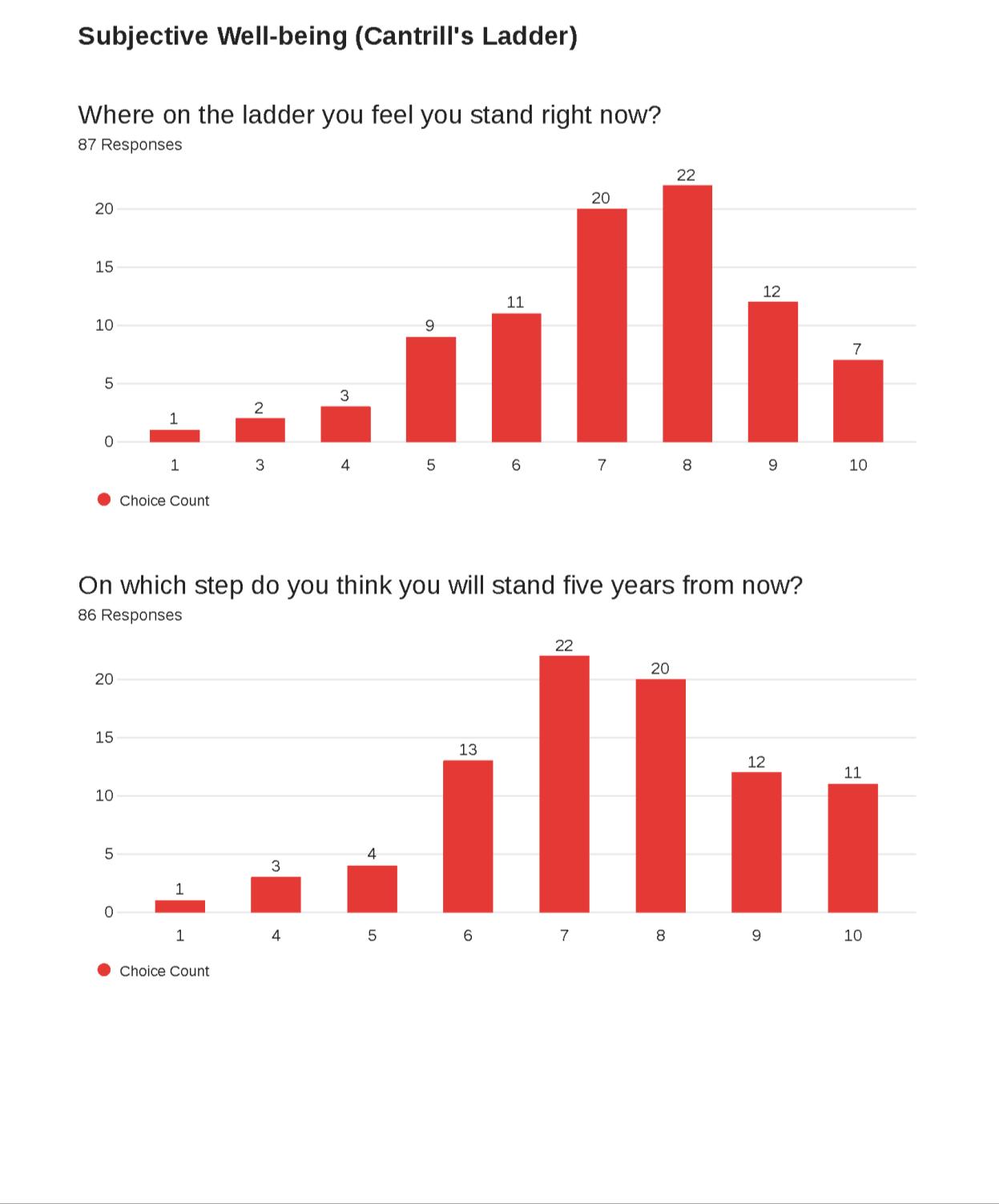
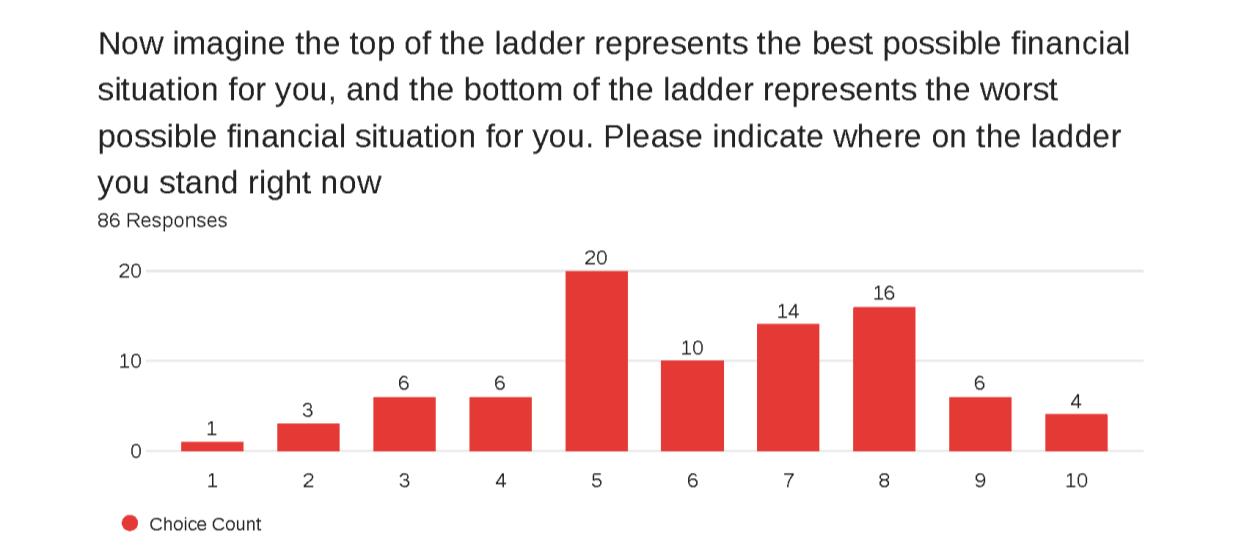
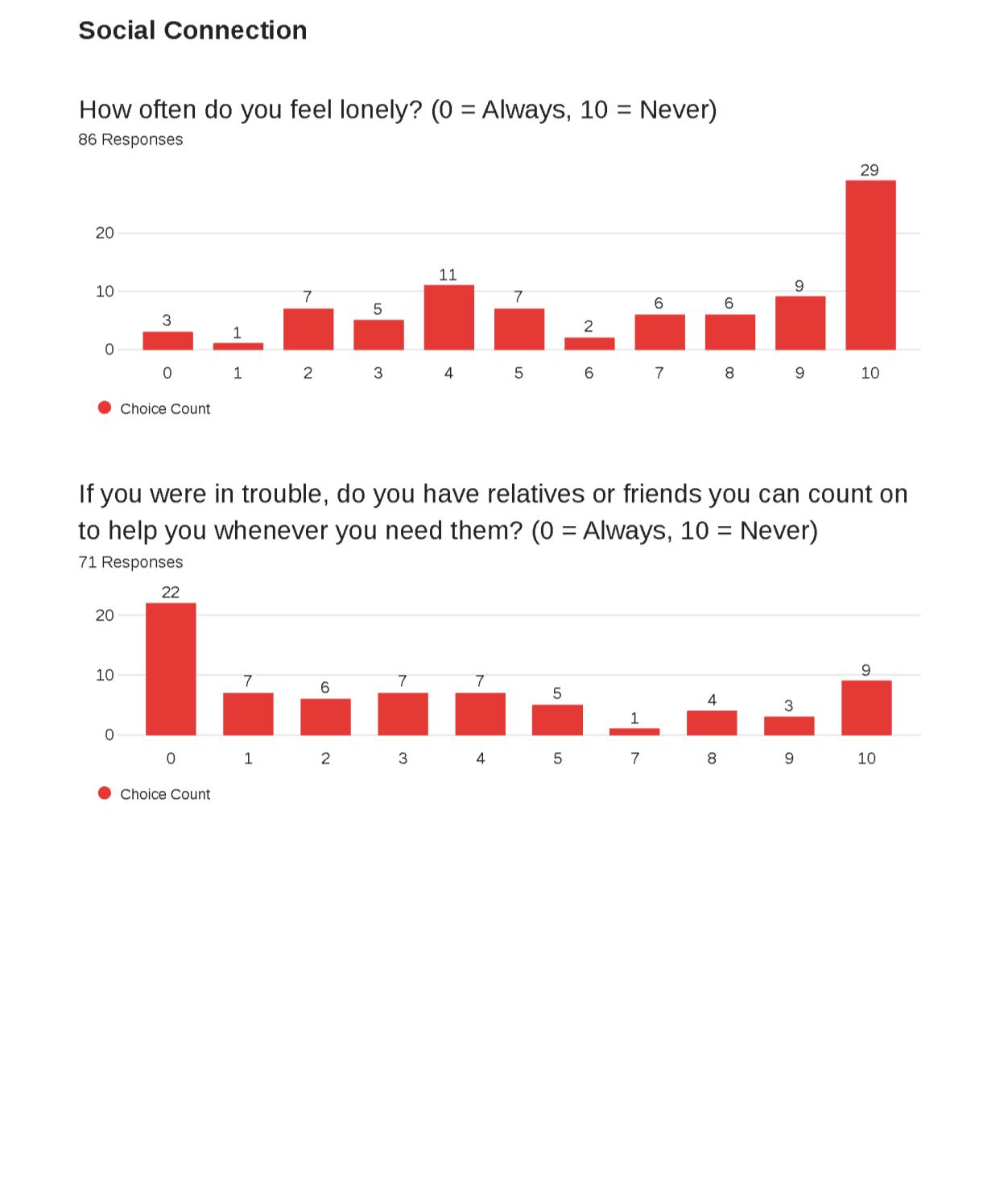
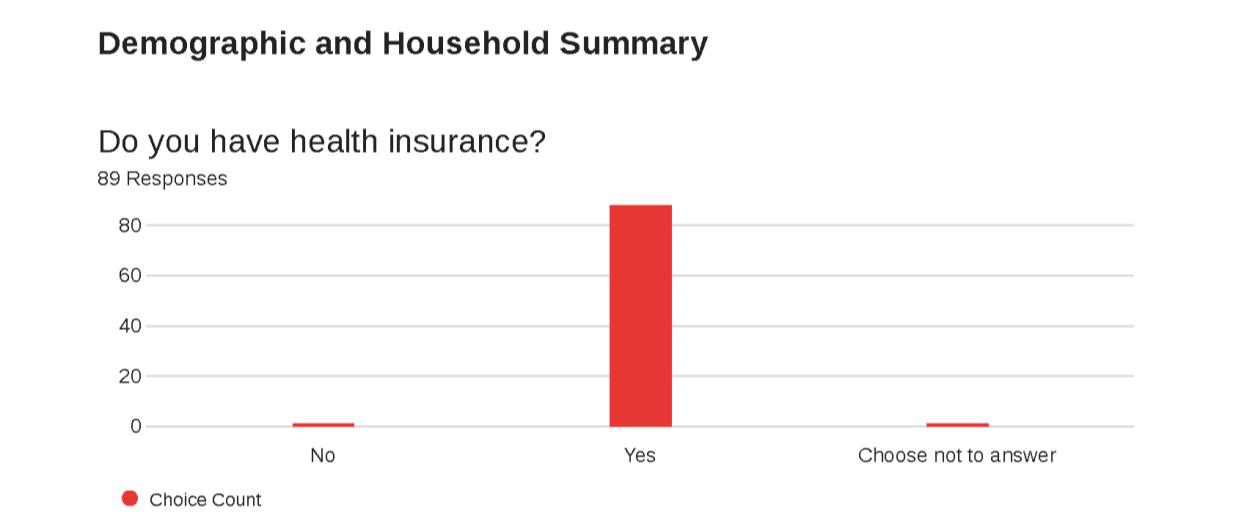
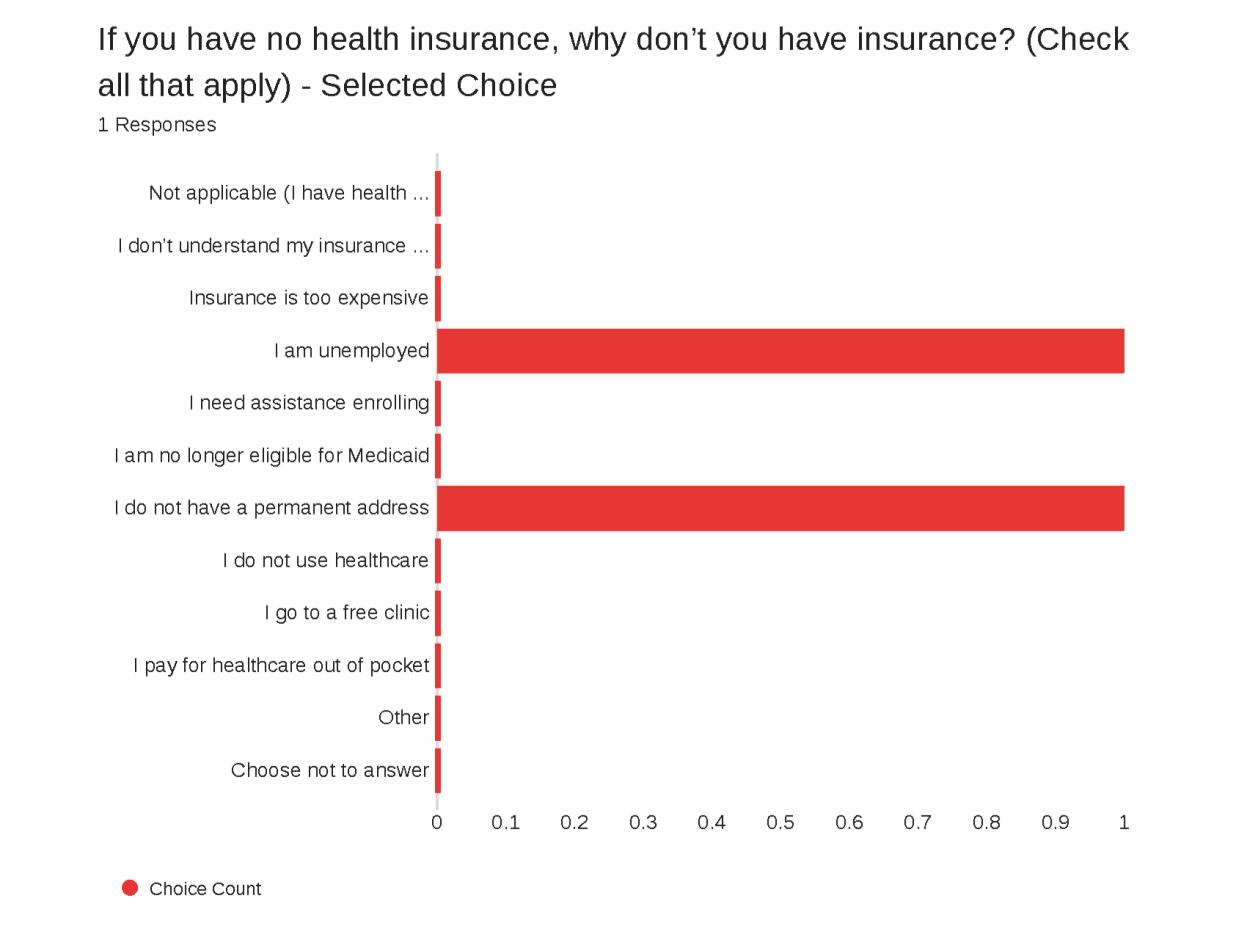




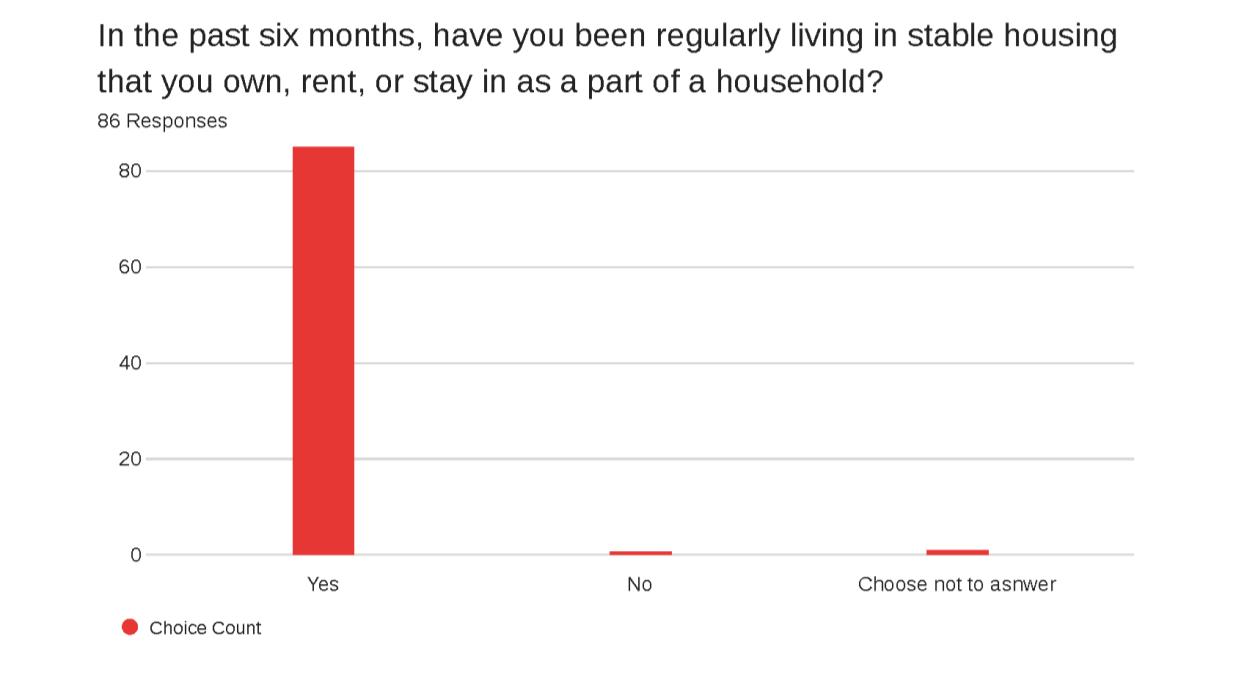
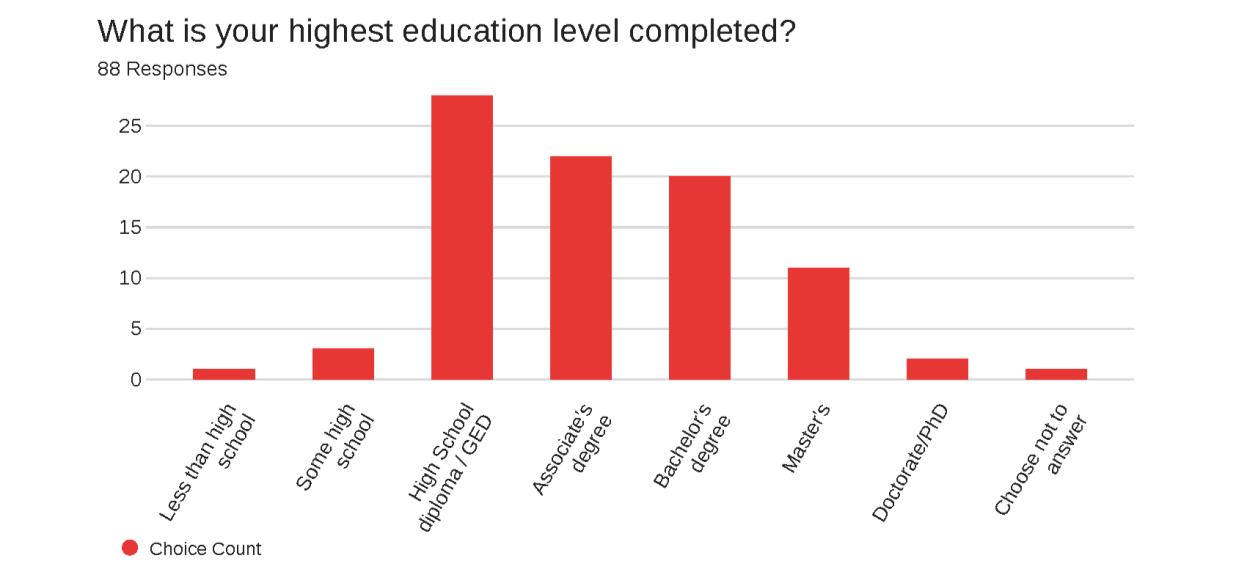






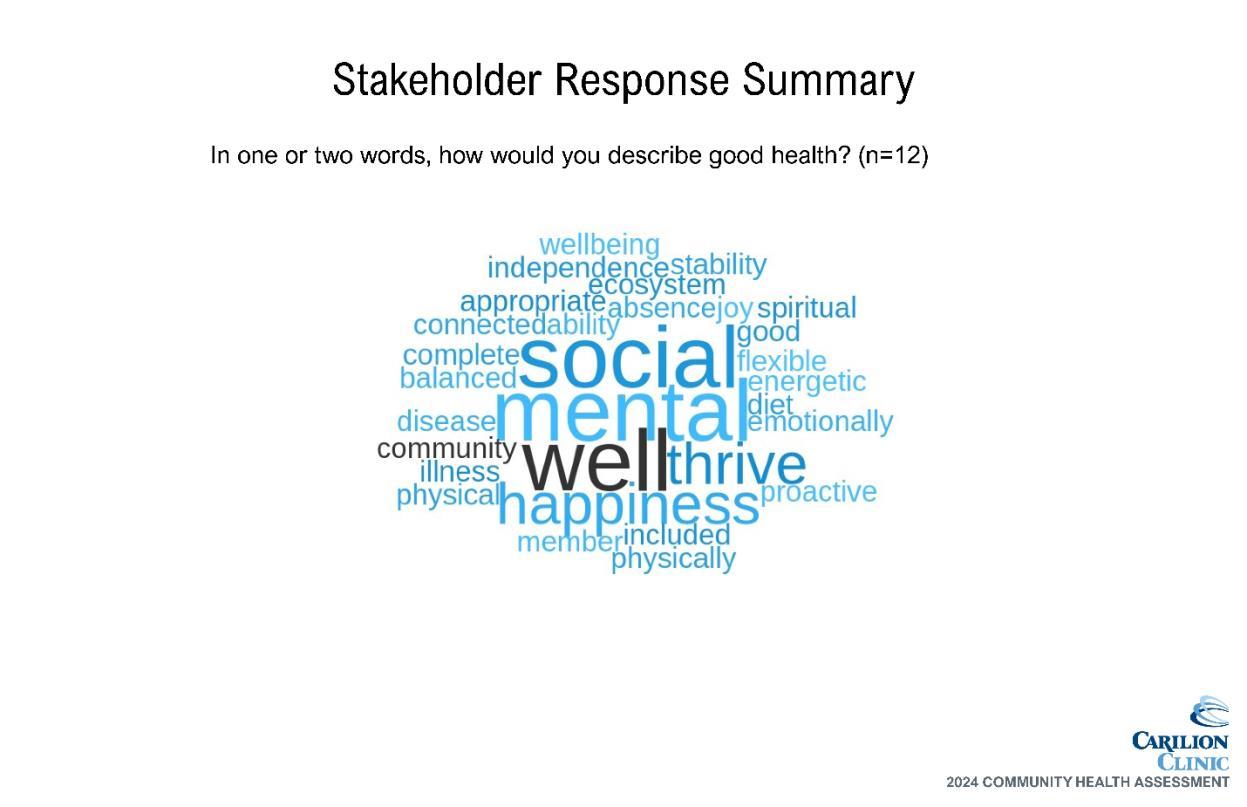
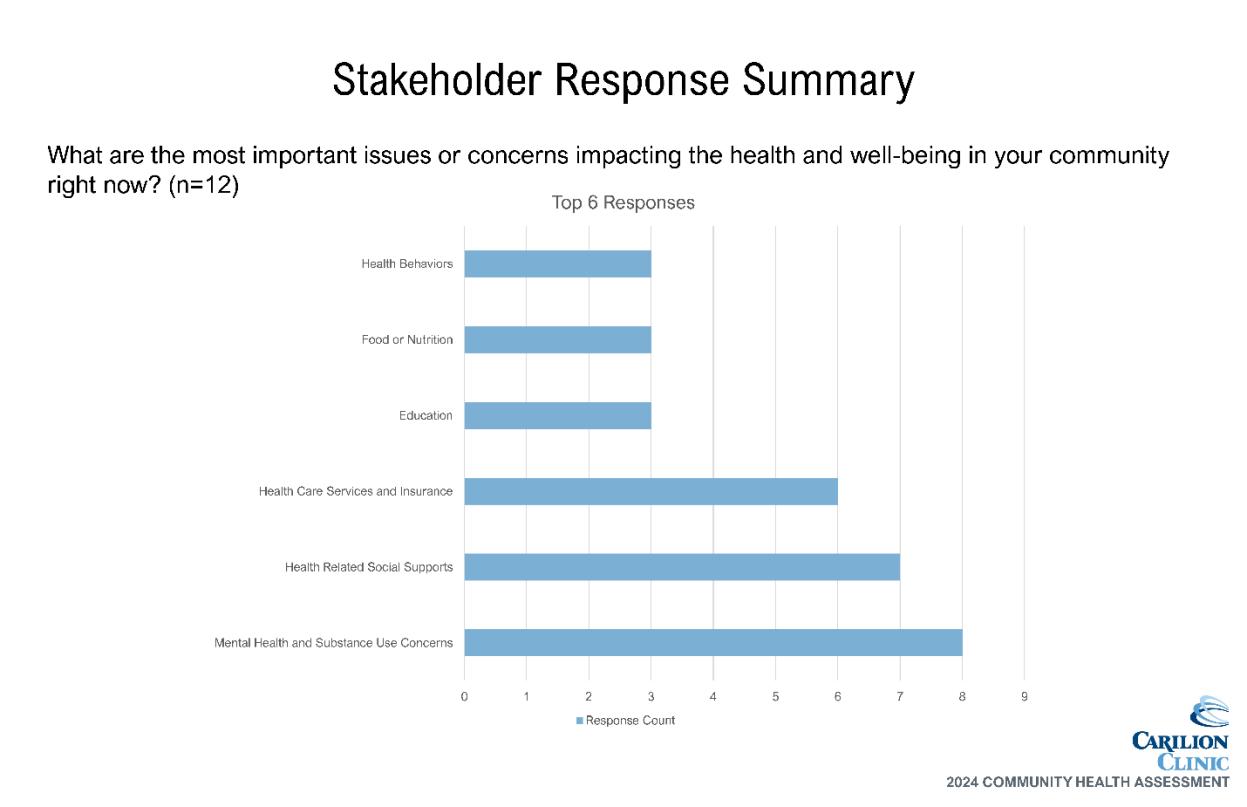
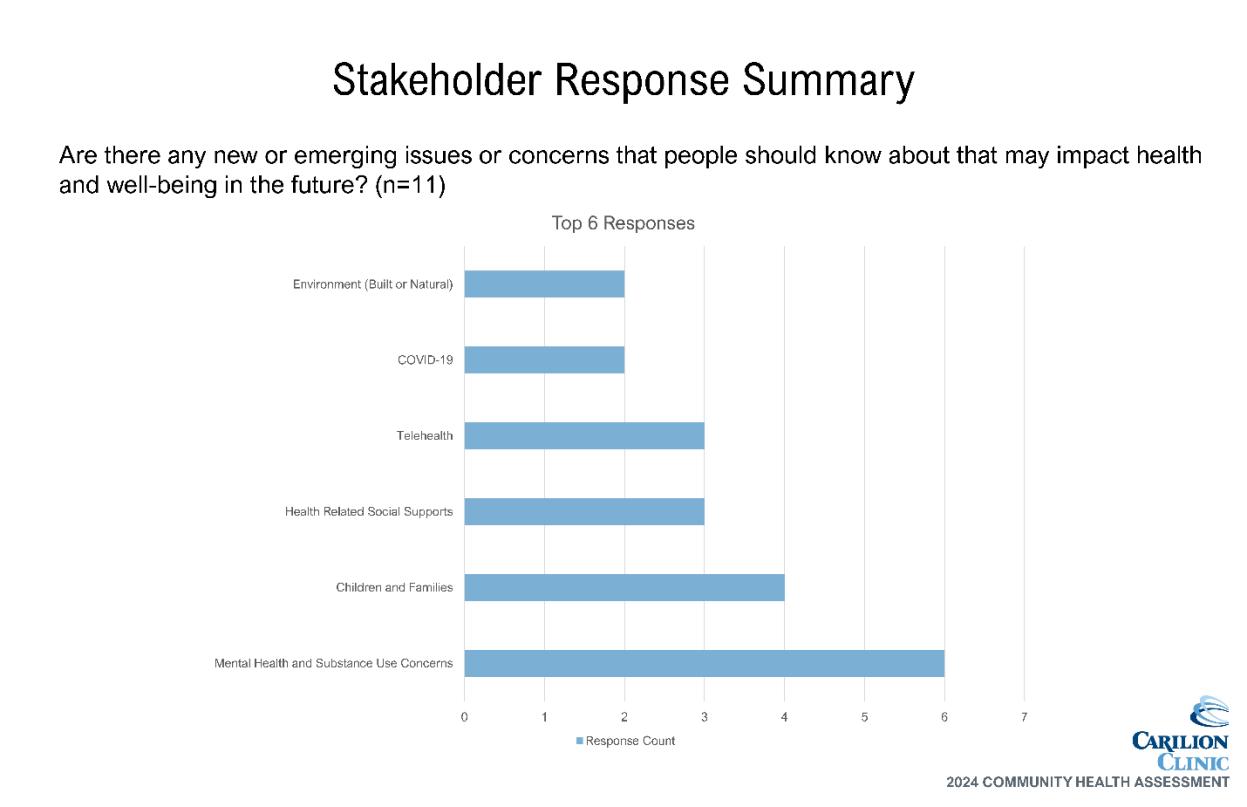



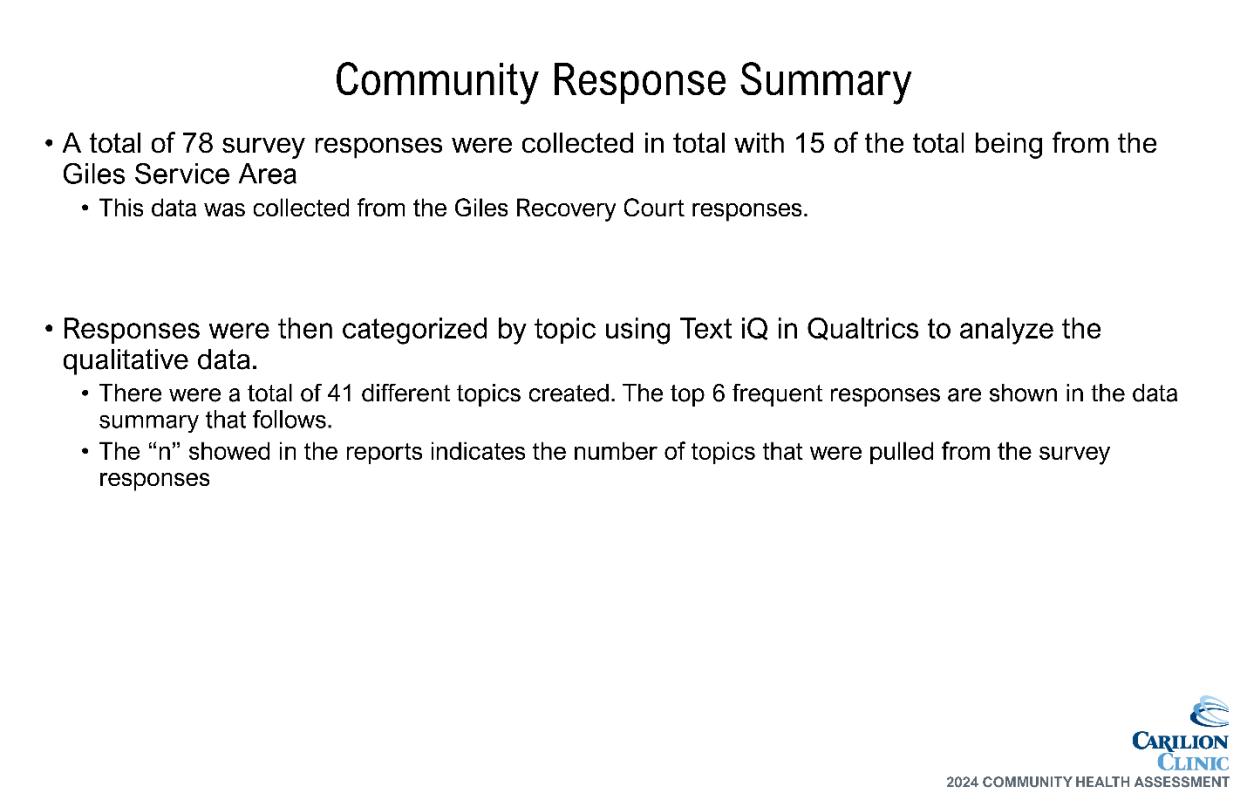
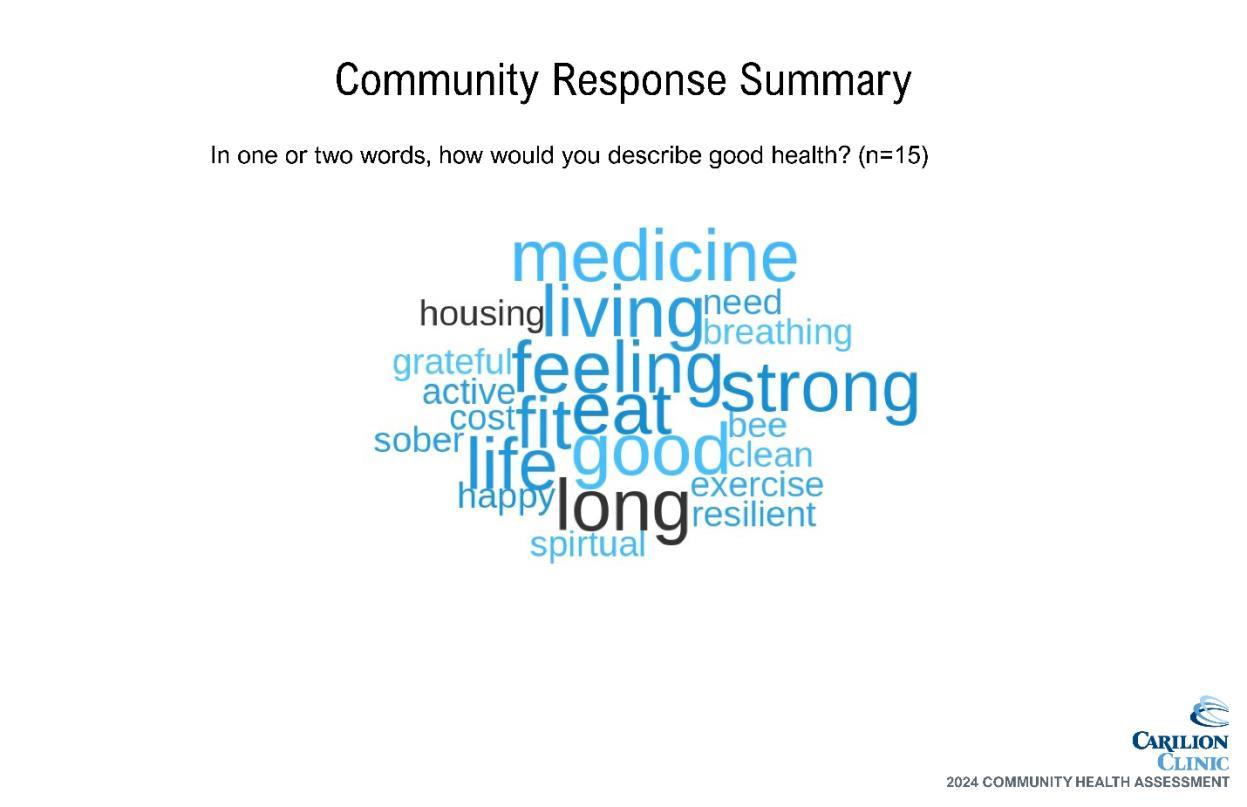
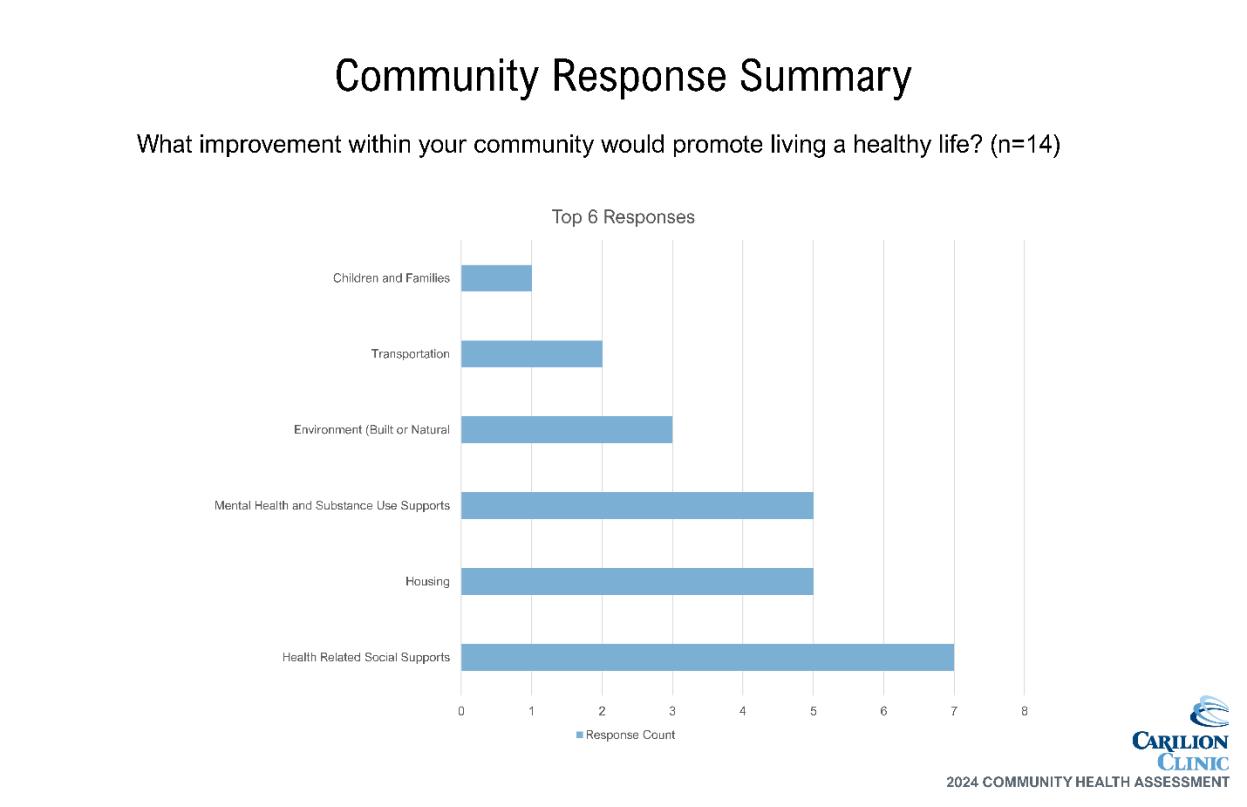





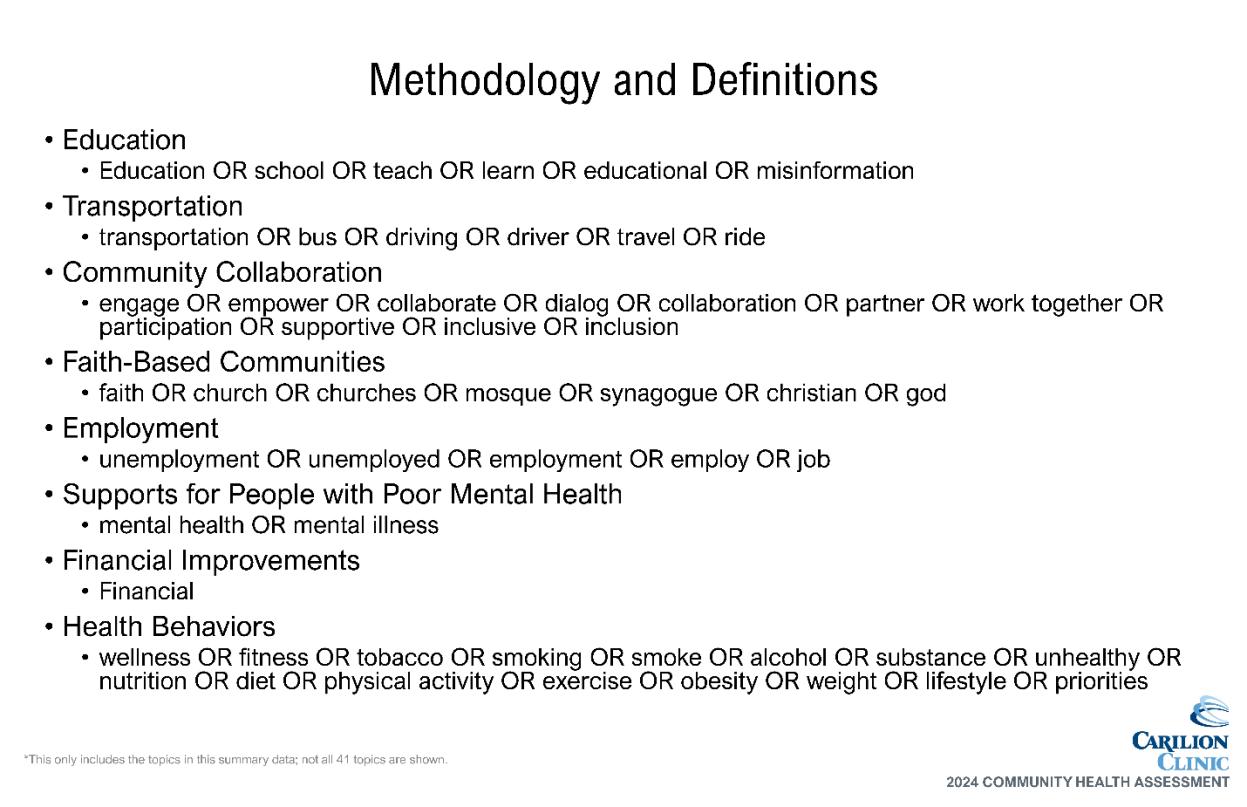

Using their community knowledge, data collectively reviewed, and additional data shared, CHAT members were asked to complete an electronic survey to prioritize community health topics:
• The survey matched the structure utilized during the data walk at CHAT Meeting 2
• First prioritized broad categories, then specific topics within those categories
• CHAT facilitators ranked the following to develop results:
o Broad categories (resulting top 3 indicated by bold type below)
o Topics within each of the 3 top broad categories
o Remaining topics
• Results include:
o Top 3 topics of each of the top 3 broad categories
o Top 5 topics of the remaining categories
Mental Health/Substance Use
• Substance use
• Poor mental health
• Overdoses Chronic Disease
• Overweight/obesity
• Heart disease
• Poor dental health Injury/Violence
• Firearm injuries/deaths
• Domestic violence/intimate partner violence
• Motor vehicle crashes
• Childhood injury
Maternal/Child Health & Infectious/Communicable Disease
• Teen pregnancy
• Infant mortality
• STIs
• Hepatitis C
Using the results of the Prioritization Survey, the group was asked to individually choose 5 topics to prioritize:
• The CHAT facilitators hung pages around the meeting room, each with one of the topics from the Prioritization Survey results.
• Each CHAT meeting attendee was given 5 dot stickers and instructed to place one sticker on each of the 5 topics they felt were most important to address in the next three years.
• After voting was completed, the CHAT facilitators quickly tallied and ranked the results.
• The CHAT was presented with the top 5-7 topics, unranked. The number of results presented depended on any ties and how closely votes were distributed. If topics were additional (i.e. not in the true top 5), CHAT facilitators noted this to the group and separated them visually on the screen.
Top 5:
• Substance use
• Mental health
• Overweight/obesity
• Heart disease
• Domestic violence/intimate partner violence
Additional:
• Overdoses
• Poor dental health
The group was asked to reflect on the results of the dot voting exercise. The following points were made during that discussion:
• “Mental health” vs. “Substance use” vs. “Overdose”
o Substance misuse often cooccurs with undiagnosed mental health disorder(s)
o Victims of violence often use/misuse substances to cope.
o Importance of addressing stigma
• Important to include “intimate partner violence” not just “domestic violence”.
• “Overweight/obesity” & “Heart disease” vs. “Chronic disease”
o Drill down to what is actionable?
o How far do we want to go as a community?
• Many of these are interrelated and closely connected to social determinants of health transportation was discussed specifically.
Top 5:
• Mental health
• Substance use
• Chronic Disease (Overweight/obesity & Heart disease)
• Domestic violence/intimate partner violence
• Dental health
*Results are not presented in any ranked order.
Organization
Carilion Community Health and Outreach
Community HealthCarilion (540) 512-5200
Carilion Giles Community Hospital Hospital - Carilion (540) 921-6000
Carilion New River Valley Medical Center Hospital - Carilion (540) 731-2000
Community Health Center of the NRV Federally Qualified Health Center (540) 381-0820
Monroe Health Center Federally Qualified Health Center (304) 772-3064
New River Health District Local Health District (540) 585-3300
Chronic Disease Prevention Education
Stress Management Education
Emergency Care
Diagnostic and Treatment Services
Emergency Care
Diagnostic and Treatment Services
Disease Management Education (by physician referral)
Primary Health Care (w/Medicare, insured, & sliding scale)
Primary Health Care (w/Medicare, insured, & sliding scale)
Community Health Workers Prevention Education
Thrive NRV Network - Food Access https://cfnrv.org/thrive/ Food Assistance Directory
Virginia Cooperative Extension Cooperative Extension (540) 921-3455
MENTAL HEALTH AND SUBSTANCE USE
Community Health Center of the NRV Federally Qualified Health Center (540) 381-0820
New River Health District Local Health District (540) 585-3300
New River Valley Community Action Community Action (540) 394-3255
New River Valley Community Services Community Services Board (540) 961-8300
Resiliency Network
Virginia Cooperative Extension
Trauma Informed Community Network
Cooperative Extension
https://www.facebook.com/ NRVResiliencyNetwork/
Floyd: (540) 745-9307
Giles: (540) 921-3455
Mont: (540) 382-5790
Pulaski: (540) 980-7761
Wythe: (276) 223-6040
Giles Victim/Witness Victim/Witness Support (540) 921-2553
Giles County Department of Social Services Domestic Violence Services (540) 726-8315
New River Valley Community Services Community Services Board (540) 961-8300
Chronic Disease Prevention and Control Education Nutrition Education
Food Safety Education
Behavioral Health Care (w/Medicare, insured, & sliding scale)
Rise Above Mobile Unit (harm reduction services)
Blood-borne pathogen and STI testing Community Health Workers
Children's Health Improvement Program (CHIP) Home Visiting
501 Peer Center
RAFT Crisis Hotline: (540) 961-8400
Behavioral Health Care (w/Medicare, insured, & sliding scale)
Group Trauma Informed Basics Training (cost-free)
Stress Management Education
Child Development/Parenting Education
Family Financial Education
Victim/Witness Advocacy & Support Violence/Crime Awareness
Virginia Domestic Violence and Sexual Assault Hotline: 1-800838-8238
Domestic Violence Prevention Program
Protective Services (Child, Adult)
RAFT Crisis Hotline: (540) 961-8400
Organization Organization Type Contact
NRV CARES
NRV Resiliency Network
Child Advocacy (540) 381-8310
Trauma Informed Community Network
https://www.facebook.com/ NRVResiliencyNetwork/
Women's Resource Center of the New River Valley Domestic Violence Services (540) 639-9592
Community Health Center of the NRV Federally Qualified Health Center (540) 381-0820
PATH (Partnership for Access to Healthcare)
Network - Healthcare Access
https://www.vdh.virginia.go v/new-river/path/
Child Advocacy - CASA (Court Appointed Special Advocates)
Parenting Education
Child Abuse Awareness and Prevention Education
Group Trauma Informed Basics Training (cost-free)
24/7 Crisis Hotline: (540) 639-1123
Emergency Advocacy
Emergency Shelter
Healthy Relationships Education
Primary Dental Health Care (w/Medicare, insured, & sliding scale)
Community Dental Screenings
Community Dental Care Advocacy
Appendix H: Data Packets
The following pages include secondary data shared with the CHAT as well as chronic disease hospitalization data access through the Virginia Hospital and Healthcare Association (VHHA) Analytics data portal.
Key Takeaways- Secondary Data shared with the CHAT for Data Walk
Leading causes of death (2018-2021); generalized across service area
1. Diseases of the heart
2. Malignant neoplasms
3. Accidents (unintentional injuries)
4. Chronic lower respiratory diseases
5. Cerebrovascular diseases
Mental Health/Substance Use
• Giles County overdose death rates are more variable than state average, likely due to small population size. Decreased from 2020-2021.
• Hospitalization rates and ED visits for overdose consistently higher than state average
Maternal/Child Health
• Teen birth rates are about twice that of the state for both Giles and Monroe
• Percentage of moms smoking during pregnancy is high
Injury/Violence
• Rate of fatal car crashes occurring IN Monroe County is high, more than double the Virginia rate
Infectious/Communicable Disease
• STIs (chlamydia, gonorrhea, syphilis) lower in both localities than the Virginia rate
• Rate of new diagnosis of hepatitis C infection is higher in Giles than VA, no data for Monroe at this time
Chronic Disease
• New lung cancer diagnosis is higher in Giles County than Monroe and Virginia
• Chronic disease hospitalizations for hypertension and diabetes are much higher in Giles County than Virginia.

